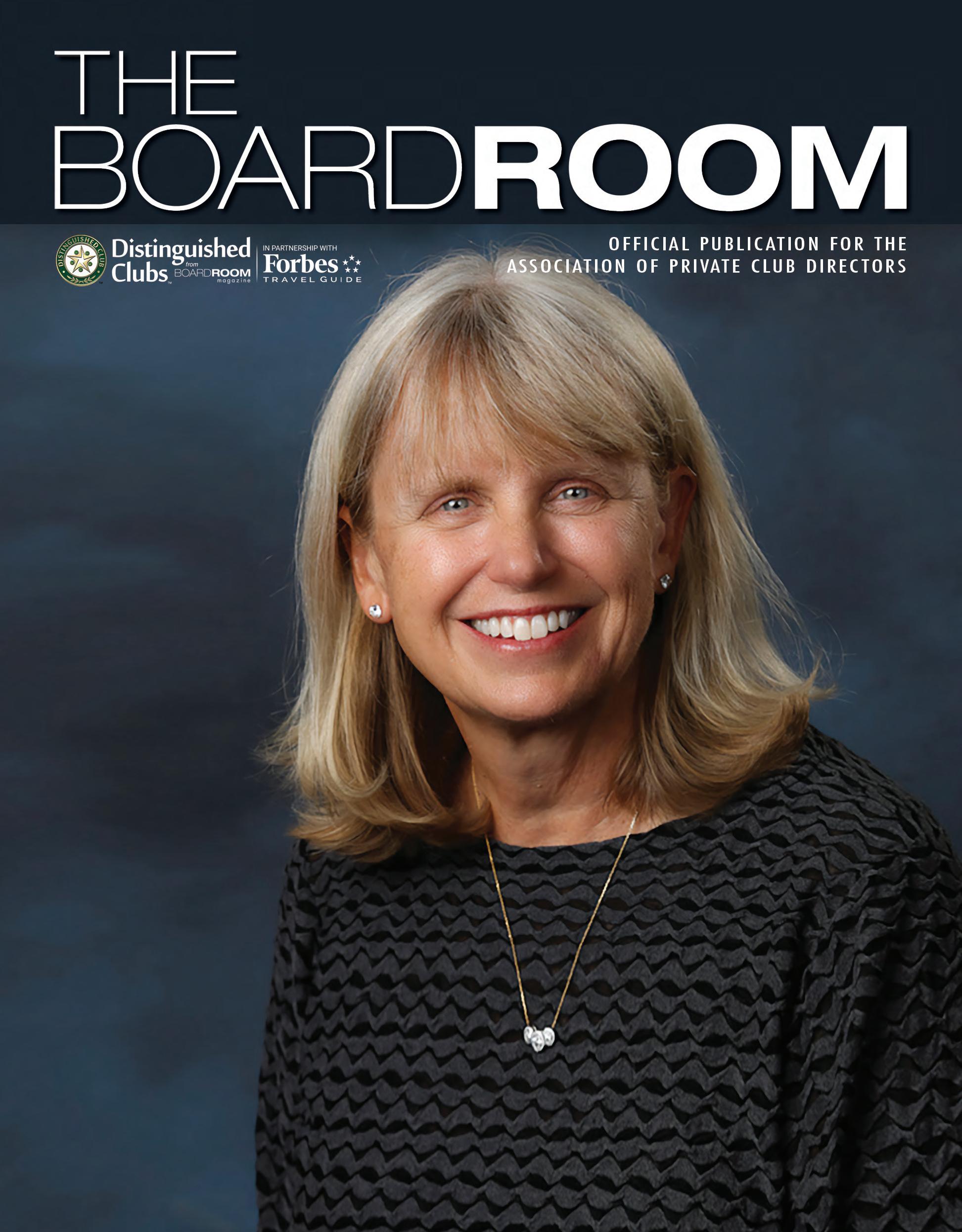



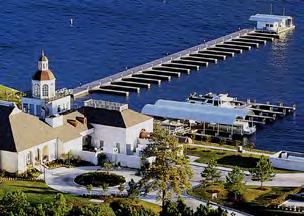

















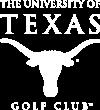


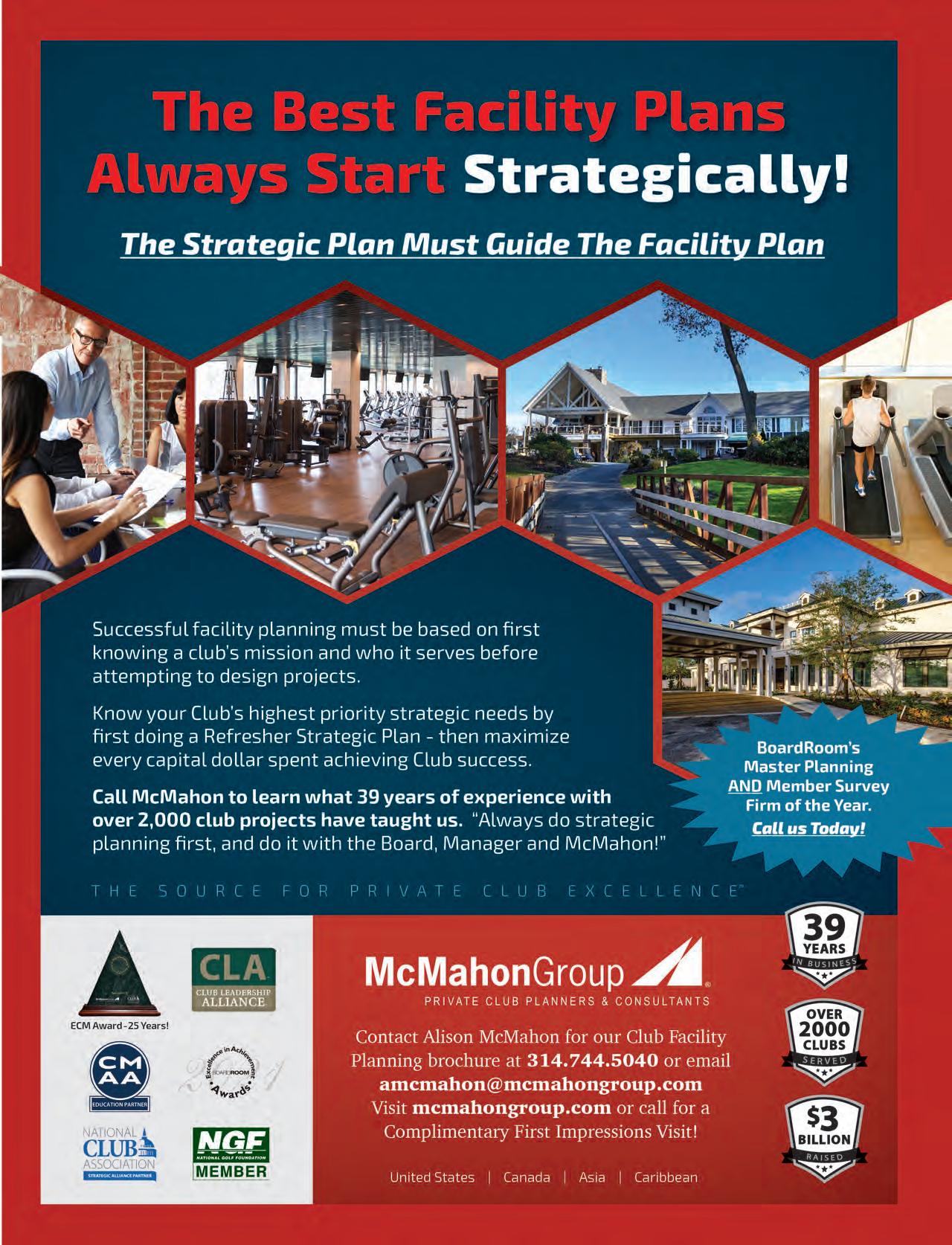
EDITOR’S NOTE
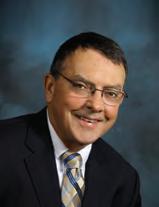
DAVE WHITE
Dave White is the editor of BoardRoom magazine. If you have comments on this article or suggestions for other topics, please send Dave an email to: dave@boardroommag.com.




























DAVE WHITE
Dave White is the editor of BoardRoom magazine. If you have comments on this article or suggestions for other topics, please send Dave an email to: dave@boardroommag.com.
As 2022 fades into history, it allows us to look at the ‘State of the Private Club Industry’ and some of the people who make it what it is.
That includes Diane Exter, president of Frenchman’s Creek Beach and Country Club, BoardRoom’s Distinguished Club President for 2022.
This marks the 15th year BoardRoom is recognizing 24 club presidents for their outstanding leadership and who have so wonderfully combined their efforts for the betterment of their club.
“This is an outstanding achievement for these private club presidents,” said BoardRoom’s publisher, John Fornaro. “We certainly recognize the work the presidents have done for their clubs.
“Volunteer boards of directors and club presidents must set the tone and tenor for what happens at their private club and it’s this vision and mission that BoardRoom recognizes with the top club president awards,” Fornaro added.
The club boards and presidents must have the vision and set policy for general managers, and it’s the general managers who must make that policy (along with their vision) work every day. Micromanagement be gone!
Our congratulations to our Distinguished Club President, Diane Exter and the other 23 Club Presidents of the Year.
Both have a long history of accomplishments in the private club industry and are well-deserving recipients of these Lifetime Achievement Awards.
Other award winners of note are Gary Player Educator of the Year: Mindful’ U (Rick Ladendorf and Craig Marshall), and Ryan Doerr of Strategic Club Solutions; Dave White Editorial Awards: Dave Doherty of ISTRC, a long-time contributor to our BoardRoom magazine Green Committee section; John Fornaro Industry Impact Award: Robert DeMore, Private Clubs, Troon and Carman, Mauceri, GM/COO, The Club at Mediterra, Naples, FL; Jay DiPietro Vendor of the Year Award: XHIBTZ Contract Furnishings
n n n
The genesis for John Fornaro’s Publisher’s Perspective –How Do You Get Your Board to Approve What Needs to be Done? – interestingly enough derives from another story in this issue... Robert Sereci’s The Knowing Versus Doing Dilemma
“Simply stated, it’s not a knowing problem – it’s a doing problem,” says Sereci.
“Boards are notorious for ignoring an issue and doing nothing until you know what hits the fan and then they go full tilt overnight. This strategy doesn’t work in our daily lives, and it doesn’t work in clubs.”
Our “Excellence in Achievement” Awards are the only private club industry awards recognizing the clubs’ business partners. And our BoardRoom 2022 “Excellence in Achievement” Award recipients receive their due in this issue for their achievements.
BoardRoom magazine’s industry peers review and select these outstanding suppliers and consultants, representing various aspects of course and club operations.
Winners each year are selected for overall excellence, achievements, innovation, vision for future growth, and continued impact on private club operations in their respective fields.
Kudos this year to Kevin Reilly of PBMares and Dan Denehy, President of Denehy Club Thinking Partners, who are being acknowledged with BoardRoom magazine Lifetime Achievement Awards.
So, in developing his Publisher’s Perspective, Fornaro asks these questions: How do we get private club boards of directors to approve actions needed at private clubs? Why does the decision-making process often get stuck in a quagmire when decisions are so apparent?
Our contributors to Fornaro’s article give us a variety of viewpoints on how, what and why club boards of directors make their decisions and what boards need to do to find their road map to success.
John and Robert Sereci offer some definitive takeaways that can help lead to future success. Excellent reads! BR
Publisher/CEO
John G. Fornaro
Editor
Dave White
Chief Creative Officer
Heather Arias de Cordoba
Copy Editor
Chryssoula Filippakopoulos
Innovative Ideas Editor
Heather Arias de Cordoba
APCD Executive Director
Bill Thomas
Editorial & Marketing Director
Dee Kaplan
Business Development
Joshua Nuzzi
Accounting/Subscriptions
Ronni Dana
Contact Information
www.BoardRoomMagazine.com www.apcd.com (949) 376-8889
Featured Columnists
Rick Coyne
John G. Fornaro
Ted Gillary
Heather Arias
de Cordoba
Ronald Banaszak
Bruce Barilla
Nancy Berkley
Bill Boothe
Dr. Eric Brey
Dr. Jack D. Cichy
Dr. Ronald F. Cichy
Jarrett Chirico
Henry DeLozier
Bonnie J. Knutson
Nancy M. Levenburg
Ryan McAndrew
Contributing Writers Strategic Partners and Allied Associations


Dan Denehy
Dave Doherty
Pat Finlen
Keith Fisher
Steve Graves
Mark Gurnow
Angela Hartmann
Larry Hirsh
Ben Hopkinson
Dick Kopplin
Melissa Low



Co-Founder/CEO
Executive
Executive
Joshua Nuzzi

Gregg Patterson
Robert A. Sereci
Dave White
Dave Moyer
Mike Phelps
Whitney Reid Pennell
Ted Robinson
Corey Saban
Toni Shibayama
Robyn Stowell
Michelle Tanzer
Gordon Welch












RESPONSIVE US-BASED SUPPORT WITH HOSPITALITY EXPERIENCE
• Accounting (AR, AP, GL)
• Membership
• Golf Tee Times and Lottery
• Dining Reservations
• Racquets Management
• Fitness and Spa Booking
• Mobile App
• Food and Beverage POS
• Table Management
• Retail POS & Inventory
• And more

Cobalt has been an outstanding partner to Boca West since 2016. The quality of both their software and their support is exceptional. Cobalt's people are responsive and listen to our needs. Our members LOVE our mobile app, and staff learn the operations software quickly. Cobalt Software truly has what it takes to become a leading technology partner to the private club industry.
Matthew Linderman President, Chief Operating Officer



As we look back and mull over the state of the current industry, it is equally as important to look ahead. Our world has changed dramatically in terms of a divided country, financial woes, crime and poverty. Are private clubs insulated as we continue our journey into 2023 and beyond?

NANCY M. LEVENBURG
people are more likely to share a bad experience than a good one. And many restaurateurs these days are struggling to turn a profit between COVID-19, labor shortages, supply chain and food shortages, energy prices, and so on. It’s a bleak environment. So don’t let your “controllables,” like food quality, make it even bleaker.

As an executive coach, one of my main objectives is to help the client understand what is most important, to foster a curious mindset, and to ask the right questions. When embraced, the enjoyment experienced by the client with the “aha!” moment has its rewards and leads to thinking strategically. The reality is that a GM is paid to operate in the moment
BONNIE
J. KNUTSON
I honestly believe club managers are mostly unhappy because of the tension between what we want to do and what we are allowed to do and the tension between how we want to act and how we are told to behave. Finding a club culture that fits who
In the 19th century, merchants hired men to wear sandwich boards to promote their brand. From this meager beginning, marketing trends have evolved to leverage technologies and shift strategies to meet the needs of the marketplace. Originally, influencers were bloggers who shared their experiences…They were so-called regular people whose opinions were trusted.

GREGG PATTERSON
Novels are a treat to read and movies are a joy to watch. And the juiciest stories and the juiciest cinema often focus on weakness, temptations, human foibles and–The Seven Deadlies. Sloth. Gluttony. Wrath. Envy. Pride. Greed. Lust. Biblical stuff. Endlessly entertaining. Fun to read, to watch, to talk about. And avoid. MEMBERSHIP




By Henry DeLozier
Melissa Low

2021 By Heather Arias de Cordoba

Robyn Stowell
Ronald Banaszak
By Nancy Berkley
Gordon Welch

Bill Boothe
Dick Kopplin

PUBLISHER’S PERSPECTIVE

John G. Fornaro is the publisher/CEO of BoardRoom magazine, co-founder/CEO of Distinguished Clubs and the CEO of the Association of Private Club Directors (APCD). If you have comments on this article or suggestions for other topics, please contact John Fornaro at (949) 376-8889 or via email: johnf@apcd.com
“For many years, advisors have been educating club professionals and boards; however, if education alone was the solution, there should be a measurable improvement and that doesn’t seem to be the case.
“Why don’t club managers have these critical tools? I believe club professionals know what they should do but don’t know how to do it. Do club managers find it more challenging to find material about what to educate their board members, or is it finding a way to educate your board?
“Simply stated, it’s not a knowing problem – it’s a doing problem.”
Those are the words of Robert Sereci, GM of Medinah Country Club, in an article, “The Knowing Versus Doing Dilemma”, published in this issue of BoardRoom magazine.
“Boards are notorious for ignoring an issue and doing nothing until you know what hits the fan and then they go full tilt overnight. This strategy doesn’t work in our daily lives, and it doesn’t work in clubs.”
We often hear general and senior managers say, “I’m tired of all the seminars and educators saying we need a strategic plan, a master plan, surveys and much more. Most general managers know this!”
So, the question is: How do we get private club boards of directors to approve actions needed at private clubs? Why does the decision-making process often get stuck in a quagmire when decisions are so apparent?
“With revolving boards, constant turnover makes it a perpetual challenge to continually provide education about the best practices that allow a club to thrive,” said John Schultz, CEO of the Club Leadership Alliance, a partnership of three nationally recognized firms – Club Benchmarking, Kopplin, Kuebler & Wallace and the McMahon Group.
“Private clubs profit by providing compelling member experiences because, without them, revenue and capital aren’t there. Profit isn’t the bottom line as is in conventional business jargon.
“Board and committee members need to understand the unique aspects of the private club industry relative to their backgrounds, which are likely more corporate. They need to accept the need for ongoing education about the best practices and dynamics behind the successes of some clubs and failures of others,” Schultz added.
“They must embrace the industry data that illuminates these stories and keep up with the innovations and societal
trends that drive compelling member experiences. At CLA, we’re constantly exploring new ways to inform boards about the key dynamics that allow a club to thrive. There’s a plethora of information that reflects the best practices we endorse. I recommend that club boards take a strategic approach to governance that includes their committees, codifies best practices and focuses the board so that education is an ongoing part of the year in governance,” Schultz stressed.
“Most boards are made up of very successful business people and therefore, many are not excited about being ‘educated’ by club management and/or the industry experts,” explained Jim Butler, CEO of Club Benchmarking, a leading industry consulting firm that supplies business intelligence to private clubs.
“We believe the best practice of educating boards and board members is using a strategic agenda that makes ‘education’ an outcome versus an action item. The outcome of an educated board is the result of specific initiatives on the agenda, such as key KPIs, innovation in the industry, benchmarking and best governance practices,” he added.
“Our goal should be to have an educated board because the strategic agenda provides opportunities to learn as a board through agenda items as opposed to ‘educating’ the board. So those are two very different strategies – education as an initiative versus education as a result,” Butler emphasized.
In Rob Martin’s opinion, the material and resources are not the issue.
“The challenge is convincing the board to adopt sound policies or approve a strategic plan aligning goals and priorities, which serves as a roadmap to success,” offered Martin, general manager and COO of Wycliffe Country Club in Wellington, FL.
“Great leaders are instrumental and influential in the process as this can take several years to implement and execute action items. The GM is the only constant element through elections to guide the board strategically and implement the strategy with a changing roster annually.
“The challenge is usually not funding but more prioritization. We set a 10-year capital plan driven by our capital reserve study and update this annually. This financial tool outlines the asset replacement schedule along with any aspirational capital with funding options or sources,” Martin added.


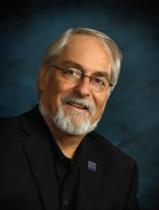
RICK COYNE
Rick Coyne is the president of ClubInsights and co-founder of PCMA. He can be reached via email: rcoyne@clubinsights.com
Here we are at year’s end, looking back on nearly three years of events shaping today’s issues, challenges and opportunities.
Obviously, clubs have benefitted from the lockdowns as non-members used clubs as replacements for lost vacations, as safe social environments and as places with the freedom to be outdoors.
Yet, these years also opened significant challenges, from labor shortages and higher costs of labor, fuel costs, inflation and even food shortages, all of which drove club costs upwards of 20 percent, ultimately resulting in increased dues and costs to the members. The resultant frustrations were evident to staff and members. Limited capacity was met with increased demands, staff was taxed with extended hours and members were frustrated over reduced service capacities. The past three years have been a mixed bag of significant upsides and challenging costs and operating processes.
As stewards for an industry and our individual clubs, one of our greatest challenges is how we deal with these changes. From communication to members to policy decisions, it is easy to get lured into complacency, even hubris, believing that everyone sees it the same way and these trends will continue forever. History should be the great arbiter in this debate.
While there are many reactionary examples of club responses to the challenges and opportunities, three specific areas should be concerning: increasing initiation fees, closing down secondary categories of membership and limiting real-time communications with members relative to their reactions, needs and what may yet lie ahead.
In at least three iterations over the past 50 years, we have seen initiation fees increase dramatically. One was the development phase of gated communities and refundable initiation deposits. Initiation fees could be artificial and unrelated to local market conditions. The cost was generally associated with a real estate transaction and was intimated to be a return on investment as initiation fees continued to rise. As anyone living through this period knows, it sold real estate but became an operational nightmare over time, with most clubs desperately changing membership documents reflecting a reduced obligation of the club. Initiation fees were forced to become more market-driven. In the late ’80s, we also saw significant growth that lasted through 2000 in the number of golfers and daily fee clubs. Clubs relied on the velocity of golfer growth to drive initiation fees higher and higher, miscalculating the effect of daily fee clubs and/or the local market area’s ability to afford the fees that the club created. In about 2000, initiation fees came crashing down.
Most recently, we saw a 30 percent decline in golfers from about 2003 to 2008, coupled with a financial crisis. The reduction of members for most clubs resulted in again reviewing initiation fees and their relevance to a market’s capability and willingness to pay.
In none of these incidents were the primary factors of increases based upon the market. Boardrooms were more eager to compare themselves to competitor clubs, proclaiming if they could raise fees, their club should be even higher. Markets are the only data-driven barometer for initiation fees. If we could move a mediocre club from a mediocre location to a location of incredible density of wealth and limited competition, we could raise the fees.
Fees raised solely on the temporary demand of COVID-19 lockdowns or temporary demand for membership that is short term and unsustainable are simply short-term fallacies, nearly always resulting in initiation fee corrections at some point. The same is true for capital improvements. Your improvements have no effect on your finite market’s ability to pay a level of fees.
The same is true for shutting down categories of membership that developed over time to regulate opportunities either for incoming younger members or for retaining older members. The cycle of opportunity has traditionally been short, creating the need to be prudent in your actions relative to long-term commitments.
Perhaps even more important is the communication channels with your members. Many clubs had significant growth during COVID-19 and many questions exist about their motivation and longevity, especially as new and rising costs are now necessarily being passed on to members in the form of dues and ancillary costs. Surveys, pulse surveys and developing the means to hear from members regularly to ascertain their satisfaction, changing needs and attitudes and what they may want in order to retain their membership are now more important than ever. A strong communication strategy is critical.
Finally, as we look back and mull over the state of the current industry, it is equally as important to look ahead. Our world has changed dramatically in terms of a divided country, financial woes, crime and poverty. Are private clubs insulated as we continue our journey into 2023 and beyond? Even the most optimistic would agree: Use caution in your short-term decisions until you can be assured of ongoing sustainability. Use this time to create the experiences that sustain the newfound growth rather than see it recycle backward as in so many historical experiences. It’s really up to you. BR


“Mistakes are often teachable moments in disguise.”
– Ranal Currie
I recently met a friend for lunch at one of my favorite local restaurants. And I ordered one of my two lunchtime favorites – a Cobb salad. (My other favorite is a turkey Reuben sandwich, or a California Reuben, as it’s frequently called – roast or smoked turkey, Swiss cheese, coleslaw or sauerkraut, and Thousand Island dressing on grilled rye bread.)
The Cobb salad? Chopped salad greens, crisp bacon crumbles, hard-boiled eggs, tomatoes, avocado, blue cheese, and dressing. While it’s often served with a red wine vinaigrette, I prefer a combination of French and blue cheese dressings. Delicious!
Usually. Read on. While this saga occurred at a local restaurant, it could just as easily have happened at your private club or resort dining room.
The story. When the server delivered my Cobb salad and placed it in front of me, the first thing I noticed was that the avocado seemed to be missing. So, I poked around the romaine leaves with my fork and found two small avocado slices, not the usual five or six, hiding under the romaine. However, the ends of the slices didn’t look great … discolored with dark spots … maybe that was why they were hiding? Nonetheless, I figured I could cut out the discolored part and eat what was good.
But where was the rest of the avocado … the other three or four slices with the creamy yellow/green flesh that I was used to seeing? I asked the server. She headed back to the kitchen and returned a few minutes later with, well, what you see pictured below. What I was served originally is the two slices

NANCY M. LEVENBURG
Nancy Levenburg, Ph.D., is a recently retired professor of management in the Seidman College of Business at Grand Valley State University in Grand Rapids, MI. She has published numerous articles in business and professional journals and has assisted over 200 organizations with strategic planning, marketing strategy, and improving operations. She is the president of Edgewater Consulting and a member of Spring Lake Country Club in Spring Lake, MI. For more information, contact her at: levenbun@gvsu.edu or (616) 821-5678.
on the right; what she delivered to me after her return to the kitchen was the unsliced (and obviously rotten) avocado section on the left. And she delivered it with an apology: “Chef said that the avocados don’t look very good.” (Duh!)
According to healthline.com, one of the telltale signs that an avocado is rotten is if it’s brown inside. What happens if you eat a bad avocado? According to numerous sources, avocados are very nutritious and have many health benefits. But if you eat rotten avocados, they can make you sick. You may get an upset stomach, diarrhea or vomiting. Eating rotten or moldy avocado or any fruit having fungal growth is never a good choice.
What puzzled me the most about my bad avocado experience was, why on earth would a chef, server or restaurant serve anything to a diner that was so obviously unappetizing, to say nothing of potentially harmful?
As a long-time educator, it struck me that perhaps this was a “teachable moment.” For those not familiar with the term, a teachable moment is an unplanned opportunity that allows a teacher (parent, mentor or trainer) to provide special insights on a topic when there is an immediate real-world connection. It’s the perfect opportunity to teach something.
So, how could the saga of the bad avocado be turned into a teachable moment?
• For the chef: Be honest about food quality. Rather than trying to hide two salvaged-yet-discolored avocado slices under the lettuce, if the avocado isn’t up to par, why not be honest with the server? Suggest that the server ask the diner if another item could be substituted … perhaps chopped chicken or a medley of other vegetables in the kitchen (e.g., chopped cucumber or green pepper). Customers appreciate honesty.
• For the server: Jidoka. From quality circles (operations management), jidoka – a Japanese term – means stopping the line. This means that if poor quality has been detected, stop production and fix the issue. In other words, don’t serve rotten avocados to this diner – or to any others.
• For the restaurant: Make things right with the customer. And figure out why the avocado was bad and how to hopefully prevent this from happening in the future.
Keep in mind that people are more likely to share a bad experience than a good one. And many restaurateurs these days are struggling to turn a profit between COVID-19, labor shortages, supply chain and food shortages, energy prices, and so on. It’s a bleak environment. So don’t let your “controllables,” like food quality, make it even bleaker. BR




RYAN MCANDREW
Ryan McAndrew is an assurance senior manager and real estate senior analyst with RSM US LLP, based in Naples, FL.
Golf and country clubs present a certain kind of sanctuary from the realities of the day-to-day world.
With their lush grounds, sumptuous dining rooms and often exclusive air, these islands of luxury offer members a place for renewal and to connect with other people.
But what happens when external pressures begin to intrude on the members’ reverie?
These days, board members and managers at golf and country clubs are feeling pressures they have not felt in years, as rising interest rates, a shortage of workers, supply chain issues and increased housing costs pose significant challenges. And these pressures are likely to continue for some time.
The Federal Reserve is on a campaign to raise interest rates to tame inflation, which will result in higher carrying rates for clubs’ mortgages and lines of credit. Add in lingering supply chain pressures and the tight labor market, and clubs are often feeling a squeeze.
Take the fraught decision of embarking on a capital project. These improvements are needed to maintain the buildings and grounds of a club and attract new members, but they are becoming expensive. In the current landscape, their cost could potentially increase by 50 percent or more, depending on the stage of development. Such a steep increase can lead to members paying special assessments in addition to their usual dues.
At the same time, clubs have faced a constant challenge in retaining workers and hiring new ones who can help clubs offer
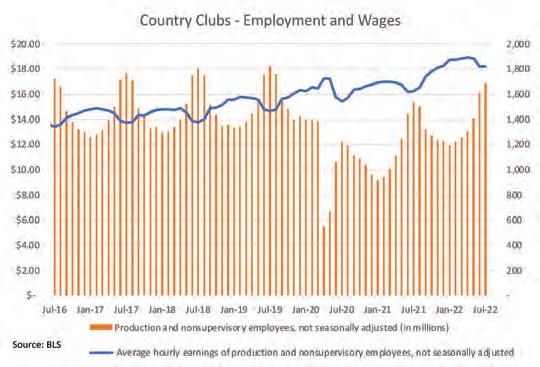
members the high-end service they have come to expect. Indeed, the industry overall was shaken by the pandemic. Total hourly employees working in recreation and country clubs peaked in August 2019 at around 1.82 million and cratered to a low of 553,000 in April 2020, according to the Bureau of Labor Statistics. The industry has since recovered to around 1.6 million employees through this past July for a net job loss of about 200,000.
But as the economy has recovered, wage growth for the club industry has climbed by close to 20 percent during the same period to an all-time high of $19 per hour. With employees demanding higher wages for the same positions, club operating budgets will continue to be under strain next year. While membership dues may cover these cost increases, clubs still face staff shortages and turnover.
One particular challenge for clubs is the availability of affordable housing for their employees.
Even with record highs for wage growth, in many areas where clubs are situated, the increase in the cost of rent far exceeds wage growth. For instance, areas in Florida, which has a high concentration of clubs, lead the nation with surging rental costs. According to a study by Florida Atlantic University in April, Fort Myers has the highest increases in annual rent at 32.4 percent, with areas in Southeast Florida—including Palm Beach, Broward and Miami-Dade counties—falling close behind with a 31.7 percent annual increase.
Rent pressures, along with increases in real estate valuations, have effectively created a bottleneck in the rental market in some areas that are next to high-wealth neighborhoods.
Coupled with historically high gas prices, the prospect of increased wages is muted by longer transit times and additional costs to live in more affordable areas outside of the immediate halo of many country clubs.
While these challenges add stress to a club’s budget and operations, savvy operators can see opportunities to create value.
With wage increases and bonuses alone no longer filling job openings, club managers should focus on workplace culture, employee development, upskilling and flexibility to retain

BOARDROOM BASICS AND BEYOND

J.G. Ted Gillary, CCM, CCE, ECM, CMAA Fellow is a consultant and search executive with Kopplin Kuebler & Wallace. Kopplinandkuebler.com
A month after 9/11, my wife Annie and I sat in a restaurant on Annapolis’s Main Street, enjoying a rare dinner with a young plebe.
He wouldn’t admit it, but we could see he just wanted to sleep. He politely made small talk while darting glances at the door, ever vigilant for the appearance of an officer. Then, pausing between bites, he quietly announced he had discovered a new way to learn.
We put down our forks and turned to him with interest. “First,” he said, “I read profusely, whether I completely understand the subject or not. Then, after a while, I put away the books and think intensely about what I have read, heard, and observed. In time, things come to me, the subject becomes clear; I conceive of new concepts and ideas.”
This young plebe had discovered how to do the deep work. Fifteen years later, Cal Newport would write “Deep Work –Rules for Focused Success in a Distracted World.” Making sense of this practice for a general manager is what this article is all about.
As an executive coach, one of my main objectives is to help the client understand what is most important, to foster a curious mindset, and to ask the right questions. When embraced, the enjoyment experienced by the client with the “aha!” moment has its rewards and leads to thinking strategically. The reality is that a GM is paid to operate in the moment and to think in the future.
In my experience, creativity starts with acknowledging guiding principles because a foundational principle demands integrity of thought and action and the impetus to stay the course. Take, for example, a GM who embraces the principle of never relieving oneself of the responsibility for the well-being of the club. What responsibility for action does that principle require?
The effective GM decisively exploits opportunities and embraces innovation by seeking to provide members with something new and better. With a desire for growth, the GM overcomes problems and pushes aside the nagging tug to hunker down under stress and problems.
A good leader knows when to “put away the books,” the knowledge-gathering phase, and when to focus on delivering a winning action plan. Curiosity is a valuable mindset. After a period of information gathering about important issues, the curious GM’s next step is to craft possible answers to the most compelling questions. This basic premise is outlined in Roger Martin’s book, “Playing To Win.” He states that effective strategy is always a choice of how to win, not just compete.
Asking good open-ended questions is an important skill
How does this process look in practice? A GM should cultivate the skill of asking open-ended questions to help define the problem. Below are examples of this exercise:
• In what market are we playing?
• What do we have to do to win?
• In what ways do members have an emotional connection to our club?
• Does our current operating model foster excellence throughout the member experience?
• In 5-10 years, what will prospective members want in a club experience?
Answering strategic questions is a process
The next step at the heart of organizational change and development is to think through the details. Dr. Max Bazerman of Harvard Business School proposes the rational model, a six-step process for optimum decision-making:
• Define the problem
• Identify all relevant criteria
• Weight the criteria
• Generate alternatives
• Rate each alternative of each criterion
• Compute the optimal decision.
I experienced this firsthand in Bazerman’s HBR Executive Education class, Changing the Game: Negotiation and Competitive Decision-Making, and put the concepts into practice at the Detroit Athletic Club. From experience, I suggest keeping your mind fresh during this process and working with others to be thorough.
Using our minds and thinking deeply is the most energy-consuming activity in which humans can engage. It is also the most important. Why does it seem that much of a GM’s life gets in the way of doing the one thing that allows the GM to conceive of how to do something new and better? Yet, it is the ability to think, focused on the right things, that makes a leader valuable.
We strive to be efficient and subconsciously do things to conserve our energy and save time. The problem with this habit is that it is at odds with thinking deeply and comprehensively. Where speed is considered a virtue, deep thought is often postponed.


So... we’re going to end up in a very different place than we had envisioned 20 months ago. But thanks to the hard work put in by the board, clubhouse committee, management and the club’s professional consultants, along with a focus on transparency, communication and inclusiveness, we can look forward to moving into a beautiful new clubhouse sometime in the summer of 2025 and beginning an exciting new chapter in the life of our club.
Those words encapsulate Diane Exter’s achievements as Frenchman’s Creek Beach and Country Club President and highlight her selection as BoardRoom magazine’s Distinguished Club President for 2022. BoardRoom magazine this year is recognizing 24 Private Club Presidents of the Year – 2022 for practicing what they preach – leadership for the betterment of their clubs – board presidents or chairs who serve as their club’s volunteer leaders.
It’s the 15th year BoardRoom magazine has recognized the industry’s top private club presidents for their outstanding work. BoardRoom received nominations and applications from different clubs throughout the United States and other locations worldwide.
“The selection of the top 23 presidents and Diane Exter as our Distinguished Club President signifies another successful search through the nomination of leaders who have contributed so much to their private clubs and their member experience,” expressed John Fornaro, Boardroom magazine’s publisher and CEO.
“We honor board leaders, exemplary individuals, who go beyond the basic requirements of governance and work collaboratively with the club’s management. The award underscores the role that a board president and her leadership play in driving a club’s success and contributing to the club’s long-term health.” ➤


Diane’s professionalism has been evident from the start of her term as president. Her commitment to the job, attention to detail, focus on establishing clear goals, the inclusion of all board members in the process and her focus on achieving our objectives has made her a successful board president. Working with her over the last three years has been a real pleasure. She’s a true role model for all board members.
-Michael Azeez, board member
Frenchman’s Creek Beach and Country Club in Palm Beach Gardens, FL, offers an intriguing history. In the 1930s, the Hoyt family named the creek flowing through their property Frenchman’s Creek after one of the family matriarch’s favorite romance novels.
The name, Frenchman’s Creek, stuck when developers opened the club in 1986 and again in 1991 when the membership acquired the facility, except for the yacht club and marina.
Today 606 homes on 770 acres are built around two highly regarded championship golf courses and practice facilities. In addition, residents enjoy a vibrant, healthy lifestyle offered by 14 Har-Tru tennis courts, six Har-Tru pickleball courts, and a 14,000 square-foot fitness, wellness and aquatics center with state-of-the-art equipment, lessons, clinics, Pilates and personal training. For boating enthusiasts, many homes offer deep-water ocean access.
As an all-inclusive single-membership club, Frenchman’s Creek offers a community of friendships and interactive social pursuits that helps minds stay as nimble as the body.
“The non-profit private club industry is the most difficult industry to be a board member or manager. Board members, who are also the shareholders (owners) of the club, are also the customers. Often fraught with conflicts of interest, a private club can be very challenging to manage,” Fornaro added.
“Through collaborative governance, the general manager, the club’s president and the board members are meant to work collaboratively. We recognize board presidents that don’t delve into micromanaging.
“Micromanagement is not only frustrating for management, but also wastes board members’ often limited time to do their actual job, which is direct-
ing … setting policy, and not managing the organization or operations. That’s management’s job,” Fornaro emphasized.
“This is a wonderful achievement for Diane Exter,” acknowledged Gordon Welch, APCD, the spearhead behind the Boardroom Institute, the online training arm for private club board members.
“Congratulations. The Association of Private Club Directors (APCD) is thrilled to recognize this outstanding achievement and award,” he added.
The impetus for BoardRoom’s top president recognition program comes from its sponsors, the Association of Private Club Directors, the parent organization of Boardroom magazine, and Kopplin Kuebler & Wallace, one of the country’s leading private club industry consultants and executive search firms.
Dick Kopplin, Kurt Kuebler and Tom Wallace, partners with Kopplin, Kuebler & Wallace, have been involved with BoardRoom’s outstanding presidents’ program from day one and based on their work with private clubs, have an exceptional grasp on the nuances and requirements of private club governance.
“Our firm’s almost 27 years of connectivity to the top club boards, specifically top club presidents, finds us impressed every year with their unwavering commitment to improving their clubs by focusing hard to ensure great governance practices are used and a culture of stewardship exists,” expressed Tom Wallace.
“The leadership we continue to see is truly impressive. That’s why we are so thrilled to support BoardRoom magazine in honoring these volunteer leaders who give so much of their time and energy to improve their club. We also appreciate the stable working environment these leaders provide their management team and staff,” he added.
“I’ve had the good fortune of getting to know Diane and seeing firsthand the positive impact she has had on Frenchman’s Creek, leading the effort to gain support for a significant new clubhouse and guiding the club through the transition from a successful long-time, retiring club executive to the next generation,” commented Kurt Kuebler, partner with Kopplin Kuebler & Wallace.
“Managing expectations, process and myriad other key issues was a Herculean effort and her dedication and patience made it all happen in a very positive way!”
It’s been an interesting period for Diane Exter, as the first female president of Frenchman’s Creek Beach and Country Club. She assumed the president’s role as the highly charged debate over whether to renovate or rebuild the club’s aging clubhouse reached peak intensity.
“It surprised me when we first joined Frenchman’s that there were so few women on the club’s board of governors and that there had never been a woman president,” said Exter. “As president, I don’t believe my gender differentiates me as much as my leadership style and approach do. We’re a community of 606 homes and 1,100 neighbors. I feel I need to hear from those neighbors and they need to hear from me.
“I’m focused on transparency, communication, and inclusiveness. Each week I communicate via emails, texts, calls, and in-person chats with many members who voice their concerns, complaints, and compliments. This frequent and regular communication gives me a good sense of the pulse of the community,” Exter explained.
Also, Exter and executive director/COO Miles Tucker host a monthly ‘Meet the President” forum to discuss hot topics and answer members’ questions. These meetings are videoed and a link sent out via email, enabling members to hear the questions and answers. ➤


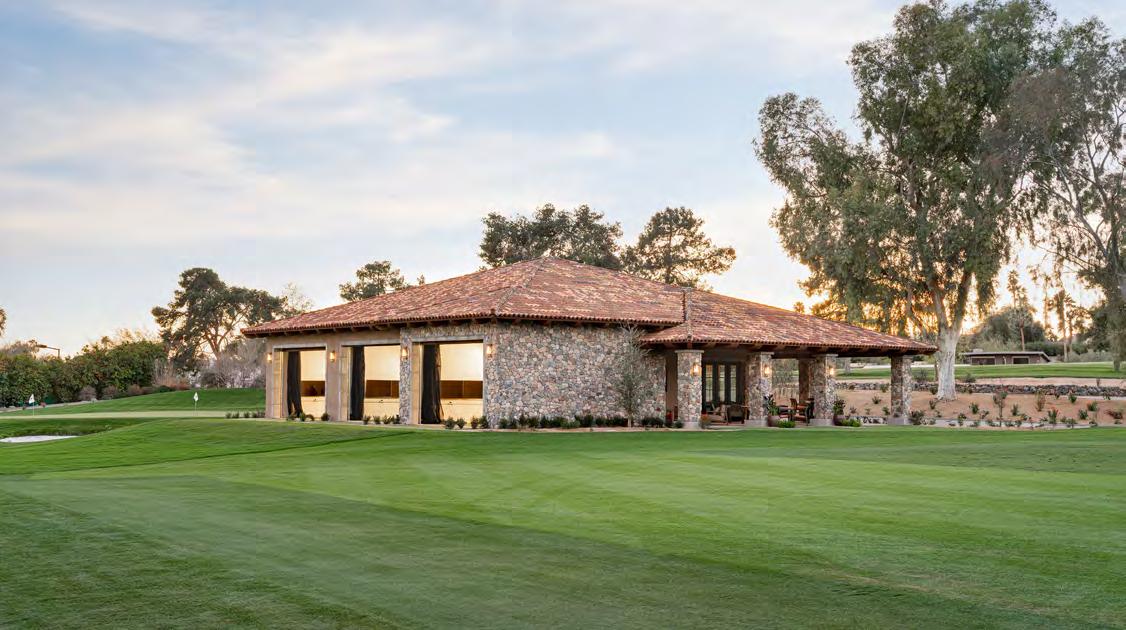

Diane became president of Frenchman’s Creek during the most tumultuous period of the club’s storied history. The debate over whether our clubhouse should be renovated or replaced was raging. It had even boiled over into a few incidents of incivility in a community in which respect for others had always been the operating principle.
Strong disagreements exacerbated this tumult among board members. Diane took over with the goal of developing a process that would enable us to reach a decision on the clubhouse issue, which would ultimately be supported by a substantial majority of the members and at least be respected as fair by those in dissent.
While it is never possible to please everyone in a community with demographics and interests as diverse as ours, Diane has succeeded in realizing the goal through a combination of tenacity, extraordinarily hard work, attention to member concerns, and above all, unprecedented transparency concerning her actions and those of the board.
-Marty Krall, board member
“We’ll need the membership to approve additional funding to complete the project. We’re optimistic that we will have continued strong membership support for the new clubhouse when an updated plan is presented in January 2023 and a final vote is taken. This is the last but very important step before we can start construction,” she added.
About three months into her tenure as president, the club’s long-time COO and executive director determined that the moment was right for his retirement. This cleared the way for the search for a new COO/ED.
“Hiring a top-notch executive director and COO with the vision to take Frenchman’s Creek to the next level remained one the board’s most important goals over the past 20 months,” expressed Exter.
The search eventually took Miles Tucker, after 10 years at Hillcrest Country Club in Los Angeles, across the country, to join Frenchman’s Creek as COO/ED in April 2022.
“Miles presented a well-thought-out vision for our club and it was clear he had the experience and expertise to continue, and indeed improve, its reputation as a top-tier club,” she added.
One of the things that most impressed Diane about Miles’ application was his approach to aligning the efforts of the club’s paid and volunteer leaders through a SMART goals process...a subject he has presented on at the CMAA World Conference, and one very much in keeping with Exter’s leadership philosophy.
Both Tucker and Exter believe that sharing the committees’ goals








Diane has been a truly transformative leader for our club, leaving no stone unturned in the pursuit of building consensus on critical strategic issues at the board level and community-wide.
-Bob Scherer, board member
It is a pleasure to serve alongside Diane on the board of governors. As club president, she has set clear goals for the community and has worked diligently to achieve them. She came into office at a time marked by major change and navigating through COVID-19. Diane makes sure all voices in the community are heard at each step and for each issue. She is a consensus builder and is willing to roll up her sleeves to get the hard stuff done. And anyone who has served on a community board knows how difficult that can be. Diane has effectively managed through a period of transformational change that will serve Frenchman’s Creek for years to come.
-Ellen Malasky, board member
I am proud to serve on the Frenchman’s Creek board of governors with Diane as our president. Diane draws upon each board member’s strengths and skills to keep us driving toward common goals and has inspired each of us to engage the community in the important work of making Frenchman’s Creek the best it can be. Diane also sees it as a priority to ensure that our community is welcoming to both new and long-standing members. She has been an outstanding club leader at a time when we face numerous challenges but also exciting opportunities.
-Jill Kremer, board member
“Identifying clear and distinct roles for the board and management has long been a priority for me,” explained Tucker. “I’ve been pleased to find in Diane a strong partner in ensuring that the Board stays focused on policy and guidelines and leaves managing to the managers.” In other words, no micromanaging!
The club recently engaged multiple consultants to guide the board on club governance best practices.
“We’ve also placed a meaningful focus on this issue in the strategic planning process which we are currently working through,” she said. In addition, management has been fortunate to have the complete support of Diane and the board in establishing clear roles and responsibilities for the paid and volunteer leaders of the club, an example of which has been the decision-making matrix that has been developed for our $90 million clubhouse project.
In this matrix, management has full authority to approve change orders up to a set monetary value/scheduling impact limit, with the construction committee then being able to approve management’s recommendations to a higher threshold. The full board becomes involved only when the cost or scheduling implications of the change are truly significant.
“Miles and I share a belief that the establishment of clear guidelines such as this ensures that management is empowered to drive the project in real time, with the board supporting the process and honoring its fiduciary responsibilities,” Exter stressed.
So, it’s been an interesting couple of years for President Exter and Frenchman’s Creek Beach and Country Club and no doubt her engagement will continue.
“Our neighbors are highly accomplished people and have much to offer,” Exter expressed. “At the beginning of each fiscal year, the president chooses the committee chairs. In the past, there was very little turnover among the committee chairs, as well as the members of each committee. When I became president, I asked the newly appointed committee chairs to diversify their committees by age, tenure, and gender, which promoted greater inclusion of the full community and enabled a broader swath of the membership to participate in the life of the club.
“In the old clubhouse (before it was demolished) we had pictures of the past presidents on the boardroom wall....none of whom were women. So, when the new clubhouse is built, I will be the first woman ‘on the wall.’ I’m very confident, however, that I will not be the last,” Exter concluded. BR


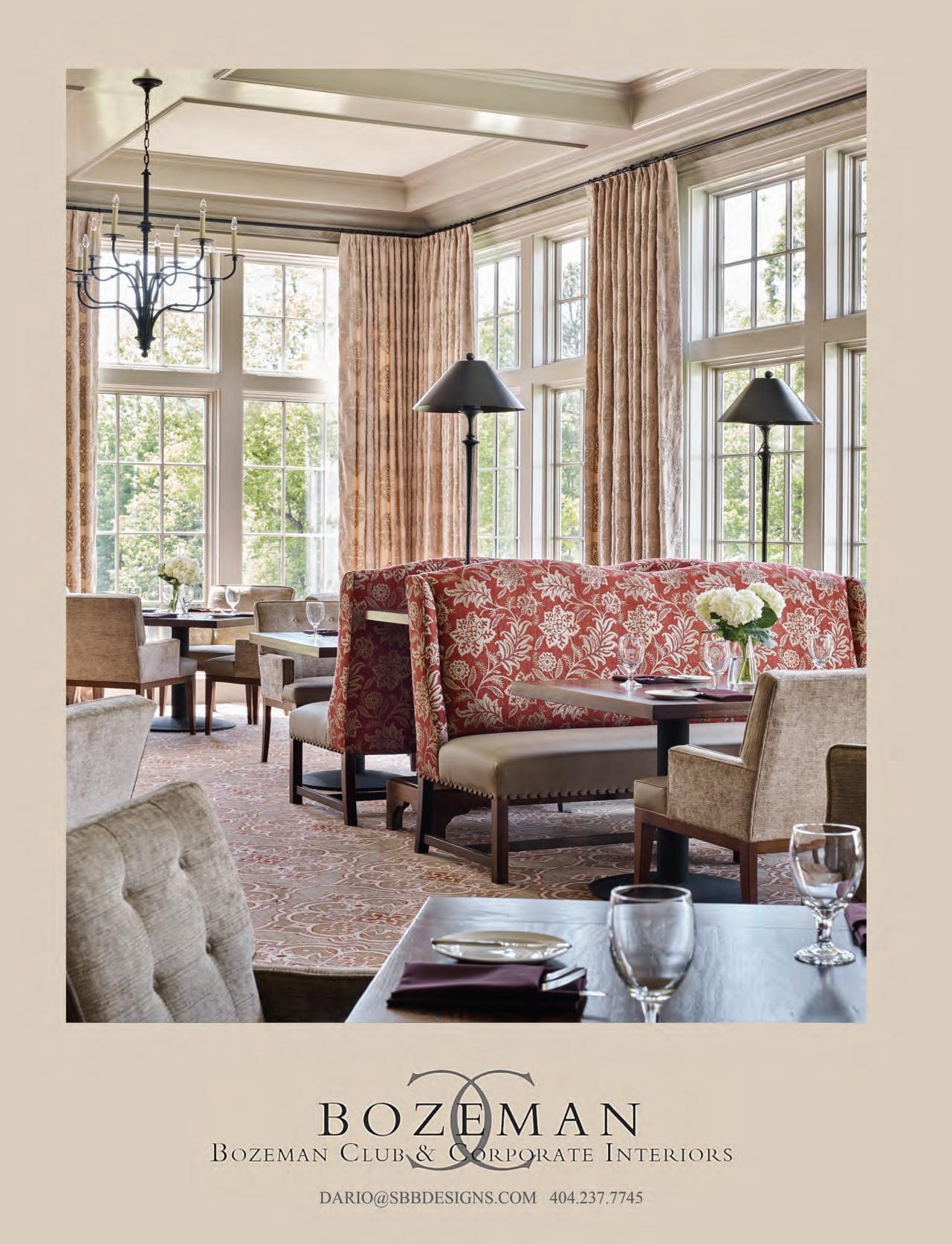
After an eight-year search for a home at Frenchman’s, Diane and her husband Neil finally found ‘the one’ and purchased it in March 2015.
Now Florida residents, they enjoy the many aspects of the Frenchman’s lifestyle and social culture, including the many great friends they have made, multiple food venues, attentive staff, 36 holes of golf for just 600 homes, Beach Club, Fitness Center & Spa, and tennis courts. They also have a small orchard in their yard where they enjoy growing several kinds of delicious fruit year-round.
Before moving to Florida, where she’s been solely focused on her work for Frenchman’s Creek, Diane was actively involved for many years in the Boston area in promoting and supporting the two causes about which she is most passionate - Jewish communities and inner-city education.
She served as board chair of City Year Boston, which puts idealistic young professionals in Boston schools for a year of service, and as a board member of Combined Jewish Philanthropies (CJP), where she co-chaired the Commission for Strategic Priorities (the organization’s primary allocation committee).
Diane was also a board member and treasurer of uAspire, an organization dedicated to increasing college affordability for inner-city students. She also served on the United Way board in Boston, where she developed and chaired an inner-city scholarship program.
Diane and Neil are also members of Belmont Country Club, just outside of Boston, where she served on the board as treasurer during a

period of financial stress for the club. She oversaw the refinancing of the club’s debt, working closely with management to reduce expenses while maintaining a very high level of service. She also spearheaded a new member engagement initiative with the goal of increasing the size of the membership.
Diane is a retired partner and managing director of Bain Capital. One of the original co-founders of Bain Capital’s debt business, originally known as Sankaty Advisors (now Bain Capital Credit), she was involved in overall firm management, investment approvals, and the oversight of Sankaty’s loan portfolio. Before joining Bain Capital, Diane was a managing director at BankBoston, where she focused on acquisition financing and debt workouts.
Diane has a Master of Business Administration from the University of Virginia’s Darden School of Business.
As club president, Diane has enjoyed the opportunity she’s had to work with the others who serve on the board, the club’s committees, and with management and staff.
In her words, “We’re engaged in a wonderful collaboration with a shared goal of making Frenchman’s Creek, this place that we all love, the best that it can be.”
Diane and Neil are blessed to have two grown sons and a daughter-inlaw. As Diane likes to say, “Life is good!” BR
BoardRoom magazine recognizes 23 presidents as Private Club Presidents of the Year and one Distinguished Club President of the Year for practicing what they preach – leadership for the betterment of their clubs. Congratulations to all!
Diane Exter ........................ Frenchman’s Creek Beach and Country Club ............................ Palm Beach Gardens, FL
Jeffrey S. Bennett Bald Peak Colony Club Moultonborough, NH
John Beystehner Hammock Dunes Palm Coast, FL
Brock Denton Kenwood Country Club Cincinnati, OH
Charles W. Douglas The Chicago Club Chicago, IL
John C. Gammage Jr. Round Hill Club Greenwich, CT
Ira Green .......................... Houston Country Club ......................................................... Houston, TX
Robert F. Heiser .................... Belle Haven Country Club .................................................... Alexandria, VA
Dave Higgins, Jr.. .
. . Del Paso Country Club ...................................................... Sacramento, CA
Scott Holden ....................... Pittsburgh Field Club ........................................................ Pittsburgh, PA
Monika Jain. .
. West Side Tennis Club ....................................................... Forest Hills, NY
Richard Kayne ..................... Tara lti Golf Club .................................................. Mangawhai, New Zealand
Todd Kennedy ..................... Wilderness Country Club ......................................................... Naples, FL
Bob Kline .......................... Country Club at DC Ranch .................................................... Scottsdale, AZ
Justus Leachman ................... Meadow Club ................................................................... Fairfax, CA
Brian Maxwell ..................... Edina Country Club .............................................................. Edina, MN
Paul Mihailides ..................... The Preserve Club and Residences .............................................. Richmond, RI
Elizabeth Mullan ................... Bel-Air Bay Club ........................................................ Pacific Palisades, CA
Marian Robson ..................... Terminal City Club .................................................... Vancouver, BC, Canada
Corey Rose Westwood Country Club Vienna, VA
Bradley Schreier Grey Oaks Country Club Naples, FL
Steven M. Schultz Hollywood Golf Club Deal, NJ
Bill Turner Loblolly Hobe Sound, FL
Charlie Zacharias Bear Lakes Country Club West Palm Beach, FL
Private Club Presidents of the Year Major Sponsors

“As the general manager at the Bay Head Yacht Club, I have been working closely with KOPPLIN KUEBLER & WALLACE for many years. When assisting us in our hiring needs, they have been extremely diligent, professional, and effective. The firm has been responsible for several of our hiring decisions throughout the years, all of which have greatly benefited the club. The professionals at KK&W are adept in understanding the requirements of each position as well as what we look for in our employees.”


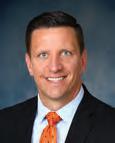




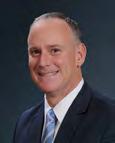

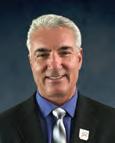





Serving The Industry Since 1996







We were pleased to hear that our September/October article “Never Stop Coaching and Developing Talent” struck a chord with BoardRoom readers. They said that the article brought back memories of past coaches and leaders they admired. They practice lessons learned in work and play.
We would like to further expand on Coach Jake Ciccone’s wisdom with 10 more leadership lessons practiced by Manistee Catholic Central’s 22-man Class C football team upon becoming the state of Michigan football champions in 1969. These can be translated and applied to your role as an effective private club leader, as well as to winning in the game of life.
“Gentlemen, we are here to do business; cinch those ties.” This was Coach’s way of setting the tone for first impressions from those you encounter. We always wore blazers with ties, dress shirts and slacks, and dress shoes. Coach felt that If you looked the part, you would act the part.
Translated: You are constantly being watched by people in your club to determine if your persona is consistent with your words. If you are a club leader, look and act the part.
“I hope it is 110 degrees today out there on the practice field.” Coach believed that we must deal with the small things, knowing that in life there are bigger fish to fry.
Translated: If you are a club leader, deal with the important issues.
“If you think this practice is tough, wait until you get involved in the game of life.” Everything that we effectively accomplished in practice helped us succeed in life.
Translated: Life as a private club leader takes unrelenting mental, physical and emotional toughness.
“We must avoid playing like the Sisters of the Poor.” Coach had nothing against the Sisters; he was simply acknowledging that they did not know how to play football.
Translated: Model your behavior after winners in the “game” you are playing.
“We are going to take a little jog.” Then 25 miles later we returned to football camp.
Translated: Do what it takes to go the extra mile, and encourage others in the club to join you in achieving the vision and living the mission. Set your pace for the long game.
“Never pass a man to get to a man.” This advice was constantly drilled into us.
Translated: Take care of your problems as they present themselves. Focus on the barriers to achieving SMARTER goals with viable solutions along the way.
“Bring it on.” The opposing Chicago Mundelein Mount Carmel (Class 3A school) coach said to Coach Ciccone: “I see you have 22 players. Should I put my third string in to go easy on you?” Coach Ciccone said to the Mundelein coach: “No, just bring it on.”
Translated: In the game of life and in your club, you lead others to develop their skills and play confidently. By the way, after Mount Carmel “brought it on,” we beat them 46-6.
“Show your spunk.” Our team played in several pre-fall season scrimmages in the Niles, MI area. After beating every team that we played, we did calisthenics after each game.
Translated: It is always good to let the competition know that you have spunk and courage. Stay the course and give it all you have while showing your strengths as a club leader.
“Winners never quit and quitters never win.” With a nod to Coach Vince Lombardi, pause and reflect occasionally on the many ways that you have developed your leadership style.
Translated: When you face challenges with perseverance, you will encourage others to win. As a club leader, you are a role model for others.
“Hells Bells...” This was Coach Jake Ciccone’s attention getter as in “everyone listen up.” Coach knew the key to communication was listening, because listening is the most important communication skill.
Translated: Pay attention and listen with the intention of understanding others.
These are 10 simple leadership lessons for you to consider in your leadership journey. Modify if necessary and implement them in your practices. BR
Dr. Jack D. Cichy, C.M. is professor emeritus of sustainability/management at Davenport University. Dr. Ronald F. Cichy, O.M. is professor emeritus at Michigan State University



STEVE GRAVES
Steve Graves is the president and founder of Creative Golf Marketing. He can be reached via email: steve@creativegolfmarketing.com
This issue of BoardRoommagazine is highlighting 1) the state of the industry, 2) the announcement of the recipients of BoardRoommagazine’sExcellenceinAchievementAwards and 3) the preparation for the magazine’s 27th year.
These three subjects brought one word to mind for me: significance. To be significant or to have significance is to be noteworthy, important and worthy of attention. If something or someone is significant, they tend to also have an element of influence.
Interestingly, while I was writing this article, the world was rocked with the passing of the beloved Queen Elizabeth II, queen of Great Britain and Northern Ireland and head of the Commonwealth. Her last official duty, before her passing, was to swear in Liz Truss as prime minister of the United Kingdom. The Queen was working until the last days of her life.
For the first time in 70 years, there is a king of Great Britain and Northern Ireland, King Charles III. I would say that these events certainly qualify as being quite significant. There is a new normal for the United Kingdom. The whole world will watch to see how long King Charles III reigns and when will his son, William, the Prince of Wales, ascend to the throne. The state of the monarchy has changed, but it remains strong with everyone now saying, “Long live The King!”
Coincidentally, at the same time of this change from a queen of England to a king of England, we finally see the pandemic coming to a close. No, COVID-19 is not gone. More than likely, we will live with the possibility of “catching COVID” no differently than “catching a cold” for the rest of our lives. But, COVID-19 was clearly also a significant event. It changed our lives in some form or fashion. COVID-19 indiscriminately chose winners and losers. A person or a business did nothing right or wrong but, without question, people and businesses were either positively or negatively affected by the arrival of this significant event.
It is customary for the president of the United States, during the State of the Union address, to proudly proclaim “The State of the Union is strong.” This statement has been made by almost every president since Ronald Reagan in his 1983 address. I believe that Jeff Morgan, CEO of the Club Management Association of America, would proudly and
boldly proclaim that the state of the private club industry is strong. Jeff Morgan, CMAA staff and board of directors have made significant advancements to the profession of club management. The membership of the CMAA rose to the occasion during the pandemic. So, in keeping with my proclamations, long live Jeff Morgan, the strong leadership of the CMAA and the extraordinary membership of the CMAA!
This edition of BoardRoom magazine is showcasing the companies and individuals being recognized with Excellence in Achievement Awards. As I write this article, no one knows who will be honored, but I do know that the award recipients play significant roles in our industry and deserve the accolades and honors that are bestowed upon them.
I applaud the individuals and companies that have risen to their level of success in their given category of excellence and significance. I wish them continued success and thank them for the assistance and significance they provide to their respective clients. Long live the Excellence in Achievement Awards winners!
And, finally, it is imperative to recognize John Fornaro and BoardRoom magazine. John is, without question, one of the most influential and significant individuals in the private club industry. BoardRoom magazine is preparing for its 27th year as, without question, the leading and influential magazine of the private club industry. There is not a reader, contributor, private club leader or private club professional who has not been positively influenced by BoardRoom magazine.
Long live the king of BoardRoom magazine and his extraordinary team of professionals.
Each of us has our own kingdom. Each of us works with people who are actually the “power behind our throne.” Thank goodness for everyone who works at our companies, at the CMAA, at private clubs and at BoardRoom magazine It is definitely good to be king but remember this every day at your club and at your home: “When the king is happy, the king is happy. When the queen is happy, the kingdom is happy!” Long live our queens! BR

From pre-hire to retire, ClubPay streamlines operations with a custom suite of outsourced Payroll and HR solutions to meet your club management needs.

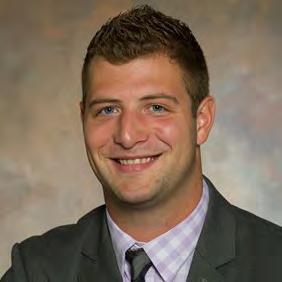


MARK GURNOW
Mark Gurnow is the general manager of Superstition Golf and Country Club. He can be reached via email: mgurnow@superstitionmtngc.com
Superstition Mountain Golf and Country Club is a premier private golf club and a luxury, master-planned community.
Over the past few years, we’ve seen preferences change for both members and homebuyers. As always, trends will come and go but one thing remains the same: our ability to give membership an outstanding private club experience.
Our 930-acre, guard-gated community features custom homes, new builds and homesites set among 17 village-style neighborhoods. We sat down recently with a member of our Realtor Advisory Group, Erin Elliott of Rabold Group, to discuss how luxury homebuyer preferences have shifted in the past few years. The biggest takeaway was that COVID-19 made a lasting impact on how people want to live in their homes.
During the pandemic, people were naturally more comfortable entertaining and visiting with both family and friends in their own homes. This trend is continuing and things such as guest accommodations and open layouts have become a high priority. Buyers are looking for large guest rooms or separate casitas to host friends and family from out of town.
Adding new technology throughout the clubhouse was an easy decision and especially important for members who use the space for business meetings. We also added new spa and barber facilities to give the club more modern services.
It has always been our goal to ensure our members can look first to their club for dining, entertainment and other services, and these changes will help us better meet these needs.
The warm, Mediterranean design of the clubhouse has been rejuvenated, and we’ve been able to create a space that is bright and welcoming. One that can be fully used exactly as our members want to use their club.
As with all things, change can be difficult, especially when we are talking about months of major construction and renovation. There will always be people who push back. Everyone wants something better, but they don’t want change.
We are lucky at Superstition to have an understanding membership and haven’t had many issues throughout the process. We’ve found that once we walked the few nay-
At the club, we are just coming out of a full remodel … and I am sure many of you can sympathize with all that entails. But the hassle of the process was worth the final outcome. Instead of adding more space to our private dining room, we added an extra patio. Our members often prefer more casual, alfresco dinners, and with this Arizona weather, who can blame them?
Even what it looks like to “host company” has changed and today’s homebuyers no longer want formal dining rooms. Instead, they opt for open concepts and casual dining spaces.
At the club, we are just coming out of a full remodel … and I am sure many of you can sympathize with all that entails. But the hassle of the process was worth the final outcome – it was important to make our space fresh while still maintaining the integrity of its rich, Tuscan design.
We updated the flooring, paint and lighting and opened up several areas to create brighter, more functional spaces. Instead of adding more space to our private dining room, we added an extra patio. Our members often prefer more casual, alfresco dinners, and with this Arizona weather, who can blame them?
sayers through the full scope of the project and they had a better understanding of what we were doing, they got on board.
At the end of the day, what makes Superstition so special is the people. And yes, living through a multi-month renovation at your club can be frustrating, but the people are the same and we were able to maintain that camaraderie throughout the process.
Like it or not, things change and always will. The golf industry especially has been going through a shift over the past several years, and we must find a way to maintain the integrity of private club membership while being flexible to new things. BR


WHITNEY REID PENNELL
Whitney Reid Pennell, president of RCS Hospitality Group, is a celebrated management consultant, educator, and speaker. RCS specializes in strategic planning, operations consulting, food and beverage management, executive recruitment, and training programs. RCS has been recognized 12 times with BoardRoom Excellence in Achievement Awards, including staff training five times. RCS continues to offer innovative solutions through RCSUniversity.com, an online virtual training portal for employees and managers. For more information, phone (623) 322-0773 or visit the RCS website at www.consultingRCS.com.
The struggle to find and retain talent is at an all-time high. The reasons are well documented.
Most clubs are trying to combat the labor shortage by reimagining their workplace culture and then pressing the reset button. Occasionally the investment made in improved culture through employee recognition programs, new onboarding programs, and updated policies has little impact on employee engagement or member service. Many times, it is because of the difference between symbolic words and substantive actions.
Imagine Disney having dissonance between the slogan “The Happiest Place on Earth” and a disinterested, cranky employee greeting your family on your vacation. That kind of disconnect sends a conflicting message to the customer and could turn the slogan into a mockery. Disney keeps its slogan as a strong service promise because it recognizes that its employees represent its brand. Disney is famous for it. Its
disenfranchised when they discover that their observations of management’s essential behavior diverge from their expectations, which were created by symbolic words and behaviors.
Most clubs claim that employees are their most valuable resource and enact symbolic policies or hiring statements to support this claim. However, if employees observe management behavior that differs from these symbolic words, they will believe only the actions. This can cause staff turnover, lower morale and decrease productivity. Consider these encounters relayed to me by club employees over the past few months that counter club-stated values.
Support: Poor member behavior has been tolerated at one club, contributing to recent resignations. A departing employee confirmed that “valuing employees has to be more than just a catchphrase; management and board support must be there, too.”
Bring focus to the big picture. Short-term decisions have a long-term impact. Sadly, layoffs and cutbacks were necessary for some during COVID. These short-term, necessary decisions had long-term effects on morale,
productivity
and employee commitment. When making difficult decisions, look for ways to mitigate their negative impact.
values, policies, and management practices are consistent with its brand message and core values. Disney’s investment in training is legendary.
We often misunderstand the relationship between management (or company) behavior and employee performance. True cultural change comes when symbolic words or actions (policies, procedures, recruiting promises, stated employee benefits, wellness initiatives) are consistent with and supported by substantive behaviors of management (supporting employees if treated poorly, providing tools and resources to be successful, flexible scheduling, encouraging time off for work-life balance, offering frequent recognition and appreciation, supporting fun and mental breaks at work). Without consistency, employees become
Appreciation: A long-tenured employee participating in a focus group observed that “it’s about more than ice cream,” describing the newly introduced monthly birthday celebration. His stance was that he and others worked through the entirety of COVID regulation changes and accepted pay cuts and variations to schedules as dedicated employees. He saw the club investing in other aspects of the operation post-COVID but felt employee perks and benefits had been stripped away, making the celebration seem disingenuous.

PENNELL - EXECUTIVE COMMITTEE | 40


Club Benchmarking delivers fact-based, actionable insight through a suite of business intelligence software and services developed specifically for the private club industry. We believe that when club leaders elevate fact over opinion, the result is healthier clubs, more empowered general managers and boards properly equipped to focus on strategic issues.
Club Benchmarking Solutions for Your Club
Financial & Operational Benchmarking
Strategic Monthly Dashboard
Capital Reserve Studies and Management Software
Capital Strategies Modeling with Dynamic Reporting
Member Motivation, Attachment & Loyalty Benchmarking
Employee Engagement Benchmarking
Compensation & Benefits Benchmarking
Strategic Governance Education
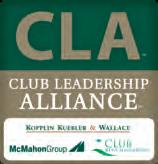
Founding Member of the Club Leadership Alliance Club Benchmarking, McMahon Group and Kopplin Kuebler & Wallace have established a collaborative working group known as the Club Leadership Alliance™. Our vision for the club industry is a transformation of the leadership model through widespread understanding and adoption of best practices that lead to sustained club success. Learn More at www.clubleadershipalliance.com www.clubbenchmarking.com/solutions
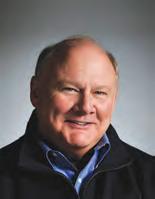
One of the most common frustrations of golf course superintendents is the lack of timely communication between department heads, especially with and from the general manager. The boss.
Superintendents may feel there is a lack of empathy for the challenges they face because the super’s office is not in the clubhouse but on the golf course. The GM may say that less communication is required or simply out of sight, out of mind.
Also, the need to communicate is such that as long as it’s green out there, “green is good,” move on to the next issue. No communication is needed. When it becomes brown, that’s when the GM feels it’s time to pay attention because he’s hearing it in the grill room. This is not a prevalent view or approach at the best clubs, but unfortunately, it’s a subtext in less than high-functioning management environments.
These common communication failures generally occur because of the lack of a thoughtful, succinct communications plan between stakeholders, especially department heads, that includes formal and informal communication and takes advantage of technology, all of which should fuel a fluid and transparent flow of information.
Cross-departmental empathy may happen organically, but every leader needs to own the concept and the execution. Communication is complex, yet one of the most critical leadership skills is managing up. Critical too is managing up to a leader that is receptive to this approach.
Might you or your green or golf chair learn of these insensitivities?
• The golf professional sends a group off the back nine at 8 a.m. without telling the agronomy team.
• The superintendent doesn’t let the golf shop know there was an irrigation leak on the forward tee on the third hole during a women’s event.
• The general manager schedules a meeting with little notice for the management team. Because it’s “important” to demonstrate huge insensitivity to the challenges in golf ops or golf course maintenance.
Examples could continue, yet we all understand how the movie plays out. All parties get frustrated because of the lack of structured, efficient communication, yet all leaders

own a piece of this decay. We all know the opposite of love is not hate. It’s apathy. As consultants, we see this apathy manifest when we conduct team meetings and employee surveys and critically when communication decays to a certain threshold when we are engaged to identify fresh talent for the GM or superintendent roles.
The best management teams create a mutually agreed upon communication plan that works to prevent miscommunication. Here are some simple steps to help you create better communication between the top managers at your club. Create a best practice communication environment. Is your management team set up to communicate efficiently and effectively? With today’s technology, we may tend to forgo communicating effectively. We send a text or an email rather than speak in person. We all have misunderstood the meaning of a text or an email. Texts and emails are important forms of communication, but speaking in person allows for dialogue and understanding.
When looking at club operations, the superintendent arrives and leaves first, the golf professional second, then the general manager, and finally, food and beverage. With the overlap between these teams, it is vital to ensure all teams are on the same page. Schedule meetings at times that are productive for all key managers. GMs with good peripheral vision say the best time to hold a meeting is when the management team is eager to meet. Some of the best times to hold meetings are mid-morning and early afternoon since all are usually present. What about a lunch meeting?
• Listen – Actively. Many spend more time thinking of a response rather than listening to both the content and the inference. This takes practice. Have you formed your response before hearing the entire concept or point? This prohibits you from understanding what is said. And generally, your response does not address what the person was saying. As they say in the Mountain West, two ears, one mouth.
• Communicate frequently. A best practice taught by effective GMs and superintendents is to stop by the golf shop each morning to dialogue with the golf staff. What are their concerns and anticipated pinch points? What do they hear about turf conditions? While a text or an email is es-

sential, you can’t replace being there in person. It telegraphs a partnership to the membership. We could apply this approach to a range of departments.
• Be specific in communication. Communicating with clarity and specificity avoids confusion. How often have you heard the general manager say one thing in a meeting and team members perceive something else? Clearly stating what you want to communicate and being specific allows your team to understand what you are saying.
• Make communication as transparent as possible. Transparency allows other team members to understand the genesis of your thinking, which is critical to mentorship. It helps create and support constructive conflict in meetings. Withholding information creates skepticism. Be diplomatic when views differ. You can be truthful while being thoughtful and an empathetic leader.
• Be relevant in your communication. When communicating between managers, watch your body language and posture. How often do you meet someone for the first time who is constantly looking over or around you while you speak? What does this telegraph? Your facial expressions
tell it all. How you behave is a clear indication of your communication style. All behavior is a form of communication.
• Resolve issues promptly. Often managers don’t want to offend other managers. It is a rare occasion when the problem just goes away. Resolving issues promptly allows you to communicate in a more meaningful way. It shows you respect the other manager and allows you to focus on the issue, not your emotion. Ignoring an issue only ensures that you will bring it up again when you are more frustrated and emotional.
Understand your fellow managers’ roles and respect them. Pat has been fortunate to have been a superintendent, director of golf and general manager. Quite the perspective. Trust that it’s critical to take time to work in their environment to understand what various leaders need. When you spend so much time with your fellow managers, you become accustomed to thinking that they understand your every nuance. Slow down and take the time to understand them before you think they understand you. BR
Dan Denehy is president of Denehy Club Thinking Partners. Pat Finlen is executive vice president of Denehy Club Thinking Partners. For more information: https://denehyctp.com
Breaks: A recently hired supervisor, new to the club industry, asked me if her manager’s behavior was normal and acceptable in the club industry: “He doesn’t want us to take breaks – ever! If we’re lucky, we eat standing up over a trash can for three minutes, but we never get to sit down. If we sit down, he yells.”
Reasonable workload: Another long-term employee relayed how her hours have not been reduced despite the club’s hiring promise to “respect and encourage work-life balance.” She inspired the title of this article when she said, “Actions speak louder than words, you know? They still expect me to be here 12 hours a day even though they introduced a new initiative for work-life balance.”
If these stories resonate with you, here is a quick checklist to get back on track.
• Get consistent. Re-read your club’s mission and values statement(s). Then compare them against your club policies, looking for contradictions. Quiz your management team on what the values mean when interacting with employees. Then act accordingly to bring alignment to all.
• Be authentic and realistic. If you don’t have value statements, create them. Observe what your club pays attention to the most and how that impacts employee decisions. Then develop a document that accurately reflects your priorities to guide future decisions and management behavior.
• Bring focus to the big picture. Short-term decisions have a long-term impact. Sadly, layoffs and cutbacks were necessary for some during COVID. These short-term, necessary decisions had long-term effects on morale, productivity and employee commitment. When making difficult decisions, look for ways to mitigate their negative impact.
• Be thoughtful with employees’ physical and mental health. Provide meals, breaks and reasonable schedules, and consider employees’ time, personal pursuits and priorities away from work.
If you seek ways to bring your values to life in daily behaviors and actions, workplace culture improvements won’t be far behind. BR






Excellence in governance is key to success for private clubs. BoardRoom magazine is featuring a series of articles written by Henry DeLozier, a partner with GGA Partners, an international consulting firm and trusted advisor to private clubs, golf clubs and residential communities around the world.
This issue features The Nominating Committee...The standard of best practice for private clubs requires that club leaders establish an intentional approach to defining the selection criteria for selecting members of the nominating committee, describing and publishing the qualifications criteria for board candidates to be nominated by the committee and developing and implementing the nominations process to be used for those being considered for board service. Read more on page 44.
Henry also addresses Keys to Disciplinary Action… One member punches a fellow member because of racially offensive remarks made in the men’s grill. Another member is disrespectful and at times abusive of club staff. What actions should be taken following these kinds of incidents? Many clubs struggle with questions enforcing longstanding traditions and practices of civility. The key is to commit to a process of swift, firm and fair enforcement. Read more on page 46.


HENRY DELOZIER
Henry DeLozier is a partner at GGA Partners. He can be reached via at henry.delozier@ggapartners.com
Trustworthy governance relies on a transparent and purposeful nominations process.
The standard of best practice for private clubs requires that club leaders establish an intentional approach to defining the selection criteria for selecting members of the nominating committee, describing and publishing the qualifications criteria for board candidates to be nominated by the committee and developing and implementing the nominations process to be used for those being considered for board service.
Criteria for selecting the nominating committee: The first order of business – before names of committee members are even suggested – is to determine how the nominating committee will be populated. Most importantly, which characteristics and skillsets are essential for members of this important committee? Consider the following as a starting point:
• Character – The trustworthiness of the eventual nominations is built on the foundation of respect and trust for the nominators. Each member of the nominating committee must be recognized by broad bands of the club’s membership as a person of integrity; that is, someone who consistently does the right things right. This requirement eliminates members known for their agenda of parochial or partisan interests. Members who believe any category of membership should confer superior privileges or those who have small groups of fellow members who view their needs or priorities as a “voting block” should not receive consideration.
A well-governed club benefits most from a dedicated group of servant leaders. They are effective listeners; disciplined patient and clear thinkers, especially when considering complicated issues; and capable of healing fractures within the club. They also are willing to say “no” – in a respectful and persuasive manner – to factions or interest groups. Of course, the exact opposite of this type of servant leader is someone regarded as a champion of a special interest or of a small segment of members who place their own interests above those of the club.
Members best suited for this role are not hard to identify. They are widely recognized for their character and are respected for doing what is right. Similarly, members also easily recognize charlatans who are not capable or willing to act as an admirable servant leader.
• Experience – Effective members of the nominating committee know, understand, and respect the club and its traditions. They have demonstrated a history of serving the club in leadership roles and have performed consistently in those roles with dignity and forbearance.
In most cases, fellow members who rise to these exacting standards have served on other club committees, task forces, or the board itself. Beyond the club, the most reliable of nominating committee members have earned a reputation in their professions as someone who is trusted and respected. The power of their personal brand adds trust to the nominations process.
• Exposure – Members of the nominating committee should be people who are known throughout the club. Their experience to club operations and relationships with fellow members imbues them with skills needed for bring-
ing a balanced, inclusive, and constructive approach to Board selection and builds a reputation for responsible judgement.
Criteria for nominating highly effective board members: Club directors should provide their nominating committee with clearly stated guidance for the recommendation of board nominees. These criteria should be shared with club members in advance of the nominations process to ensure that all members understand the charter and directive of the nominating committee.
Board qualifications criteria should be sorted into two primary segments: skillsets and personal qualities and attributes.
• Needed skillsets – Unique skills and experiences drawn from life experience or professional background and training are essential for members of an effective board of directors. Professional training for finance, accounting, legal, communications, and risk management serve the club and its board well.
Acknowledging that many club boards become enmeshed in tactical and management issues rather than keeping focus on the four corners of sound board service – leadership, strategy, finance and governance – most boards do well to call upon the professional experience of trained professionals. Often, clubs have circumstantial needs – such as project management experience or specialized legal or tax expertise – for specific periods. If a club is undertaking a major renovation or reconstruction of its clubhouse, for example, it is beneficial to have a construction or project-management professional on the board.
• Needed personal qualities and attributes - Having professional expertise on the board at critical times is important. Nominating committees serve their clubs well when they bring forward nominees who are guided by principle and have the following characteristics and values:
Integrity. Members who are recognized for their integrity and personal values in fair-play, understanding, mutual respect, and inclusiveness serve their clubs well. Understand the club’s traditions. Most clubs are based on certain cultural agreements which call for respectful personal conduct, honorable dealing with the club and its members, and adherence to establish club



Finding and hiring the right club professional can be costly. It’s a process that can become an emotional battlefield strewn with unseen issues that can blow up if the wrong person is hired. Let go, and let Gecko help you avoid the pitfalls that come with hiring someone that should’ve been skipped over. We’ve been there. We understand your industry. We know the skills and experience your applicants need to possess.
While some recruitment firms will provide you with a lot of resumes for exorbitant fees, Gecko will provide you with vetted candidates at an industry standard placement fee with no exclusive. To accomplish this, we have a nationwide network of professional recruiters who enjoy what they do and are dedicated to connecting quality people and companies. Gecko. We’ll reduce the emotion and increase the confidence, knowing you have a trusted, experienced partner helping you through a complex procedure.

HENRY DELOZIER
Henry DeLozier is a partner at GGA Partners. He can be reached via at henry.delozier@ggapartners.com
One member punches a fellow member because of racially offensive remarks made in the men’s grill. Another member is disrespectful and at times abusive of club staff. What actions should be taken following these kinds of incidents?
Many clubs struggle with questions enforcing longstanding traditions and practices of civility. The key is to commit to a process of swift, firm and fair enforcement, which relies on the following practices:
• Clearly stated rules. Most clubs have longstanding – and usually ignored –rules. To make your club more civil, return to standards on which club members can agree: civil discourse, respectful interactions for all, whether member, guest, or staff and adherence to established standards of conduct, dress, and deportment.
Your club’s traditions are more easily enforced swiftly when they are widely published, known, and referenced. Having the club’s rules infractions addressed in a timely manner requires that every member of the club has access to and can be expected to know the rules. Emerging best practices for widespread rules enforcement are:
• Put it in writing. Provide each member with an updated and current statement of the club’s rules. Some clubs require members to verify that they have received and read the rules – similar to employers requiring employees to acknowledge, in writing – their commitment to company rules and policies.
• Be transparent. Provide all members with updates of disciplinary actions taken by the board – without naming the members who have been disciplined.
• Consult experts. Reviewing existing rules with legal and risk management advisors helps ensure the board’s intended disciplinary actions conform to statutory requirements for your area and that the insurer’s advice is included in the club’s disciplinary approach.
• Transparent and consistent application of process. Consistency is the great flaw in most clubs’ disciplinary profile and history. After being disciplined, members often take refuge in the claim that “No one has ever been disciplined for this in the past. Why are you picking on me?” However, this defense wilts in the face of a consistent history of dealing with disciplinary issues.
Based on professional advice from legal and risk management experts, draw a line that promises consistent review and enforcement of club rules. One cannot attempt to rewrite past missteps; the key is to diminish the argument of
from Nominating Committee | 44
rules. Call them traditions or rules. Every board nominee must understand and respect club traditions – even when changes to traditions are needed.
Honor all members. Having the strength of character to say “no” to a fellow member requires respect, patience, and the willingness to listen to a different viewpoint. The best board members are servant
precedent as much as possible. Communicate the club’s disciplinary actions to all members while adhering to the following guidelines:
• Do not name names. Refer only to the incident and what actions – letter from the board, suspension, or expulsion – the board has taken.
• Publish the disciplinary actions using the club’s multiple media options. (You may be surprised how much support the board will receive.)
• Do not make exceptions.
• Be confidential. Require that all board members and management professionals adhere to the strictest standards of confidentiality.
• Protect members’ privacy and confidentiality. Those being disciplined have the right to the club’s confidential handling of the disciplinary circumstances.
• Do what you say you will do.
• Accommodate members’ appeals. Allow any member being disciplined to be heard and to appeal a disciplinary decision. Doing so requires that the club be strictly consistent in handling each matter. Inconsistent enforcement is one of the common breakdowns in private clubs.
• Defend the club’s disciplinary decisions. A primary benefit of engaging with legal and risk management professionals is to prepare to defend the club’s disciplinary model, methods and decisions. Some members will contest the club’s decisions and even the right of the club to enforce its rules. Be prepared to support the decisions being made.
There is newfound urgency in enforcing the rules and traditions that bring civility and collective enjoyment to club membership. Club leaders who adopt policies and practices based on a doctrine of being swift, firm, and fair serve their memberships well. BR
leaders in the spirit described by Robert Greenleaf, who introduced the idea of servant leadership by stating, “The servant leader is servant first. It begins with the natural feeling that one wants to serve.”
Private club leadership relies upon a trusted and transparent method of sourcing leadership. Clubs that are intentional in establishing and adhering to the criteria that guide the board nominations process are rewarded by governance on which members rely and respect. BR





Keith Fisher, PGA Certified Professional is a PGA career consultant serving the North Florida, Northern Ohio and Southern Ohio PGA sections. He can be reached at (937) 475-4509 or kfisher@pgahq.com.
“We should invest in people, not ideas. A good idea is often destroyed by bad people and good people can always make a bad idea better.”
- Simon Sinek
The pandemic has created an influx of members and cash flow to our clubs through new memberships and increased usage at clubs.
While I see many clubs reinvesting this additional cash flow into the clubs through capital expenditures such as renovating golf courses, practice facilities, pools, clubhouses, racket facilities and fitness centers, and adding new amenities such as simulators, it seems like we are missing investing in the most important capital we have, our human capital (the staff).
There are different ways to invest in our human capital. We have found that today’s workforce wants to be compensated fairly and have a work-life balance. Workers also want employers to help them grow in their careers by investing in them.
In terms of compensation, ensure that you have done compensation studies locally, regionally, and nationally. The comparisons should also be with clubs that are in similar situations so you have the best information to be certain you are competitive from a compensation standpoint.
Work-life balance can have different meanings to different people so it is hard to pinpoint exactly how to meet this objective. The best way to identify needs is to have your management staff ask current staff what they seek. Boards should be doing the same with management staff. This will create a picture to develop how the departments and club overall can provide the flexibility and balance staff wants.
Members are looking for an engaging atmosphere at their facility and the staff is
tasked to deliver that atmosphere. As memberships have risen, so have the expectations on staff and this has led to job burnout. If the staff is overworked, it is tough to produce great results in the long term. A metric to help combat that is service staff dollars per round. This is a calculation where you take a department’s service staff (all staff minus the managers) compensation and then divide that by the number of rounds and this gives you a dollar amount per round. Just as with compensation comparison, work to compare your club to similar clubs. Your members will look at other clubs and feel they might be doing it better, however, with this calculation, you can use facts to determine if you are properly staffed or if not enough is invested in that area. This application applies to all departments at the club. Investing in staff’s professional development not only benefits staff but the club as well.
According to the Statistic, “Highly engaged teams produce at 21 percent greater profitability across industries, company size, location, and economic conditions.”
Some additional statistics from the Gallup article “The Right Culture: Not Just About Employee Satisfaction”: “Organizations and teams are nearly twice as likely to succeed when employee engagement scores reach the top quartile, leading to a 41 percent reduction in absenteeism and 59 percent less turnover along with a 17 percent increase in productivity and a 20 percent boost in sales.”
A couple of items stand out here. While most of our clubs are not looking to make money, having a profitable overall operation allows for even more reinvestment into the club, which leads to a more vibrant club. We can struggle with people not showing up or outright retaining them. If you can reduce no-shows and retain your staff, that only helps the club have a more engaging atmosphere. This in turn creates a club that people want to be a part of and where current members want to stay. Overall, professional development creates an engaged employee who will be able to put all of that knowledge to use to benefit the club.
One final way to invest in your staff is by simply telling them “good job” and thanking them. In addition, I have seen clubs create an employee fund that provides an employee of the month/year award so employees become recognized for their outstanding performance. This fund also provides the necessary resources for an employee appreciation day and holiday party. Knowing that the members appreciate the job employees are doing provides a great feeling to employees and is a simple way to retain and attract employees. BR


Melissa Low, CAE, is the senior director, communications and advocacy, for the Club Management Association of America. For the latest information on these and other issues affecting the club industry, please visit CMAA at www.cmaa.org.
With November’s midterm elections, federal agencies have been busy with new and revised rulemaking that will impact the club industry and others.
In addition, fall is the season when the next year’s regulatory agenda is released, giving notice of what is to come for 2023. Here’s an overview of the current issues on our watch list:
In December 2021, the Environmental Protection Agency began the rulemaking process to revisit the Waters of the US rule and codify the pre-2015 regulation. This measure defines what waters fall under federal versus state jurisdiction and mandates rules for property owners.
In February, the Club Management Association of America and its allies submitted official comments to the EPA and the US Department of the Army regarding the revisions to the WOTUS definition. These comments were collaboratively submitted by the Golf Course Superintendents Association of America, the American Society of Golf Course Architects, the Golf Course Builders Association of America, the National Club Association, the National Golf Course Owners Association, the PGA of America, and CMAA. In the written comments, the industry voiced opposition to the proposed rule, citing its impact on property owners by returning “permitting decisions to an unpredictable case-by-case determination of jurisdiction by the Agencies, thereby subjecting golf course professionals to considerable confusion about what features on their lands may be jurisdictional.” Additionally, CMAA participated in technical comments as a member of the Waters Advocacy Coalition.
The EPA has been reviewing all submitted comments since February and the release of the final rule could be published this fall or early winter. Meanwhile, the Supreme Court has agreed to consider a case this fall that could limit the scope of federal water oversight (Sackett v. EPA) and upend the ongoing rulemaking process.
The federal overtime provisions are defined in the Fair Labor Standards Act. Unless exempt, employees covered by the FLSA must receive overtime pay for hours worked over 40 in a workweek at 1.5 times their regular rate of pay. To qualify as exempt, an employee must meet the salary threshold and qualifying executive, administrative, or professional (duties) exemption. The last change to the Department of Labor overtime rule was on January 1, 2020. At that time, the minimum weekly salary was increased from $455 to $684 per week, the equivalent of $35,568 per year.
What do we expect to see in the changes?
• Increase in minimum salary level. Employers should expect a proposed salary amount that at least matches the amount proposed in 2016. The proposed minimum salary for the FLSA executive, administrative, and professional exemptions could be $913 per week or $47,476 per year, or more. Likely, the proposed rule will also include automatic increases of this amount.
• Duties test. While there does not initially seem to be plans to change the existing three (professional, executive, or administrative) exemptions, it is possible that they would be further quantified. For instance, in California, the primary duty must occupy at least 51 percent of the employee’s time and cannot be done concurrently while the employee also performs nonexempt duties. The proposed rule is expected to be released this fall.
In June, the DOL announced its plans to develop a proposed rule on determining employee or independent contractor status under the FLSA. The Department held forums over the summer to hear diverse perspectives from those who may be affected by employee or independent contractor classification. This proposed rule will replace the economic realities test that was struck down in March.
Although the DOL has not yet outlined its proposal for the new test, the Biden Administration has expressed support for the “ABC” test similar to California’s independent contractor rule. With some exceptions, California requires all three of the following factors to be met for a worker to be properly classified as an independent contractor:
1. The worker is free from the control and direction of the hiring entity in connection with the performance of the work.
2. The worker performs tasks that are outside the usual course of the hiring entity’s business.
3. The worker is customarily engaged in an independently established trade, occupation, or business of the same nature as the work performed for the hiring entity.
Other states, such as Illinois, Massachusetts and New Jersey, already apply a similarly stringent test. The proposed rule is expected to be released this fall.
In October 2021, the Occupational Safety and Health Administration began the rulemaking process to address heat ill-

TRANSFORMATIONAL ALL-INCLUSIVE PROGRAM WITH ACCESS TO LEADERSHIP SPEAKERS, PERSONAL/PROFESSIONAL DEVELOPMENT RESOURCES, AND EQ i ASSESMENTS.

WOMEN’S CLUB
PROFESSIONAL RETREAT
January 9 - 11, 2023
Daniel Island Club | Charleston, SC
MEN’S GM RETREAT
May 8 - 10, 2023
Club at Admirals Cove | Jupiter, FL
MEN’S CLUB
PROFESSIONAL RETREAT
September 18 - 20, 2023
The Union League of Philadelphia Philadelphia, PA
LIMITED TO 25 PARTICIPANTS
$5,000 PER PERSON
CONTACT CHRISTY BENITEZ AT CHRISTY@TOMMYSPAULDING.COM FOR FULL EVENT DETAILS & REGISTRATION.
HOW WOULD OUR ORGANIZATIONS LOOK IF WE RESPONDED TO EVERY PERSON AND TO EVERY SITUATION WITH OUR HEARTS RATHER THAN WITH OUR HEADS?





TOMMY’S NEWEST RELEASE THE GIFT OF INFLUENCE AVAILABLE NOW WHEREVER YOU BUY BOOKS!

ROBYN STOWELL
Robyn Nordin Stowell is a partner in the law firm of Spencer Fane LLP in Phoenix, AZ. Robyn may be reached at (602) 333-5467 or at rstowell@spencerfane.com.
Many clubs have asked me recently for guidance on a leave of absence policy.
My general guiding principle is that a leave of absence policy should be general enough to give the board needed flexibility but not so loose that the board has the option to act arbitrarily. How is that for lawyer talk?
I am agnostic on whether a club should allow a leave policy or what the specific terms should be. If you have a leave policy, I simply want the policy to be well thought out and consistent.
It may be challenging for clubs to do the right thing for a member in need while at the same time protecting against members who would take advantage and ensuring that the board is fair to all members.
To adopt or modify a leave policy, start by considering your facilities and membership. Your leave policy should address all of your facilities and all of your membership categories. For example, I have seen country clubs with a variety of facilities and membership classes adopt a leave of absence policy that focuses on “when a member is unable to golf.”
Consider all of your facilities and all of your categories. A member who is unable to golf might be able to step down to a social or fitness membership for a stated period of time. Think through all the possibilities.
Consider your membership makeup. Clubs sometimes want to address every possibility that may occur in a member’s life. What if their company sends them overseas for a year or they are in the military? You don’t need to know every possibility to create some flexibility.
For example, some clubs allow a member who is leaving the area for a year to trade membership privileges with a member in a lower category. Then, you are simply upgrading a member who has already been approved for membership to a higher category of use for a stated period of time. Both members win, and the club does not miss any dues. Many possibilities would work for a range of circumstances.
When considering your membership makeup, you should also consider the age of your members. A club with primarily a mature membership should not write a policy so broadly that a huge number of members may qualify for a leave of absence at the same time.
Consider your strategic plan. If you have upcoming assessments, think about how payment of an assessment would play into your leave of absence policy. Most clubs require a person coming back from a leave of absence to pay the assessment that was levied while they were on leave.
Consider payment options during the leave and when the member returns. Will you charge reduced fees during the leave? Possibly allow social use privileges or fitness privileges at that lower rate during the leave? Or do you charge no dues at all?
You should also consider the possibility that the member may want to return early from their leave of absence. If they were deployed overseas and returned early or their serious health issue improved rapidly, how will you address their early return? Some clubs charge the missed dues if the leave is shorter than a stated period of time. Other clubs do not allow an early return.
Consider what information you required from the member applying for leave and how you will store any information you receive. You might obtain confidential information. Some clubs accept a member’s representation without documentation because false information could subject the member to expulsion. Think through what you will require and how you will handle the information.
In summary, a well-crafted leave policy will be rooted in the club’s specific facilities and member makeup, with consideration of the financial issues and club strategic plan, and it will give the board the proper amount of flexibility without leaving it open to member abuse or board arbitrary decisions. BR








MICHELLE TANZER
Michelle Tanzer, Esq. is chair of the Global Club and Branded Residences group at the law firm of Nelson Mullins, serves on the National Club Association board of directors, arbitrates club-related disputes for the American Arbitration Association’s (AAA) National Golf Industry Panel and authored “The Club Litigation Book: Keeping Clubs out of Court.” Special thanks are given to Arianna Roman, an associate in the Global Club and Branded Residences group. Ms. Tanzer can be reached at (561) 866-5700 or via email: Michelle.Tanzer@NelsonMullins.com.
According to various public sources, there were 61.45 million married couples in the United States in 2021.
An estimated 40-50 percent of those marriages will end in divorce. Typically, married couples who hold club memberships enjoy membership privileges under one membership. As a result, a spouse’s right to retain the membership is frequently a highly contested point in a divorce. Although many club bylaws and membership plans dictate what happens to the membership upon divorce, courts will not always honor these terms and sometimes make contrary decisions in the final divorce decree.
A divorce decree is an official court document with the written judgment concerning all details related to the dissolution of the marriage. There are two types of awards generally found in divorce decrees relating to club memberships. The most common is an award of the membership rights to the spouse who originally held the membership. Less common are awards transferring the club membership from one spouse to the other.
In each of these scenarios, the issue often raised by courts is whether a club membership constitutes marital property, and, if so, whether it can be distributed in a divorce decree. Notwithstanding contrary provisions in the club governing documents, many courts have held that club memberships constitute marital property and, as a result, can be distributed as the court deems fair or equitably based on the circumstances.
When asked to determine the rights to club membership, courts have found creative ways to allocate these rights based on principles of fairness and equity. In one Connecticut case, the spouses were joint members of the club and were considered “Season Members” as opposed to “Active Members.”
As Season Members, the spouses paid a nonrefundable initiation fee as well as an annual fee for the use of the facilities but did not own an equity ownership interest in the club. The club bylaws specifically provided that when spouses who jointly hold a membership no longer reside under the same roof and one spouse does not agree to transfer the membership to the other, then the membership rights of both are terminated.
The membership that the spouses held was seasonal, non-transferable and renewable annually at the discretion of the board of directors. The court held that the membership was not marital property subject to equitable distribution. Nevertheless, the court held that it still had the judicial pow-
ers to enter appropriate orders regarding the “care” of the minor children and that it was in the best interest of the minor children that the membership continues. Therefore, to preserve the continued use of the facilities for the children, the court ordered that the husband had to resign his membership in the club and granted that the membership continues solely in the wife’s name.
A court in Maryland also held that club membership was not marital property subject to equitable distribution. The club membership being contested was a non-transferable, non-equity membership and no portion of the initiation fee was refundable under any circumstances. The court’s decision turned on a factual determination of whether a club membership meets the legal definition of property. The court acknowledged that the term “property” can include intangible items, such as rights and interests.
Yet, the court interpreted the term “property” as used in the Maryland Marital Property Act as encompassing “everything which has exchangeable value or goes to make up a man’s wealth.” Therefore, a membership that could not be sold, transferred, exchanged, redeemed, inherited or liquidated in any way was not “property” subject to equitable division in a divorce action as marital property.
It is important to note that the court emphasized that its decision did not mean that a club membership may never constitute marital property. The court recognized that a membership would be property where it could be transferred for consideration or where a portion of the fee was refundable upon termination of the membership. Similar positions have been taken by divorcing spouses when arguing over memberships in equity member-owned clubs.
Although states differ in determining whether club memberships constitute marital property, analyzing the terms of the club bylaws and the applicable membership agreement should be the first step in determining what will happen with a club membership when the members get divorced. Then, consideration should be given to the particular state’s divorce law and related court cases, understanding that sometimes courts may override what is specially stated in the club governing documents.
When disputes arise over the proper distribution of a membership in a divorce, it is always prudent to check with club legal counsel to avoid getting soiled in the process. BR


Forbes Travel Guide is the authority on hospitality excellence. We work with the best luxury hotel brands globally. Let us help you elevate your service to improve member satisfaction and retention.



Forbes Travel Guide worked with our leadership team to create custom standards and tailored training which have been implemented throughout the club. We value our partnership with Forbes Travel Guide.
Jeffrey P. McFadden Chief Executive Officer/General Manager The


By Heather Arias de Cordoba
Now in its 1th year, BoardRoom magazine annually recognizes the world’s top private club presidents, captains and chairs as Private Club Presidents of the Year, for their outstanding work, their understanding of the industry, and role and responsibilities of the club’s board of directors. In this continuing series, BoardRoom introduces four more of its top 21 presidents for 2021. The Distinguished Club President was featured in the January/February issue. Private club board presidents play a huge role in professional operations of their clubs as a volunteer working diligently with their board of directors and general managers, striving for well informed, but not emotional decisions. This recognition by BoardRoom magazine has attracted board president nominations from clubs and other nominators around the world. These outstanding presidents exemplify the focus on the leadership responsibilities, the accountability and the management of the board providing a healthy respect for the club’s macro management. They are cognizant of the importance of working, effectively and efficiently, with their volunteer boards and the dedication required from everyone with whom they work. Key elements of a “good” board include commitment, competence, diversity, collective decision making, openness, transparency, effective communication with the management and the membership, fiscal responsibility, development and establishment of the clubs’ mission, vision and policy direction, especially through establishment of a strategic plan. A successful board president draws upon the expertise of other board members, the club’s institutional memory and stewardship of the club’s resources. As well the board president provides new board members and future board presidents with information they need to perform effectively as board members.
Congratulations to these outstanding private club board presidents. See pages 58 & 59.
Private Club Presidents of the Year Major Sponsors

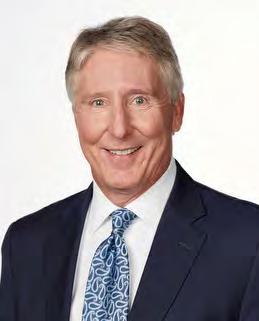
KEVIN REYNOLDS PRESIDENT

GM/COO
“President Reynolds’ constant support, encouragement, and positivity was an inspiration to the entire staff and set the tone for a positive member experience despite trying times during COVID and construction.
“His energy and enthusiasm have been motivating and contagious. During the most challenging or overwhelming moments, he never wavered in his confidence in our management team and our membership.”
And with those words, Bryan Stone, GM/COO of Westwood Country Club in Vienna, VA, paid tribute to Kevin Reynolds as one of BoardRoom’s Top Presidents for 2021.


The club’s board of governors had a tremendous amount on its plate in 2021 as the club strived for excellence.
President Reynolds set out the member experience as a priority at the board’s retreat and revisited that priority at every meeting throughout the year. To properly improve the member experience, the board first needed to understand the needs and desires of a rapidly changing club demographic. As President, Kevin Reynolds facilitated member surveys about club communications, the member dining experience, and club fitness operations. The survey results were incorporated into specific action plans that management implemented to satisfy the members’ interests.
“But we were careful not to let perfection get in the way of progress,” added Reynolds. “When there’s confidence in the management team and you respect the long-range and strategic plans that are in place, energy and organization will help these plans become a reality. Our board and committees appreciated and respected the great members who preceded us in these important roles. The guiding philosophy was to balance the new and old membership’s needs and move the club strategically to improved governance and member structures.”
President Reynolds also provided strong leadership for the club’s staff.
“From the beginning of his term, Kevin exhibited a perfect balance of governance and leadership. He achieved success throughout his presidency by respecting and encouraging the capabilities and potential of our talented management team,” GM Stone said.
Kevin Reynolds is the executive vice president, regional president and director of sales for United Bank. A graduate of The College of William and Mary, Reynolds earned an MBA in finance/business from GWU. He lives in Oakton, Virginia, with his wife, Stacey, their two children and two golden retrievers. BR
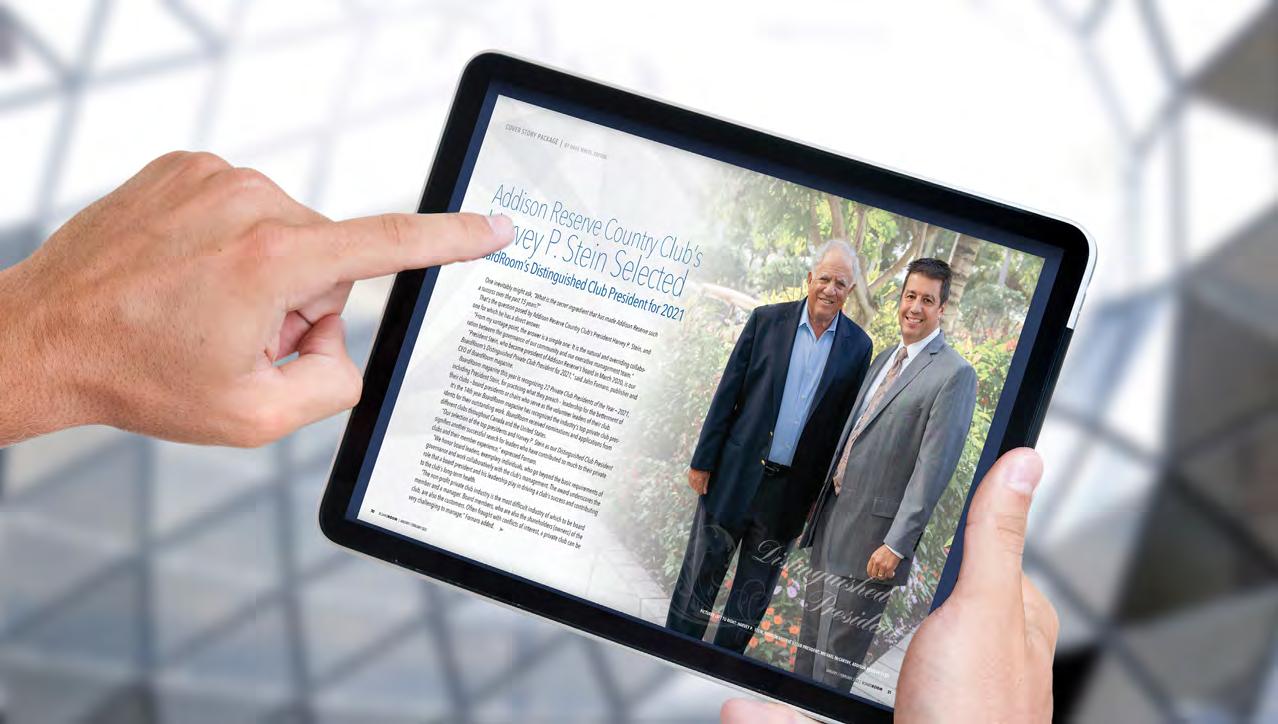



GM/COO
“Quail West’s mission ’to be the preferred residential country club community and workplace in SW Florida’, guides us in all our decisions and is supported by an atmosphere of candid and transparent communications,” said the club’s GM/COO Tony D’Errico.
And much of this derives from the leadership of Angelo (Angie) Rossi, one of BoardRoom’s Top Presidents for 2021.
“Member engagement has never been higher and we have elevated all aspects of the member experience, from F+B to golf to court sports to fitness. In the past two
years, Quail West has navigated COVID restrictions, final developer turnover and a revision of governing documents, with home sales and memberships exploding. The financial and operational future is very bright for ‘our little slice of paradise,’” explained D’Errico.
“Angie and the board have been incredibly supportive of our desire to evolve the member experience from a dated, ‘the answer’s yes, what’s the question’ model to a far more enlightened one – where ‘no’ must be said to a few to ensure the consistent delivery of enjoyable, repeatable, high-touch experiences to the many,” he added.
“The club’s governance model has evolved under the guidance of our COO and previous board leadership. A dedicated foundation board of directors embraces their fiduciary and strategic responsibilities and works together seamlessly with a talented management team to meet operational requirements and Member expectations. In addition, the long-term strategic plan is reviewed and adjusted annually, with an imperative to enhance our QW lifestyle and amenities to meet the needs of our ever-changing demographics, explained President Rossi.
President Rossi was a teacher and coach before starting his business career, where he ultimately led a global sales team for a multinational corporation. The intentionally collaborative and forward-looking style he developed along the way served him exceptionally well in this role.
“While he clearly understands where his responsibilities start and stop, Angie cares genuinely and actively for the well-being of every resident in our community and every employee in our organization – and it shows,” added D’Errico.
A native of Wilmington, DE, President Rossi and his wife, Jackie, moved to Quail West in 2014, retiring after a 30-year career as an executive with Avon Products. He graduated from Rutgers University and the University of Delaware with degrees in journalism and counseling. Angie is completing his second term on the Foundation Board, having served previously as golf and membership chair and vice president before becoming president in 2020. BR


A club is only as good as its leader. Under Kevin Snodgrass’ leadership, guidance, and vision, Houston Country Club has become the destination for high-end dining, facilities and service in Texas, with its rich tradition and history.
“As president, he was integral in the creation and development of the Club’s COVID-response plan as well as in the finalization, revision and execution of the club’s fouryear $109.1 million construction project,” explained Mark Bado, the club’s GM/COO.
He’s been instrumental in working with the construction committee and general contractor to revise the current project and plan the phased re-opening of the various new and refurbished venues.
“Kevin has made himself and the board transparent to the membership, opening up lines of communication, accountability and exchange that were extremely necessary as the club managed the COVID crisis while still undergoing an all-encompassing construction/renovation project,” he added.

President Snodgrass worked with the board to begin revising/updating Houston’s Club governance by establishing “best practices” and enacting committee structure change that included consolidating and eliminating duplicative and outdated committees while launching new, necessary committees.
He also labored with the general manager to establish measurable goals and objectives for that management position in alignment with the club’s goals and mission. He further shaped the club’s identity as the board committed to completing strategic planning and benchmarking the club’s operation by engaging professionals to help form the club’s long-term vision and plan.
President Snodgrass and the club’s management team co-operatively created and oversaw the evaluation of outsider brokers and relationships to ensure the club received the highest coverage at the most effective pricing.
And during his tenure, there was the development of key performance indicators, dashboards, a capital reserve study, a 5-10-20 year capital plan and a 5-year cash flow projection – all improved and/or new means of measurement and reporting for Houston Country Club.
During his tenure, he worked closely with the management teams in creating a new management team structure. “President Snodgrass had one guiding principle in all his directives and plans – any decision affecting the club and its operations had to be in alignment with the club’s long-range strategic plan and mission statement,” Bado explained.
As a club executive and a long-time member, he understands that all the policies and projects in the world will not be successful without a well-trained, appreciated staff to ensure the club’s operations run smoothly, efficiently, and economically. To that end, he’s been a staunch advocate of continuing education for the club’s management staff. He has supported their endeavors as active participants in professional associations such as CMAA, GCSAA, etc.
“He also understands how valuable a well-tenured staff can be in maintaining the traditions of a private club while working to continue to improve its member’s experience and satisfaction each time they visit their club,” Bado added.
President Snodgrass has served on the board of directors twice and has been a finance committee member; he served as chair of the green and grounds committee, golf committee, the banquet committee and vice president.
A native Texan, Snodgrass, a University of Texas graduate, has been a member of the Houston Country Club since 1994. He resides in Houston with his wife, Ann, and serves as vice chair of Cushman & Wakefield. BR
MICHAEL H. SOROKA, PRESIDENT


2021 President Michael Soroka worked cooperatively with 23 residential associations within this mandatory membership community.
Asked about his greatest achievement, he’ll say, “It was strengthening teamwork between the board, management, employees and membership in response to the COVID pandemic for the safety of the members.” Then, in the next breath, he’ll tell you it’s the modernization of the club’s governance.
The most recent governance action includes hiring GM/ COO Larry Savvides. “Larry’s vision and wealth of experience is the next step in our growth and we are dedicated
to remaining progressive and responsive,” said President Soroka, referring to the club’s 17-member board of directors’ revamped policies with a greater focus on future capital goals.
Under GM Savvides, management is laser-focused on elevating the club’s member experience. With Soroka’s full support, a forward-thinking direction has received overwhelming praise and enthusiasm from the members.
The club has had an explosion of new younger members and a new level of transparency using technology for communications. A holdover from early COVID days, televising board meetings on the community channel and “Larry Live” on Zoom for updates, has caught the membership’s attention.
“I’d define Michael Soroka’s leadership as inclusive, open and optimistic,” expressed Savvides.
“He is committed to leading by focusing on improving the way governance works. By teaming with consultants to adopt policies that include the opinions and future vision of the membership, he’s determined to stay ahead of the curve to elevate Hunters Run brand and status in the industry,” he added.
Following the retirement of the club’s chief operating officer, who served 23 years, it’s been a constructive new beginning at Hunters Run.
“I will always believe chairing the search committee and hiring the GM to be my most rewarding achievement,” explained Soroka. “It has made the lives of 1,600 households better. Larry has created enormous excitement among our membership and his expertise extends beyond operations to guiding the board to think as visionaries.
“Differentiating and positioning the club to be recognized as a national leader in the market is part of the long-term strategic plan Larry is developing,” Soroka added.
Born in Brooklyn, NY, Soroka grew up on Long Island rooting for the Mets, Jets and Knicks. After graduating from Rutgers & Fordham Law, he served first as a prosecutor and later as a criminal defense attorney for over 40 years. Last December, he and his wife Diane celebrated a half-century-long love story. BR


“Leading the renowned Glen Oaks Club has been an honor and a privilege that I share with many others,” said President Jordan Ziegler.
“Over my three-year tenure, I’ve had the support of an energetic board that focused on strategic vision alongside our GM/COO Marius Ilie and our management team. This team runs the club’s daily operations, based on the club’s culture of family serving family with our employees creating unique experiences for our members.”
“We consistently focus on developing the member experience through events, exciting programs and personalized services. Our team’s ongoing education, team building and goals have been increasing the member experience year over year, creating a memorable club experience,” said GM Ilie.
“Under Jordan’s leadership, Glen Oaks has also become the first Ladies European Tour certified venue in the U.S.A.
“Jordan is very humble, hard-working and a committed volunteer leader. He always has the best interest at heart for the club, staff and the membership.”
Always led by facts, President Ziegler has assisted the board in making educated decisions. “Jordan’s leadership model transforms a vision into a reality and he’s always a servant leader within our club governance,” Ilie added.
President Ziegler has been instrumental in setting the standards and goals between the board, committees and management. The board sets club policies and strategic vision; committees partner with the management team to ensure their support of club policies aimed at achieving the strategic vision. The management team runs the club’s day-to-day operations and delivers the strategic vision.
A senior partner at Pasternack Tilker Ziegler Walsh Stanton & Romano, LLP, Jordan handles workers’ compensation, personal injury and social security disability claims for the firm and civil service disability retirement pensions from New York City.
“’The needs of the many outweigh the needs of the few,’ balanced by the fact that sometimes, the needs of the few are just as equal to the needs of the many. I truly enjoyed every moment of my presidency,” Ziegler explained. BR

This concludes all the Top Private Club Presidents for 2021. The Top Private Club Presidents for 2022, listed on page 28, will be featured in the January/February, March/April and May/June 2023 issues of BoardRoom magazine. Congratulations again to all the 2021 recipients!
It’s vital to identify and select the right firm for your club’s executive search and consulting needs. We encourage you to take the time to discuss any prospective firm’s experience, process, capabilities, and follow-up. Below we highlight critical pre-screening questions you should be asking prior to engaging any firm. Requesting this information will increase the prospect of a successful partnership.
Be sure to ask…
Has the firm completed more than 1350+ projects over the last 20 years for 500+ club and private equity clients?
Let CTP tell you about the assignments that went well and what they’ve learned from the assignments that have not gone as well. Two decades of history.
Does the firm have a team of industry professionals with experience in the club and resort space that collaborates on all projects as a team to help improve productivity and efficiency, constantly thinking outside the box?
The CTP approach is for all the consultants to collaborate on every search. You get all of us all the time, not a single “consultant” who works independently.
Does the firm review the needs of the club from both the board and staff perspective to develop an individualized and fully custom position description and candidate specifications?
CTP organizes a full kickoff day on the club/resort’s property focused on learning the culture, business, team and needs to not simply write a compelling job description, but to be empowered to enlighten candidates on the opportunity.
Does the firm use number-one ranked recruiting ATS and CRM that a dedicated team (not a single person) updates daily with existing candidates, new candidates and details beyond the resume that must always be considered?
Each CTP team member spends hours each week providing color to every applicant that comes through the system.
Does the firm have a thorough client/club tested and proven successful candidate interview system including defined benchmarking of candidates to assist the search committee throughout the selection process?
Based upon 20+ years and over 1,350 assignments, CTP has a best practice, disciplined approach to candidate assessment.
Does your firm have an arsenal of solutions to deliver skill aptitudes testing including using the leading provider of behavior testing software and the global leader in personality assessments?
CTP deploys online personality, logic and skills testing along with several “old school” techniques that are tailored for the club’s specific needs to determine fit, beyond the resume/interview.
Does the firm use a social intelligence platform that pioneered the industry and is now the gold standard for online background screening?
CTP uses several third party, fee-based platforms to help discover a potential candidate’s social media, blogging and online presence.
How does the firm improve the probability of success when the placement is completed?
CTP creates customized onboarding plans and retreats that improve board and management alignment.
Are the search consultants experts in structuring compensation and bonus plans? Do they have industry experience with access to extensive industry trends, data points and local knowledge?
The CTP database contains thousands of compensation datapoints. CTP has constructed some of the most sophisticated comp plans in the industry. Several of the team members are certified in Performance Management form Cornell’s ILR school.
Will the firm create a customized “hands off” policy regarding not recruiting existing employees?
CTP does not recruit talent when the guarantee expires. CTP is clear who the client is.
Can the firm overlay a customized survey to gain perspective to capture quantitative and qualitative data to make truly informed decisions?
Denehy Club
Other Firms Thinking Partners
CTP uses the most sophisticated survey platform that will capture insights and analyze data to gain perspective in a systematic and comprehensive manner. 3 ? 3 ? 3 ? 3 ? 3 ? 3 ? 3 ? 3 ? 3 ? 3 ? 3 ?
Whether recruiting a senior level employee, evaluating an aspect of club operations, advising the board on governance, or strengthening your management team’s effectiveness, Denehy Club Thinking Partners is fully dedicated and equipped to be your thinking partner. To learn more, contact CTP today! Connecticut | Jackson Hole | California | 203.319.8228 | DenehyCTP.com











BONNIE J. KNUTSON
Bonnie J. Knutson, PhD, is a people watcher. A professor in The School of Hospitality Business, Broad College of Business, Michigan State University, Dr. Knutson is a member of the Country Club of Lansing and the Michigan Athletic Club. She can be reached via email: drbonnie@msu.edu
It was one of those beautiful Michigan summer days that we like to call a Chamber of Commerce Day.
Blue skies, a soft breeze off the “big” lake, temperatures in the mid-70s, and no humidity. In other words, it was a perfect day for cycling. So out came my Trek, helmet (yes, I always wear one), jersey and tights, cleated shoes, gloves, and mandatory water bottle. I was off pedaling with my riding partner along an old railroad track converted into a terrific riding path.
After a few hours, we came to one of the state’s quaint little lakeside towns. You know the kind. The ones that seem as if modern life has not yet reached them. Spotting a small coffee shop with an inviting outdoor patio overlooking the lake, we decided that we wanted something other than water and an energy bar. We were, after all, out for a leisurely ride.
their clubs. And everyone on the management team is thinking about how they will cope with renovation schedules that may have been delayed by supply-chain shortages and how they will navigate through the coming holiday season with the lingering issues surrounding staffing and supplies.
And oh yes, somewhere in all these projects, clubs must find time to build an engaging marketing strategy for the coming seasons. Well, move over 2022 and move on to 2023 and 2024. Because, after all, it is only “X” until the calendar year rolls over again. And it is not acceptable to pull last year’s marketing plans off the shelf, dust them off and use them again. We all know that members are looking for engaging things to do, fresh ideas and events that make their membership an integral part of their lives – their third place. Marketing trends are changing at warp speed. The rules say that to be effective, you must develop promotions that
As social media grew, so did the number of influencers, the size of their fan bases and their celebrity. But consumer mistrust began to surface, too. Recognizing this, brands have begun working hard to regain trust by carefully vetting proposed influencers, and by “upskilling their influence partners, ensuring they are more informed (to be) better ambassadors” for the brand. Clubs cannot be left behind. The opportunities to successfully integrate influencer marketing into your overall marketing strategy are endless. But, as other brands have learned, you must do your homework to find the right influencer for the right partnership with your club.
As we sat there reading about the tempting coffee drinks and irresistible pastries being offered, our server came over to take our orders. After a few minutes of friendly chatter, she commented on how great it was that we were out enjoying the beautiful weather because, after all, it was “X” number of days until Christmas.
Yikes! I did not know whether to finish ordering my cappuccino or rush home to begin writing my Christmas list. The old saying about how time flies seems truer now than ever before, especially with our post-COVID operations. Northern clubs are finishing the hustle and excitement of the warmer seasons, again filled with golf tournaments, tennis leagues, pickleball lessons, family swim parties, and dining on the patio. Southern clubs are getting ready for a massive influx of snowbirds and the activity they will again bring to
target your membership on relevant platforms – whether social media, websites, in-club messaging and even oldguard “snail mail.” You need to have a compelling story and be able to measure the effectiveness of that story with analytics. While these rules still hold, marketing is evolving so fast that it is hard to recognize new trends, especially with the ever-growing number of media platforms.
As we all know, the change overarching all trends is, of course, how your members are consuming information. Couple this with the countless other things that are competing in the same space for their time, money, and loyalty – from online streaming to watching a son’s/daughter’s soccer game from the sideline to ordering supplies through Amazon to looking at silly animal videos on YouTube – and you have
the landscape in which all other trends will be in effect.
Currently, the biggest marketing trend that your club can add to your 2023 – and beyond – marketing strategy is a spin-off of word-of-mouth advertising, which has given rise to influencer marketing. If you do not think this influencer movement is big, think about the Portuguese football star with more than 475 million Instagram followers.
What about Dwayne Johnson, better known as The Rock, who boasts 334-plus million followers? Or social media veteran Rickie Fowler, with more than 501,000 Instagram followers, more than 50,000 Facebook followers, and more than 938,000 Twitter followers.
But being an influencer is not just for celebrities. With more than 1.7 million followers on TikTok, Niki Patton offers advice on college-related videos to incoming first-year college students, including hints about such things as move-in day, school parties and safety tips. She even details the things students do not need for college life. How would you like to have your club’s brand on that list with 12.6-plus million viewers for a social event or a graduation dinner?
Influencer marketing has traditionally been the bastion of industries such as beverage/snack companies, auto manufacturers, sports equipment companies, and even clothing brands. Why? Because it has been working. More than 90 percent of professionals use influencer marketing to:
• Increase the awareness of their brands to a wider market. Think about how this can impact new member recruitment or even upsell current members to a higher membership level.
• Build trust in the brand or one of its products or services. Think, too, about how this can boost attendance at a future event or result in more sales in the pro shops and bookings in spa services and/or private lessons.
• Set a new trend. In an earlier BoardRoom article, I wrote about one of my favorite go-to websites for fresh ideas. So I am taking the liberty of repeating my admonition to “take some time to scroll through Nationaldaycalendar.com/ calendar-at-a-glance/. This is a website that lists hundreds of national days, weeks and months, and it is a gold mine for ideas that you can use to refresh existing marketing
strategies and/or develop new ones to generate interest and excitement in your (membership).”
Clubs have yet to enter the influencer fray. And while yours will probably not be able to partner with notables like Rickie Fowler, opportunities do abound.
For example, the pro shop could team up with a member who may have just won a statewide amateur event to tout the equipment used in the championship and available through the club. A member noted for his/her baking prowess could publicize a baking course offered by the club’s chef along with a book of “secret” recipes developed specifically for your club.
And, of course, there are always the teens, who with their TikTok presence can publicize the exceptional fun (never forget the ever-presence photos they take for Instagram) they have at the club. (Remember, too, that they will be tomorrow’s members.)
In the 19th century, merchants hired men to wear sandwich boards and walk up and down the street promoting their brand to those they passed. From this meager beginning, marketing trends have evolved to leverage the newest technologies and shift strategies to meet the changing needs of the marketplace. Originally, influencers were bloggers who shared their experiences about a given product or service with their families, friends and followers. They were so-called regular people whose opinions were trusted.

As social media grew, so did the number of influencers, the size of their fan bases and their celebrity. But consumer mistrust began to surface, too. Dija Ayodele, the founder of Black Skin Directory, points out, “People are questioning influencers’ integrity, especially if someone is marketing a product but without some level of qualification.”
Recognizing this, brands have begun working hard to regain trust by carefully vetting proposed influencers, and by “upskilling their influence partners, ensuring they are more informed (to be) better ambassadors” for the brand. In other words, they are doing their homework.
Clubs cannot be left behind. The opportunities to successfully integrate influencer marketing into your overall marketing strategy are endless. But, as other brands have learned, you must do your homework to find the right influencer for the right partnership with your club.
Your bottom line will thank you. BR

JARRETT CHIRICO
Jarrett Chirico, USPTA, PTR, PPTA, PPR, PPTR was until recently director of racquets at Baltimore Country Club, Baltimore, MD. He is now director of racquets at Royal Oaks Country Club, Dallas, TX.
One of the most unique and vital relationships within the hospitality industry is between a general manager and a racquets director.
Racquets has seen an unimaginable boom through its offerings, bringing members of all ages and abilities to the courts. No longer is a club divided between tennis and golf. There is a continual and consistent cross-over between all membership tiers for the first time, leading to a surge in membership globally. Members are discovering more value for their dues and spending more time and money at their clubs. As waitlists for golf grow, racquets has become the starting point for new members, quickly becoming a first impression that lasts forever.
Unfortunately, the relationship between general managers and racquets directors is usually an afterthought. As the industry has moved away from tennis and toward racquets, the demands on our leaders have increased. Racquets directors must program, market, teach and, most importantly, staff multiple racquet sports. They are responsible for connecting the dots between all amenities offered and, as a result, are seeing growing numbers across the board. Most racquets directors are treading water, learning on the fly, and trying to keep up with demand while striving to exceed expectations. These challenges provide one of two outcomes: a deeper connection between a general manager and director or a more significant divide causing good people to look elsewhere.
Search and consulting agencies are seeing a record number of new clients. In many cases, general managers and clubs rely on the advice of these agencies to structure compensation packages and find candidates; however, it’s never the job of a search company to dictate compensation. Search companies should focus on finding the perfect candidate (a candidate who may not be looking) to fit the club’s needs. After identifying an ideal candidate, search companies are compelled to communicate the cost associated with employing that individual. As in any business, leaders are an investment. An investment in time, understanding, and money. Every state, region, and club has the unique ability to offer different packages that meet the club’s needs and the needs of the leader they want.
It’s not “one size fits all,” and most search companies don’t understand the club, culture, or region. The best search companies will talk to clubs to understand what they are looking for and then explain how to find the perfect fit. It all starts with general managers and clubs doing their research and understanding one of the essential parts of the club that has long been overlooked.
The clubs that achieve the highest level of success have leaders who let their leaders lead. True leaders lead with a long leash. I have always been blessed to work with passionate, dedicated, and inspired general managers who have helped mold me into the leader I am today. They all had the same thing in common: They continually asked what I needed from them. They understood the need to hire the best and invest in them, so their directors could invest in their people, who then take care of the members.
Success is a partnership. It’s support, compassion, and working toward a common goal. It’s ensuring that we take care of our people so we can keep them. It’s also celebrating those that do leave our clubs better than they found them and remembering the success shared.
As we continue to accelerate into the age of racquets, it’s time to truly understand racquets and the role it plays in membership fulfillment and retention. Finding the right people who can push your programs further is crucial. No one on staff knows a club better than the general manager, who is responsible for the culture and, in return, the staff’s happiness.
The challenge is finding the time to understand. To talk with other directors and general managers about how they found their people and what they do to support them. Understand the many compensation packages across the country and get creative on how you can attract the very best talent. Then go even further and see what you can do to keep them. I promise that if you take the time to invest in racquets, the leaders you attract will take the time to invest in you. The most extraordinary relationships you make might happen at racquets. BR



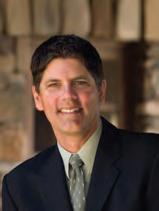
DAVE MOYER
Dave Moyer is a USPTA Master Professional and the director of racquet sports at The Country Club at DC Ranch in Scottsdale, AZ. He can be reached at dmoyer@ccdcranch.com
Clubs, resorts and city facilities have many options with court sports, and most court sports, if not all, are seeing a boom in participation.
Whether you are talking about tennis, pickleball, padel, POP or platform, there has been a steady to sharp rise in play over the past two years.
The rise in these sports has also created an interesting dilemma for clubs as they navigate what court sports amenities they should offer and the cost of adding facilities to accommodate the growth and members’ needs.
In order to make the right decisions for your club, you first need to understand what each of the sports can bring to your club and what the state of the industry is for each of them.



Despite the rhetoric you may hear from fans of the other court sports, tennis is still the king of club court sports. Over the past two years, tennis has seen an increase of 4.9 million tennis players to a total of 22.6 million players, according to the Physical Activities Council participation report.
This has also resulted in an increase in sales of rackets and other merchandise as well as instruction across the country. Data from the Tennis Industry Association shows a 46 percent increase in dollars to $123 million in racket sales. These numbers impact a club’s revenue and member satisfaction if you are engaged in tennis at your facility.
It is not the time to take away tennis courts. Instead, clubs should look to grow and build more courts. Pressure from pickleball players has resulted in clubs not having enough tennis courts.
Pickleball and tennis should work together instead of against each other at your facility.
Most of you have heard that pickleball is the fastest-growing sport in America, and that has been true from a percentage standpoint. According to USA Pickleball, the sport has sustained an 11 percent growth each year on average over the past five years and now boasts 4.8 million players.
Tennis saw the same number of new players over the past two years as pickleball has total. It is still significant, and every club should work toward a separate pickleball facility to sustain growth and member satisfaction for both amenities at your facility.
If your club is in the upper Midwest or the northeast part of the country, chances are you already have platform. Platform tennis is a great way to keep your members active and engaged in the cold winter months when they do not use your club as much. Platform players spend more money on food and beverage during that time.
Padel and POP are both growing sports, with padel leading the way in Latin America, Spain and other European countries. There are about 8 million players worldwide, and the growth is starting to be seen in the United States to the point where padel may soon claim to be the fastest-growing sport in America from a percentage standpoint.
POP does not require too much added expense with building facilities. The sport takes place on a 60-foot tennis court, which many clubs already have lined on their courts.
The bottom line is court sports are a necessary and growing amenity for your club, and now is the time to plan for growth and facility upgrades. The state of the racquet sports industry has never been better. Use that popularity to become a leader in your competitive set. BR


The BoardRoom magazine “Excellence in Achievement” Awards is the only private club industry award that recognizes the clubs’ business partners. BoardRoom magazine’s industry peers review and select these outstanding suppliers and consultants, which represent various aspects of course and club operations.
Winners, each year, are selected for overall excellence in their respective fields, achievements, innovation, vision for future growth and continued impact on private club operations.
“The BoardRoom Awards are the only awards in the private club industry that recognize private clubs’ business partners, and every year we see increasing innovation, achievement, a vision and dedication from BoardRoom Award recipients. And of course, private clubs are the beneficiary of outstanding work of the industry’s vendors,” said John Fornaro, publisher of the BoardRoom magazine
The BoardRoom magazine is the only publication of its kind that is designed to educate the board of directors, owners, general managers and department heads of private golf, city, yacht, tennis and country clubs about issues concerning all aspects of the club, golf course management and operations.
LIFETIME ACHIEVEMENT*
Kevin Reilly
Dan Denehy
GARY PLAYER EDUCATOR*
Ryan Doerr (Strategic Club Solutions)
Rick Ladendorf (Mindful ‘U’)
Craig Marshall (Mindful ‘U’)
DAVE WHITE EDITORIAL AWARD
Dave Doherty
JOHN FORNARO INDUSTRY IMPACT AWARD*
Robert DeMore
Carmen Mauceri
JAY DI PIETRO VENDOR
XHIBTZ Contract Furnishings
NEW PRODUCT*
Benshot glassware
NBC Sports Next
AMENITIES PROVIDER
Duffy’s Tri-C Club Supply
ARCHITECTURAL PRODUCT
NanaWall
ASSOCIATION
Association of Club Catering & Event Professionals

BAR RENOVATION
Kuo Diedrich Chi
BRANDING/COMMUNICATIONS
Strategic Club Solutions
BUSINESS INTELLIGENCE SOFTWARE
Jonas Club Software
CASUAL DINING RENOVATION*
Peacock + Lewis - Architects and Planners
Larson Nichols
CHAIR MANUFACTURER*
Eustis Chair
St. Timothy Chair
CHILDRENS’ PROGRAM
KE Camps
CHINA
Corby Hall
CLUB ENTERTAINMENT
The Members Only ShowMichael Gutenplan
CLUBHOUSE
‘USE OF NATURAL LIGHTING AND LANDSCAPE’ PHX Architecture
CLUBHOUSE BUILDER AND PROJECT MANAGER
ClubDesign Associates
CLUBHOUSE RENOVATION AND INTERIOR DESIGN
GGA-Architecture collaboration with FRANK Architecture & Interiors
CLUB MANAGEMENT SOFTWARE
Northstar Club Management Software
CLUB MANAGEMENT SOFTWARE – MOST INNOVATIVE
Northstar Club Management Software
CLUB MEMBER ANALYTICS
Jonas Club Software
CLUB PHOTOGRAPHY
E.A. Photography
CLUB SIGNAGE
Signera
CLUB SUPPORT
Jonas Club Software
CLUBHOUSE DESIGN*
Marsh & Associates, Inc.
PHX Architecture
CLUBHOUSE RENOVATION DESIGN*
C2 Limited Design Associates
Peacock + Lewis - Architects and Planners
CONSULTING COMPANY* Chambers
Strategic Club Solutions
CREATIVE FOODS
Frozen Solutions Ice Cream
CUSTOM DESIGN HOSPITALITY UNIFORM Ambassador Uniform
CUSTOM DESIGN OUTDOOR FURNITURE
XHIBTZ Contract Furnishings
DATA PRIVACY SOLUTIONS
CSR Privacy Solutions
DRIVING RANGE PRODUCT
Inrange
ELECTION MANAGEMENT SYSTEM
Survey & Ballot Systems
ENVIRONMENTAL COMPANY*
Wausau Tile
Bambrella
EXECUTIVE SEARCH FIRM
Kopplin Kuebler & Wallace
FINANCE AND BANKING
Midfirst Private Bank
FITNESS DESIGN
Castor Design Associates
FITNESS EQUIPMENT
Technogym
FLOOR MATTING
Proform™ Premium Matting & Commercial Carpets
FOOD & BEVERAGE PRODUCT
Emersa WaterBox
FOOD & BEVERAGE TECHNOLOGY PRODUCT
System Concepts, Inc. / FOOD-TRAK
FOOD SERVICE STRATEGIC PLANNING
RealFood Hospitality, Strategy and Design
FURNITURE MANUFACTURER
Gasser Chair Company
GOLF CART COMPANY
Yamaha
GOLF COURSE MAINTENANCE FIRM
International Golf Maintenance (IGM)
GREEN PRODUCT
Vivid Leaf
HISTORIC CLUBHOUSE RESTORATION
HINT | Harris Interiors
HOSPITALITY UNIFORMS
High-End Uniforms
HUMAN RESOURCES
Gecko Hospitality

INSURANCE
Preferred Club
INTERIOR DESIGN MEN’S LOCKER ROOM
Bozeman Club & Corporate interiors
INTERNATIONAL STAFFING
MTL International Work and Travel
KITCHEN EQUIPMENT
Montague
LAW FIRM
Addison Law
LOCKER COMPANY
Salsbury Industries (metal)
Hollman, Inc. (wood)
MANAGEMENT COMPANY
Troon
MARKETING COMPANY
Strategic Club Solutions
MASTER PLANNING*
JBD JGA Design and Architecture
C2 Limited Design Associates
MEMBER VETTING
Kennis
MEMBERSHIP ANALYTICS
Clubessential
MEMBERSHIP MARKETING
Creative Golf Marketing
MEMBERSHIP SURVEY
McMahon Group
MOBILE APP
Cobalt Software
ONBOARDING SOFTWARE
Pipeline Marketing
OUTDOOR BAR LOUNGE DESIGN
Angela Grande (Montclair)
OUTDOOR ENHANCEMENT PRODUCT
The Verdin Company
OUTDOOR FURNITURE
Telescope Casual Furniture
OUTDOOR LIVING STRUCTURES
SYZYGY+AZENCO
OUTDOOR TERRACE
Rogers McCagg Architects, Planners, Interior Designers
PAYROLL PROGRAM
ClubPay
PRO SHOP DESIGN
AM Design group (Shadow Wood)
PROCUREMENT PROCESS MANAGEMENT SYSTEM
Clubessential
PURCHASING COMPANY
XHIBTZ Contract Furnishings
REAL ESTATE SERVICE
Hilda W. Allen Real Estate
RESORT AND HOTEL MANAGEMENT SOFTWARE
Jonas Club Software
SOCIAL MEDIA
Pipeline Marketing
SPA DESIGN
Larson Nichols
STAFF TRAINING COMPANY
RCS Hospitality Group
STRATEGIC PLANNING
McMahon Group
TAX CONSULTANT
PBMares
TECHNOLOGY PRODUCT TRAINING
Clubessential
TENNIS COURT BUILDER
Welch Tennis
TENNIS MANAGEMENT
Cliff Drysdale Tennis
UMBRELLAS
Bambrella
WEBSITE COMPANY
MembersFirst
WELLNESS FACILITY
Kuo Diedrich Chi
WINE ROOM/ DINING DESIGN
Castor Design Associates
WINERY
Flora Springs
WOMEN’S RESTROOM AND LOUNGE
Chambers
*Denotes Tie

Bel-Air Bay Club Mission Statement: “We promote the tradition of a friendly, social, and recreational environment for our members in a safe, attractive, and well-maintained facility, assisted by a caring staff.”
In 1927, Bel-Air Bay Club opened its doors as a “Country Place by the Sea” in Pacific Palisades, CA. Created by real estate visionary Alphonzo Bell, the club was intended to be a home-away-from-home. Ninety-five years later, Bel-Air Bay Club is just that and more.
Bel-Air Bay Club sits on a quarter mile of pristine beachfront property in Pacific Palisades, an affluent Los Angeles neighborhood located between Malibu and Santa Monica. The club has two neighboring facilities and spans 17 acres. The Lower Club is a beachfront members-only clubhouse with 104 cabanas, five dining outlets, world-class bocce and paddle tennis courts, sand volleyball, a fitness center and a basketball gym.
The Upper Club is a cliffside venue that hosts 200 weddings a year, with guest rooms offering expansive ocean views from above.
Bel-Air Bay Club offers an entirely market-driven equity membership, with post-pandemic prices nearing an all-time high. According to Bel-Air Bay’s general manager Bill Howard, “It’s not just an investment. It’s a lifestyle change.”
The club offers something for everyone, from parents to kids. “This is the whole family’s ‘happy place.’ But, often, it’s the kids dragging the parents to the club because it’s so much fun.”
It’s no surprise that Bel-Air Bay Club is famous for its incredible location, which has been a part of several Hollywood productions over the years. From the moment you walk through the front door, you’re looking through a window to the sea.
This is the only beach club in Southern California where you can enjoy dinner and drinks right beside crashing waves. For the members, however, it’s the staff that sets Bel-Air Bay Club apart from the rest.
You can’t overlook the Employee Scholarship Fund to really understand just how much the staff means to the members. In 2019, the members formed a new committee to offer scholarships for the employees, their children and grandchildren. In its first year, eight students received scholarships!
There’s an incredibly long tenure among the staff – from those in maintenance and housekeeping up to the general manager. Forty-seven employees have been with the club anywhere between 10 to 42 years! If you ask the employees why they stay, you’ll receive one of two answers: “I love the people” or “I love what I do.”
Bill’s secret to keeping staff is, “Pay them well, offer great benefits, embrace them and make them feel appreciated. Plus, happy employees will create better service!”
A general manager’s average tenure at a private club is three years, but GM Bill Howard, who is scheduled to retire, has served Bel-Air Bay Club for 21 years. Member Michael Wojciechowski said, “Hiring Bill Howard was the best thing to happen to Bel-Air Bay Club.”
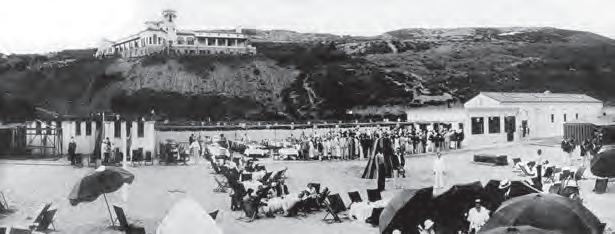



Dedicating so many years of service to one individual club creates a deeper understanding of the membership to provide more effective solutions. Bill, upon his retirement, passed the torch to Barrett Eiselman.
Bel-Air Bay Club is a social and athletic club, and according to member Mark Tabit, “Bel-Air Bay Club started bocce in Southern California.” The club has three bocce leagues playing three times per week, with 250 members actively involved.
Carnival Bocce is a popular zany tournament offering dancing, a live DJ, drinks and best-dressed competitions – all happening throughout the tournament. “When bocce season is over, it’s a completely different club,” Bill revealed.
The members have their own slogan, “We have more fun”, and if there’s one thing Bel-Air Bay Club really knows how to do, it’s throw a party. The highly profitable Upper Club subsidizes member events at the Lower Club. This allows the club to bring in well-known bands like Berlin, the Fabulous Thunderbirds, Yachtley Crew, English Beat and more.
Ask anyone at the club and it’s no surprise that the biggest party of the year is on the 3rd of July, taking over both clubhouses. The Lower Club’s Big Bash draws 2,000 guests, while the Upper Club has a more refined Salute to America with 200 guests. The spectacular fireworks are shot from a barge in the middle of the ocean, with fireworks exploding above the guests’ heads.
Halloween, another major event, brings in 700 guests and occurs the Saturday night before Halloween, giving the kids an-


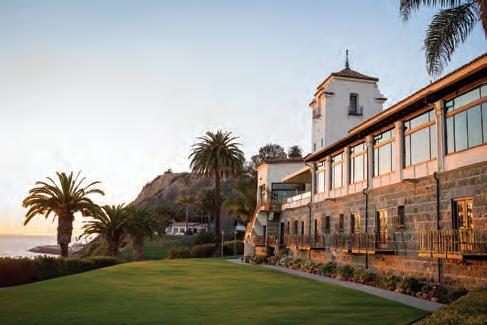

RONALD BANASZAK
Ronald Banaszak, CCM, CCE, BoardRoom Distinguished Club Executive Vice President of International Business Development. Ron may be contacted at (415) 420-5183 or ronbanaszak@gmail.com.
other opportunity to wear their costumes. In addition, all 104 cabanas participate in a cabana decorating contest and kids visit the cabanas to trick-or-treat.
The haunted house, known to scare even the toughest dads at the club, remains the showstopper of the evening. Each year, the haunted house has a new theme and professional live actors are hired to amp up the fright meter.
If you think the over-the-top events stop there, think again. The members created their own holiday called Bel-Air Bay Club Day and have hosted their own Olympic games. Even though the conventional option for a photo from the above would be to send out a drone, Bel-Air Bay Club had a bigger and better idea. The club hired a helicopter, blasted “Flight of the Valkyries,” and took to the skies to capture a beautiful panoramic picture with members waving from the beach.
And Bill Howard has some advice for other general managers: “Try it – even if you don’t believe it will work. The members will be happy just because you listened to them and made it happen.”
So, what is it that really makes Bel-Air Bay Club so special? For some, it’s the events. For others, the athletics, and or everyone, it’s the people. “It takes exceptional leadership to pull off these events. We are creating moments and memories, which create a sense of belonging in our community,” said member Jimmy Dunne.
Bel-Air Bay Club has a practically unheard-of 97 percent membership satisfaction rating. The average satisfaction rate among private clubs typically ranges between 70 to 79 percent. This has a lot to do with the family-like culture, fun atmosphere and proactive facility maintenance in a highly corrosive environment (salt water).
Member Jill Baldauf believes the high rating is reached because the management is exceptionally transparent. In addition, members’ voices feel heard by allowing members to voice their thoughts and opinions.
Bel-Air Bay Club also has a Leadership Development Committee, which Bill Howard believes should be a best practice for all clubs. Member Pam McGranahan states this committee implements a conscious effort to engage the members when the club has a need, pulling from various ages and expertise.
GM Howard’s philosophy of transparency is to “never throw surprises and always give more information than necessary.” He has maintained an interactive relationship with President Elizabeth Mullan and they speak at least three times per week about club updates. Mullan attributes the club’s success to the clear communication between the management, board of directors and members.
In fact, President Mullen was selected as one of the BoardRoom’s Top Private Club presidents for 2022 because of her outstanding leadership. Private clubs, such as Bel-Air Bay, to receive BoardRoom’s Distinguished Club designation, are rated on the member experience, unlike other recognitions.
“I love that they (The Distinguished Club auditors) physically come to the club, talk to members and see what we do. They become members for a day,” added Howard.
While the members say they already know the club’s value, it makes all the difference to hear it reaffirmed. Member Jill Baldauf said it best: “Why would you ever leave the club?” BR

DAVE DOHERTY
Dave Doherty is CEO and founder of the International Sports Turf Research Center, Inc. (ISTRC) and holds three patents regarding the testing of sand and soil-based greens. He can be reached at (913) 706-6635 or via email: daveistrc@hotmail.com
While visiting one of the PGA tour courses recently, I was asked this question: In resurfacing greens what is the most important thing to consider?
The question threw me for a moment because there are so many different factors involved.
The quality of irrigation water for instance will tell us if the greens’ mix needs to be one that will accommodate frequent flushing. What level of handicap golfer is your club trying to accommodate? This will dictate greens’ speed and firmness.
What is our budget and what are our resources, will they be adequate to accommodate the type of turf you are contemplating using for resurfacing? What is the one event that requires the greens to be in their best condition? This is also a major factor in turf type selection.
root zone after removal of the top four inches. The physical analysis includes measuring the root zone for infiltration rates, water holding, air pores and compaction as well as the PSAs and organic levels from the new surface to the gravel layer, in one inch increments.
This information allows for decisions to be made about the remaining root zone and what corrective measures may need to be taken, if any.
With no grass on the greens it is now the perfect time see if the drainage system has been compromised both under and outside of the greens’ cavity. With 20-year old greens it is not uncommon to have had new irrigation installed and drainage tiles severed in the process.
Using a camera snake to inspect the drain tiles both under and running away from the green and perform any neces-
This PGA course must overseed every year, resulting in an organic build up from the dieback of over-seeded plants. These are the two main reasons for this course considering a re-grassing and bringing the root zone down from the 16-inch depth to the original 12-inch depth recommended by the U.S.G.A.
And it’s an excellent opportunity to reshape the greens.
After all of these questions have been addressed adequately and a decision made on turf type, you need to address the issue of the greens’ mix most desirable for the turf type selected.
This particular tour course has had almost four inches of root zone mix added over the last 16 years because of light frequent top dressing. About a quarter inch of build up per year is normal for the climate in which this course is located.
This PGA course must overseed every year, resulting in an organic build up from the dieback of over-seeded plants. These are the two main reasons for this course considering a re-grassing and bringing the root zone down from the 16-inch depth to the original 12-inch depth recommended by the U.S.G.A. And it’s an excellent opportunity to reshape the greens.
The first step in this re-grassing, from the greens mix aspect, is to identify the physical properties in the remaining
sary repairs at that time. This is also an excellent time to check the gravel layer for porousness. Irrigation water containing high sodium and bicarbonates can cause gravel to solidify and prevent water from entering into the drain tiles.
It is also the absolutely perfect time to install four-way gas intercept visual ports with slide/gate valves off the greens. By installing these four-way ports outside of the greens’ cavity in the drainage tiles outfall/drainage areas you are able to maintain the legal status of being within USGA recommend specifications. BR Dave Doherty is the recipient of the Dave White Editorial Award.




ANGELA HARTMANN
Angela Hartmann is GCSAA associate director, communications
To learn more about GCSAA’s wide range of continuing education opportunities for the golf course management industry, visit gcsaa.org.
Survey conducted by Golf Course Superintendents Association of America also shows increased implementation of water best management practices at U.S. courses.
Golf courses in the U.S. used 29 percent less water in 2020 compared with usage in 2005, according to recently released survey data. The 2021 survey was conducted by the Golf Course Superintendents Association of America and funded by the GCSAA Foundation as part of its Golf Course Environmental Profile program, which began in 2005.
The report found that U.S. golf facilities applied approximately 1.68 million acre-feet of water in 2020, a 29 percent reduction since 2005. Two-thirds of the reduction was likely a result of operational golf facilities applying water more efficiently.
The survey results from nearly 1,600 golf course superintendents were collected and independently analyzed by scientists Travis Shaddox, PhD, of Bluegrass Art and Science LLC, and J. Bryan Unruh, PhD, University of Florida, and the National Golf Foundation, which published the findings for peer review before making the information public.
“Data from the 2021 water use benchmarking survey show that golf course superintendents continue to reduce water use at their facilities. The survey results indicate a 9 percent reduction in applied water since 2013, totaling a 29 percent reduction since the inaugural survey was con-

ducted,” Unruh said. “Similarly, the median acre-feet per acre, a measure of water use efficiency, has improved by 23 percent since 2005.”
The most common sources of water, according to the report, were wells (32 percent) and lakes and ponds (23 percent). Less water was applied in 2020 from each water source than in 2005, except for recycled water, which accounted for 21 percent of water applied.
Golf course superintendents have also increased the use of best management practices that can lead to reductions in water usage. BMPs such as keeping turf drier, pruning tree roots, changing to a more drought-tolerant turfgrass, mulching landscape beds and increasing no-mow acres were significantly associated with reductions in applied water.
The study also provides data on average water use in the seven different agronomic regions of the country. Decreased water use was seen in every region. The greatest water use applied per acre happened in the Southwest and Upper West/Mountain – regions with high average temperatures and low average rainfall.
“Golf course superintendents are responsible stewards of water resources, and the latest national survey results demonstrate that,” said Rhett Evans, CEO of GCSAA. “Superintendents are committed to efficient water management and have implemented evidence-based best management practices that result in reduced water use. All golf facilities should maintain a BMP manual and strive for continuous improvement as water management plans are an important aspect of BMPs and overall environmental sustainability.”
As part of the third series of its Golf Course Environmental Profile program, GCSAA will publish two additional national surveys related to golf course management over the next two years. To learn more and to see the complete survey report, read the August issue of GCSAA’s GCM magazine at gcmonline.com. BR





COREY SABAN
Corey Saban, a former Emmy-nominated and award-winning TV journalist, educates general managers and their teams on handling the media before and during a crisis, presentation training and brand equity improvements. Corey@csmediaworks.com
Every GM will deal with a crisis that will get media attention. How you respond affects your club, your brand, and your reputation.
Just look at the headlines from the past year alone. Of course, there was COVID-19, but clubs also dealt with accidental deaths, murder, embezzlement, natural disasters, and more.
Your first inclination is to say “no comment” and shoo the media away. But that is the worst thing you can do. No comment kills. No comment assumes guilt, especially when the reporter gets on the air and says with a dramatic pause, “XYZ club had no comment.”
The other approach I most often dealt with in the news was the “let’s wait and see approach,” essentially burying your head in the sand. When you bury your head in the sand, you look like the part that sticks out. This approach never works because while you’re waiting, someone else is speculating and putting you in a negative light.
When you choose not to speak or say no comment, the reporter must still do the news story. The reporter will always find someone who wants his or her 15 minutes. The reporter will find an employee or a member through social media or wait outside the entrance with a camera and a microphone and ask general questions to get a soundbite. Trust me.
I have many colleagues who have had to do this. A reporter will ask emotional questions such as “How does it make you feel knowing an (insert scenario) happened at your club?” And yes, the reporter will get a response, such as “Scary” and “I can’t believe it happened here.” Simple soundbites give the reporter enough to put together a story but without your side because you went with “no comment.”
Instead, it’s essential that you do the following: predict, prepare and perform.
Anticipate the problems that could go wrong that garner media attention. If you are not sure, Google country clubs and scandals. From there, create a team of no more than five diverse managers for the new crisis management team.
This team will have roles:
• Two spokespeople for the media (one is a backup)
• Someone to inform members with a statement
• Someone to inform staff with a statement
• A person to monitor social media.
This team will create holding statements, which brings us to the second P: prepare. Holding statements are short statements that go to the press in times of crisis to allow you to gather more facts while something is under investigation or happening in real time. A good example is the one below for the accidental death of a colleague.
“We are heartbroken and devastated by the passing of our colleague, (member) (individual’s name), after an accident which occurred at (location) in (where did it happen) during the (short description of circumstance). (Individual’s name) is beloved by all who worked (or knew him/her) with him/ her during an impressive (__)-year career. (That part comes out if a member.) I, along with (individual’s name) ‘s coworkers and the entire team, wish to express our deepest condolences and our heartfelt love and support to (individual’s name) ‘s family and friends at this challenging time. We have no further details but are working closely with investigators as they review the incident. We will be providing updates as they are released to us.”
Lastly, perform. Practice is everything. Role-play with the team on how to speak with the media. Prepare for baiting questions, such as hypotheticals. “Hypothetically, if you knew this person would do this would you have allowed them here?” The answer is never yes or no because the reporter will steer you in any direction the reporter wants. Instead, say: “We don’t deal in hypotheticals, we deal in facts, and those are all in the police report, which is public record.”
Preparation is everything because whether it’s a print reporter, a TV reporter, a podcaster, or an online blogger, someone could try to twist your words, so be aware of the tips and tricks they will use.
Remember: The secret of crisis management is not good versus bad. It’s preventing the bad from getting worse. BR


NANCY BERKLEY
Nancy Berkley is an expert on women’s golf and junior girls golf in the US. Nancy is a member of the World Golf Foundation Women’s Committee and the National Golf Foundation. She shares news about women’s golf — along with her opinions — on www.nancyberkleygolf.com. Nancy has served on the governing boards of two golf clubs and is on the green and marketing committees at Frenchman’s Creek Beach & Country Club. She is a contributing writer for LPGA publications
Ten years ago, my husband and I were new members at Frenchman’s Creek Beach and Country Club in Palm Beach Gardens, FL.
We were having dinner in our casual dining room and noticed another couple at the next table. We asked them to join us and learned that Marie and Saul were also new members. We raved about the club’s food, services and staff as well as the tennis and golf programs. When we recognized that Frenchman’s Creek did not offer members the opportunity to volunteer in community schools or organizations, we jointly landed on our mission to establish a volunteer program and selected Volunteer Match Program as its name.
We embarked on a broad due diligence program. We visited other clubs to learn about their member-volunteer efforts. We surveyed our members about their volunteer backgrounds and views on what types of volunteer opportunities fit their interests and experiences. Our plans for a volunteer program were coming into focus. With guidance from our marketing department, we were ready to go to our board of directors for approval of the program. The board approved, and our work began.
We launched our Frenchman’s Creek Volunteer Match Program with a “showcase” event. Over 30 local not-for-profits attended, including schools and hospitals. We wanted to build relationships. We communicated often with schools. Elementary schools welcomed our members as aids for reading programs. About six members regularly visited Grove Park Elementary School to help students improve their reading and writing skills. We welcomed new ideas. One member, a former New York private equity manager, taught a junior high school class about financial balance sheets. Several members coached graduating high school students on interview skills. We established a relationship with the Literacy Coalition of Palm Beach County, and our members review essays written by adults learning English.
When COVID-19 challenged our in-person programs and events, we became creative. Student essays from the Literacy Coalition were faxed to us and our member comments were sent via computers back to the Literacy Coalition. We



increased our focus on programs with less personal contact. We have semi-annual collections of clothing and household items for charities that serve the homeless. We collect food donations that members deliver to the Palm Beach County Food Bank. Of course, we donate golf clubs that members no longer use to our local First Tee program.
Initially, our Volunteer Match Program was a formal committee with officers, committee members and monthly meetings. With our experience, we need fewer formal meetings. We have four members who serve as co-chairs. We also communicate via our club’s website, bulletin boards and “old-fashioned” posters in prime locations. Our three yellow sticky notes identify a Volunteer Match Program opportunity that our members recognize. Either with personal notes or club communications, we always thank our members for their participation.
We also welcome volunteer projects that club members suggest. One member is a serious bird-watcher. He asked our Volunteer Match Program if we were interested in producing a video about the birds of Frenchman’s Creek for Allamanda Elementary School in Palm Beach Gardens. We thought it was a great idea. When we submitted the video to the school, it was reviewed by the teachers and the audio-visual department. I received a thank-you call from the school and was informed that the “The Birds of Frenchman’s Creek” video and worksheets were submitted to the School District of Palm Beach County and are available for all schools. One of our next projects will be to produce a video about the trees and plants on our two golf courses.
MIKE PHELPS
Mike Phelps is co-founder of Pipeline Agency, a specialized brand marketing agency for private clubs and communities. More information about Pipeline can be found online at www.pipelineagency.com.
Nearly 90 percent of the Fortune 500 companies that existed in 1955 are gone.
Half of them declined because they had a manager at the helm instead of the leader they desperately needed. The other half was destroyed by a leader when a manager could have held the company together and grown it incrementally.
The most important role of a board of directors is to know when the company or club needs a leader and when it needs a manager.
Managers prefer incremental change, evolution.
Leaders prefer exponential change, revolution.
Managers trust “tried and true” best practices. Leaders invent new ways of thinking.
Managers favor a map and a pathway.
Leaders forge ahead in unexplored territory.
Managers focus on planning and execution. Leaders focus on improvisation and innovation.
Managers are given authority over others. Leaders are voluntarily followed by others.
Kodak, Blockbuster, MySpace, General Motors, and General Electric were overwhelmingly dominant in their categories until their manager-CEOs fell asleep while guarding the status quo.
And while it’s easy to think that the internet killed Kmart, Sears, JCPenney, and Bed Bath & Beyond, Walmart sells the same products and is still doing fine. That’s largely because in 2016, Walmart recognized that the marketplace was rapidly changing and put visionary leader Marc Lore in charge of its U.S. e-commerce operations. Amazon did $470 billion last year. Walmart did $559 billion.
Managers mistakenly think they can lead.
Leaders mistakenly think they can manage.
Four permanent co-chair-persons manage the Volunteer Match Program. For special events and projects that require more member participation, we publicize the need for more volunteers, and our members step forward. The local chapter of the Junior Achievement program has asked our Volunteer Match Program to prepare videos of members in various careers. We have many members in many careers who will be involved in this new project.

In my estimation, very few can perform both functions well (every good mother is a miraculous manager and a visionary leader).
Good managers know what to protect at all costs. They know what not to change.
Good managers look beyond compliance and conformity and can see those special abilities that hide within their employees.
Visionary leaders charge full speed ahead when they see opportunity on the horizon. When they see a storm coming, they steer around it.
In a classic 2011 essay, venture capitalist Ben Horowitz argues that extremely challenging times require different management skills and a different leadership style. He describes and contrasts the approaches of what he calls “peacetime” generals and “wartime” generals.
Peacetime, Horowitz says, “means those times when a company has a large advantage in its core market, and its market is growing. In times of peace, the company can focus on expanding the market and reinforcing strengths.” Under these circumstances, he continues, “company leaders must maximize and broaden the current opportunity.”
For the club industry, peacetime prevails. For now.
Thankfully in the club industry, there is no shortage of visionary leadership.
In peacetime, visionary leaders spend time defining their culture.
In peacetime, visionary leaders focus on enhancing their brand equity.
In peacetime, visionary leaders encourage creativity.
In peacetime, visionary leaders extend their lead.
In peacetime, visionary leaders ensure they are partnered with brilliant managers.
Here’s to an even better 2023!
What we didn’t realize 10 years ago when the Volunteer Match Program began at Frenchman’s Creek is that it is also a great way for members to meet other members. When COVID concerns are behind us, we will plan a 10th-anniversary party. For more information about our volunteer program, please contact the marketing department, which will direct your call to one of our volunteers. BR


What are the key trends, issues and opportunities impacting private clubs, and how are leaders preparing for the future of their clubs?
To answer this question, we partnered with the Club Management Association of America on a survey asking club leaders about the challenges they face, emerging trends on their radar and the opportunities in place to support the long-term sustainability of the industry.
“A Club Leader’s Perspective: Emerging Trends & Challenges” examines the private club industry, specifically, what clubs expect to face next year and the factors influencing their decisions. The report summarizes the survey results and provides more relevant insights for club managers.
Club leaders weighed in on five primary areas:
• Industry outlook within the post-COVID ecosystem
• Human resources and workforce demands
• Membership experience and programming
• Capital planning, budgeting, and forecasting
• Inflationary impacts on service.
Since the start of the COVID-19 pandemic, we’ve regularly surveyed club leaders on their experiences, including in-depth views on challenges and sentiments in 2021. Over the past two years, many clubs were forced to adapt to evolving public health guidelines, labor challenges, rising financial pressures, supply chain shortages, and skyrocketing interest and membership levels. Despite the challenges the industry faced, club leaders displayed largely positive outlooks for 2022. Here are some of the insights from this year’s research that every club leader can leverage:
Eighty-seven percent of leaders held an optimistic future economic outlook on the club industry, up significantly from 79 percent a year ago. This aligns with the outlook for financial performance, with 59 percent of clubs expecting an improved financial position for their club over the next 12 months, up from 51 percent a year ago.
Clubs are operating in an environment full of uncertainty and constant change. While the economic impact of the COVID-19 pandemic varies by situation, many of the trends we’ve seen have accelerated, with an appetite for capital, demand for outdoor amenities and services, and elevated utilization levels likely to remain in the near term.
INCREASED WAGES AND FLEXIBLE SCHEDULING ARE KEY TO EMPLOYEE RETENTION
Increased wages and flexible scheduling were identified as the most frequently used and effective strategies to retain staff. While compensation-based tactics were regularly used with great effectiveness,
successful retention tactics with less bottom-line cost to the club include time-off flexibility, effective communication and employee collaboration. Crucially, clubs are surveying their employees to ensure they are engaging with and addressing the specific needs of their workforce.
CONTINUED DEMAND FOR OUTDOOR AMENITIES AND SERVICES
Fifty-one percent of club leaders indicated increased outdoor amenities/services as a long-term strategic outcome resulting from the pandemic, with the number of clubs offering outdoor dining at almost the same level as indoor dining. Fifty-three percent of respondents noted increased safety and cleaning protocols as a long-term strategic change, which is also impacted by the level of indoor versus outdoor activity. Outdoor enhancement projects (golf course, practice facilities, and outdoor dining) represent three of the top four most popular areas for expected capital investment over the next five years.
ENDURING PANDEMIC EFFECTS HAVE CREATED MORE FLEXIBLE USAGE OPPORTUNITIES FOR THE CURRENT GENERATION OF NEW PRIVATE CLUB MEMBERS
Fifty-two percent of leaders indicated Generation X (39-54 years old) had the largest increase of any generational cohort in usage throughout the pandemic, the prime age range for the incoming class of new members at most clubs. Flexible work-from-home trends and reduced commute times provide more flexible leisure usage for this “working” generation, increasing the appeal and value proposition of private club membership.
EXPECTED DUES AND ENTRANCE FEE GROWTH SURPASS HISTORICAL INDUSTRY TRENDS
Only 30 percent of clubs were planning dues increases of less than 5 percent, and 1 percent of respondents expected to hold dues flat. The average expected increase was 6.2 percent,
approximately double the historical industry trend for average annual increases. Entrance fee growth was similarly expected to increase significantly, at an average rate of 19.9 percent.
Clubs generally recognized the need for members to pay for the increased operating costs of the club, which were expected to rise significantly in the wake of inflationary and labor pressures.
The average respondent expected departmental expense growth of nearly 7 percent in this year’s budget, and slightly higher for departmental labor budget growth. F&B and golf course maintenance lead the way as areas with the highest expected cost increase. Many clubs were preparing to match expense escalation by increasing costs to members, most notably dues and F&B prices. Few respondents planned to limit or restrict their offering as a method to combat expense growth, with technology emerging as a tool to help maintain service levels.
GOLF COURSE CAPACITY REMAINS A CONCERN FOR THE FUTURE AS CLUBS CONTINUE TO DEAL WITH ELEVATED PLAY LEVELS
Fifty-two percent of respondents with a regulation golf course indicated a concern with overcapacity, followed by practice facility, outdoor dining, pool and pickleball. Spa and tennis were the two amenities with the highest level of concern for future under capacity, with a minority of respondents indicating these concerns. In the case of tennis, the concern likely stems from the trend of shifting usage toward pickleball.
CLUBS AIM TO LEVERAGE EXISTING MOMENTUM TO ENHANCE
When asked to rank their club’s appetite for capital improvement, more than eight in 10 respondents indicated a plan to be more aggressive than in previous years (status quo). Only 2 percent of respondents indicated a more conservative appetite for capital. Clubs expect to be more reliant on entrance fees, capital fees, and current reserves as primary funding sources, with less reliance on debt.
The full report is available at www.ggapartners.com. BR
Ben Hopkinson and Dr. Eric Brey are directors at GGA Partners, an international advisor to golf courses, private clubs, resorts and residential communities.
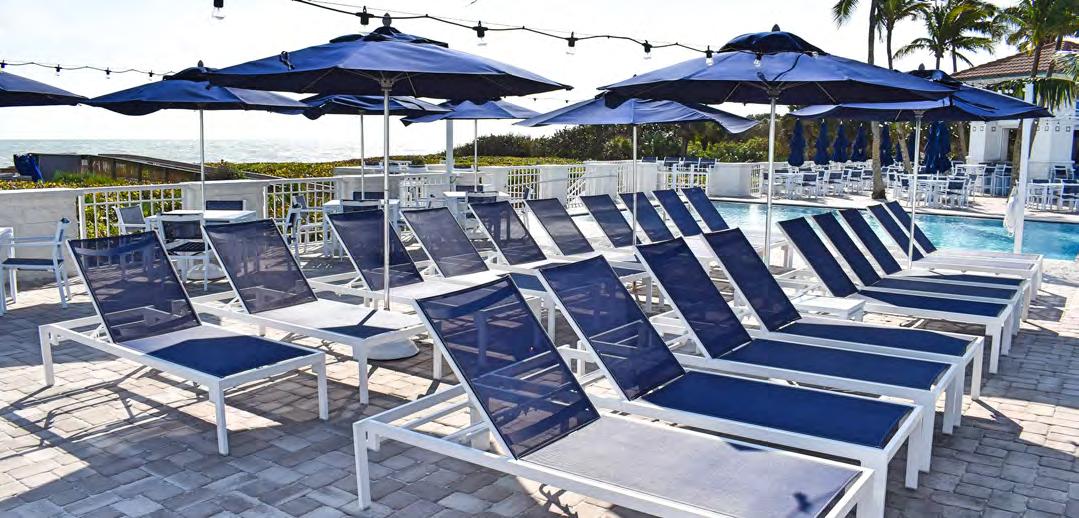

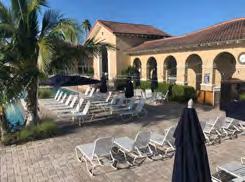


LARRY HIRSH
Larry Hirsh, CRE, MAI, SGA, FRICS is the president of Golf Property Analysts (www.golfprop.com), a leading golf and club property consulting, appraisal and brokerage firm based in Philadelphia. He blogs on variety of club and appraisal issues at http://blog.golfprop.com
During the past two years, golf has enjoyed a surprising and welcome surge in popularity.
Rounds were up in 2020 and 2021. Private clubs reported surging membership, and it is widely believed that more than half the nation’s private clubs have waiting lists for membership.
Is that all about to change?
Recently, driving to the office I heard on the news that the Federal Reserve will be raising rates by as much as 3/4 percent, the largest increase in more than 30 years. We all know about the current inflationary environment and rising gas and food prices. Is the traditionally affluent golfer population immune to this? While we recently explored golf’s sustainability relative to water, how much do we know about the economic sustainability of golf’s growth over the past two years?
It wasn’t so long ago that clubs were begging for members, golf courses were closing at alarming rates and golf retailers were closing their stores. It’s been said that COVID-19 did for golf what Tiger Woods couldn’t do. The National Golf Foundation recently reported a ”slower start to the season,” which was blamed, at least partly, on weather conditions. With the May-August months typically responsible for approximately 45 percent of annual golf rounds, it won’t be long before we begin to see a picture of how sustainable the COVID-19 surge is.
Existing economic conditions are somewhat unique. Low unemployment, high corporate profits, increasing interest rates and high inflation send mixed signals. The stock market (Dow Jones Industrial Average) is roughly threetenths of one percent (.3 percent) higher than on Jan. 1, 2021 and 38 percent higher than its COVID-19 low point on March 20, 2020.
Of course, who gets credit or blame for these and other economic indicators is likely to depend on one’s political allegiances, but the fact is that COVID-19 has been an unprecedented shock to the economy and corrections and measures to stabilize were/are inevitable. So, where does this leave the golf industry?
Golf’s fundamentals are unchanged. It is an activity that can be pursued until late in life with both friends and family. It’s outdoors and a vehicle for socialization. While perceived by some as expensive, it’s cheaper (in some segments) than many other leisure activities, but it is a very
In today’s politically charged environment, economists often take a politicized position and we’re all left to sort it all out on our own. That said, our society in general and the game and industry of golf, in particular, have survived lots of “ups and downs.” Golf will survive any potential decline as well. The key is to anticipate and avoid or minimize that decline by broadening golf’s appeal.
One might think that all this spells doom and gloom for the golf industry. However, despite the persistent inflation, there are mitigating factors that could be to golf’s advantage.
As expected, though many workers are headed back to the office, many are also embracing and pursuing working remotely or at the very least visiting the office less frequently. Eliminating the commute leaves more time for golf, or at least to visit the practice range. Combined with historically low unemployment, though impacted by the higher prices from inflation, consumers are still more likely to participate in recreational activities like golf, even if less frequently, than if they were unemployed or their business required more hours.
inefficient use of land assets, allowing a limited number of participants at any time on a large piece of ground.
How sustainable is the surge? Most observers have opined that some of the growth will endure. Nobody knows how much. To sustain growth, in my humble opinion, the golf culture needs to progress, not only by embracing but also by actively capturing a broader cross-section of the population.
Diversity, equity and inclusion has become a popular buzzword in many industries, including golf, but it needs to be successful. I discuss some of the (self-imposed) obstacles to the growth of the game in the article “Is Golf’s Culture the Game’s Worst Enemy?”, which I wrote in 2017, as well as in more detail in my book, “The Culture of Golf – Isn’t It Just a Game?”
No doubt, negative economic pressures will impact golf. Rising interest rates could reduce the number of potential buyers from the market, restrict clubs from making enhancements and improvements to facilities, and if there are more “second thoughts” about establishing or continuing membership, the entrance fees, dues or other costs of membership could decline to make it more attractive in a more competitive (both with other clubs and other activities) environment. Daily-fee and destination golf would also be impacted should there be an economic slowdown. It stands to reason that if you’ve read this far, you’re wondering what I think will happen. While I can’t confidently predict our economic future, I’ll offer some comments:
• I think golf can sustain at least some of its gains, especially if it broadens its appeal and reach more assertively than just talk.
• History tells us that golf property (clubs/courses) will not fluctuate that much in value based on capitalization rates and revenue multipliers.
• I strongly believe that buyers will continue to seek acquisitions of golf properties.
• There is likely to be a higher percentage of golf properties (especially lower revenue) sold with some type of seller financing, depending on the lending environment.
• If the economy is perceived to be declining, club membership will be impacted. Any number of elements could fluctuate. Membership and rounds at daily-fee courses could decline. Entrance fees could be impacted. “Deals” on dues and green fees might be offered. If government measures are perceived as successful, each of these factors could increase.
Nobody saw the golf surge of 2020 and 2021 coming; in fact, many expected COVID-19 to hurt golf. Now that we are perceived as recovering from COVID-19, even though it’s still there and we have to be vigilant, I think golf can capitalize on the surge by broadening the base and sustaining an environment of growth.
Unfortunately, in today’s politically charged environment, economists often take a politicized position and we’re all left to sort it all out on our own. That said, our society in general and the game and industry of golf, in particular, have survived lots of “ups and downs.” Golf will survive any potential decline as well. The key is to anticipate and avoid or minimize that decline by broadening golf’s appeal. BR

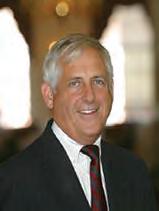
TED ROBINSON
Ted Robinson is a partner with Private Club Associates and can be reached at (478) 741-7996 or via email: tcr@privateclubassociates.com
“There are no secrets to success. It is the result of preparation, hard work, and learning from failure.” – Colin Powell
“We must never be too busy to take time to sharpen the saw.” – Steven R. Covey
Now is a good time to pay attention to Lee Child’s character Jack Reacher, whose motto is: “Hope for the best, plan for the worst.”
Many clubs are enjoying the benefits of the “COVID Effect” – full membership rolls, waiting lists, increased rounds and the resultant increased revenue streams. However, many of us remember the not so long ago dark days of the Great Recession of 2008 when members were running for the doors, walking away from $100,000 initiation fees and exponentially increasing initiation deposit refund waiting lists. Clubs’ cash flow and balance sheets were devastated.
Now there are again economic clouds on the horizon: high inflation, rising unemployment, rising interest rates, volatility in the stock markets, and supply chain issues – any or all of which could impact club membership levels in a negative way. Clubs that charged head on into the 2008 recession making difficult but effective decisions not only survived but thrived in the following years. How did your club react and respond to the negative membership environment then? What would your club do now?
The final habit of Steven R. Covey’s “The 7 Habits of Highly Effective People” is sharpen the saw. Sharpening your saw is a good way to plan for the worst. Use the standard 4 Ps of marketing as an outline.
Start with place. Any successful club needs to understand “who it is” and “who its customers are,” best articulated with a relevant brand positioning statement. Does the club understand who it is? Has it changed over the last 10–12 years? Has the brand changed? Are your members older, younger, more kids, fewer families? Have you correctly defined your competitive set? Has that set changed due to the COVID Effect? Do you have any new competitors, fewer competitors? Are any new clubs contemplated? Have any closed?
The next P is price. Is your competitive market study current? How do other clubs’ “dues and fees” schedules compare to yours? How are they funding capital needs (repair and replacement and new or improved facilities, amenities,
services and programs)? Does your initiation fee depict the value of your club as perceived by your members and the local club market?
The third P is product. Look at every component of the product your members see when they think of your club, including the club culture that comes from your facilities, service, products and programming. Does your club survey its members, at least annually, to measure the level of member satisfaction? What was that level 10 years ago and how does it compare to today? How has your product changed over the same period? Clubs that improved their product while coming out of the doldrums performed substantially better than those that just maintained.
Next is promotion – where the membership market lives. What happened to your membership level in 2008–2010? What is your plan for the worst if we face the same dynamics in the next few years? If your membership drops below the cap and the waiting list dries up, where will you find your prospective members? Begin within the cultural confines of your club by analyzing your sources of new members, including member referrals, unsolicited membership inquiries or, in some cases, outside solicitation. A related step could be looking carefully at the membership committee. Does the committee have a current and relevant job description? Does the committee have energy and enthusiasm? Are committee members’ terms realistic? (One year? Two? Three?) Are your collaterals effective? Have you updated them to correspond to a changing brand?
Create a checklist of your tools. Is your customer relationship management (CRM) software current? Are you using it effectively? Contemplate how your personal saw could be sharpened. Are you reading a sales-related book? When did you last attend a sales seminar or a club membership marketing conference? Do you read BoardRoom regularly? Decide what you can do to enhance your personal membership marketing prowess.
The time to “plan for the worst” is when all is going well. BR
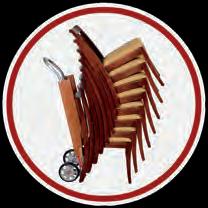





TONI SHIBAYAMA
Toni Shibayama is a broker/risk consultant for S&K Insurance in Southern California. She has more than 15 years of experience in risk management, job safety, workers’ compensation, wellness and HR consulting. Toni is also the author of “The Private Club General Manager’s Big Game Playbook.” She can be reached at toni@sk-insurance.com and by phone at (213) 627-5204.
Imagine you’re a club general manager and it’s Friday evening and you are sitting down to a relaxing dinner after a long week.
You get a call from your HR department, and the conversation starts like this: “Our members are calling and they are telling me their personal information has been hacked. I called the bank and they said a cyber thief got into our members’ bank accounts that we use to debit for membership fees. Are we covered?”
It’s an excellent question and one for which you better have an answer. When the subject of cybersecurity comes up, we often think about credit card fraud. But it’s more than that, and the financial impact goes much further. No industry is safe.
Recently, 4,000 members of Wentworth, one of England’s most exclusive golf clubs, were warned that their personal details may have fallen into the hands of hackers following a ransomware attack. However, according to The Telegraph, the first club members knew of the problem was when an unauthorized message appeared on the “Wentworth at Home” internet page claiming that “your personal files are encrypted!” and demanded a bitcoin cryptocurrency payment for a decryption key. Wentworth is not an isolated incident. This year, the email account of Clubster founder William King was hacked, resulting in members of 10 US clubs, including Anderson Country Club, receiving messages replete with racial slurs and expletives.
The National Club Association recently surveyed its members and found that 41 percent had conducted a cybersecurity vulnerability assessment within the past year. The survey also reported that 63 percent of respondents recognized their vulnerability to a security breach, and 49 percent said they trained staff on cybersecurity. Folks, ignoring the problem won’t make it go away.
Cybercriminals are sophisticated and well equipped to go after the goldmine of information collected by businesses, nonprofits, and government entities. One of the largest data breaches in history hit Target stores during the three weeks between Black Friday and Dec. 15 in 2013 and affected as many as 40 million people who used their credit cards.
An investigation by the Secret Service revealed that 1,797 stores around the country were involved. Target was not alone. Major data breaches included Neiman Marcus, White Lodging, Sally Beauty, Michaels, Affinity Gaming, City of New York, PF Chang’s, Albertsons & SuperValu, Community Health Systems, UPS, Dairy Queen, Goodwill, Home Depot, Jimmy John’s, JP Morgan Chase, Sourcebooks, Kmart, Staples, Bebe, and Sony.
From these breaches, hackers leaked five unreleased movies and 47,000 Social Security numbers, some with other personal information, like full names, dates of birth and home address, increasing the chance of identity fraud.
According to a report by the Cybersecurity Unit of the U.S. Department of Justice, any internet-connected organization can fall prey to a disruptive network intrusion or costly cyberattack. A quick, effective response to cyber incidents can prove critical to minimizing the resulting harm and
expediting recovery. The best time to plan such a response is before an incident occurs by preparing a plan for before, during and after a cyber incident.
But it’s important to be aware that not every data breach is initiated by some criminal type skulking about in a dark basement sitting in front of three large computer screens. Sometimes the attack comes close to home.
Last year, a controller of a large club sent a message to members about a large construction project and asked them to wire money to help pay for the project. Unfortunately, the account given by the controller was able to divert a portion of the monies into his personal account. This went on for many months before he was caught.
So what is the game plan when it comes to preventing cyber theft? First, identify your mission-critical data and adopt risk management practices found in the National Institute of Standards and Technology Cybersecurity Framework. Then, be prepared for an incident to assess its scope and nature, whether it is a malicious act or a technical glitch. After recovering from a cyber attack continue to monitor for any anomalous activity to make sure you have regained control of your network. Conduct a post-incident review to identify deficiencies in the planning and execution of your response plan.
But most importantly, make sure you have cyber and privacy policies that cover your club’s liability for a data breach in which your members’ and employees’ personal information, such as Social Security or credit card numbers, is exposed or stolen by a hacker or other criminal who has gained access to the firm’s electronic network.
The policies should cover a variety of expenses associated with data breaches, including notification costs, credit monitoring, costs to defend claims by state regulators, fines and penalties, and loss resulting from identity theft. Also, the policies should cover liability arising from website content, as well as property exposures from (a) business interruption, (b) data loss/destruction, (c) computer fraud, (d) funds transfer loss, and (e) cyber extortion.
As our industry continues to rapidly evolve and clubs struggle to find and keep talent, your culture must support and advance the club’s goals and strategies with an intense focus on employee engagement and retention.
consultingRCS.com | 623.322.0773 info@consultingRCS.com

We use state-of-the-art technology with proven evaluation and training principles to deliver the culture and member experience you want. Contact us today to reset, refresh and restart your club’s culture.
Is it time for a RESET?
❏ Is turnover high?
❏ Has organizational chart changed?
❏ Has business model changed?
❏ Is decision making inefficient?
❏ Are employees engaged?
❏ Are there dated processes?

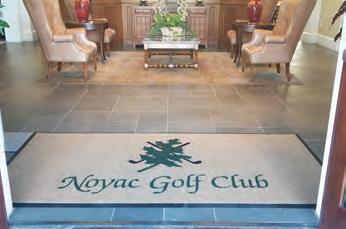





ROBERT
A. SERECI
Robert A. Sereci, CCM is the general manager of Medinah Country Club. He can be reached via email: rsereci@medinahcc.org
I recently read several articles on club governance outlining best practices for ideal board and committee size, roles, responsibilities, and much more.
I also read surveys illustrating that many clubs don’t have a strategic plan, capital reserve study, board policy manual, or documented committee or board goals and objectives.
For many years, advisors have been educating club professionals and boards; however, if education alone was the solution, there should be a measurable improvement, and this doesn’t seem to be the case. Why don’t club managers have these critical tools? I believe club professionals know what they should do; however, they don’t know how to do it.
Simply stated, it’s not a knowing problem – it’s a doing problem. Perhaps they are uncertain about how to present the concept to their boards or club presidents effectively. So, rather than spending excessive time educating club professionals, we might consider educating them on the tactics and strategies to get it done.
This knowing versus doing dilemma is nothing new. Kids know what they must do to get better grades. Folks who want to lose weight know what they must do, as do smokers who want to quit, sedentary people who want to exercise, or spenders who want to save money.
Unfortunately, information or data does not always motivate people, including club boards and presidents, to accomplish their goals. Telling someone what they should do is not enough. They may know how important it is to accomplish certain things, but human behavior often deviates.
Club managers have faced this challenge for as long as I can remember. Not surprisingly, almost every club manager relies on the standard approach to drive change: tell board members what to do, or in many cases – what not to do. So, club managers often issue messaging like:
• “We need a strategic plan.”
• “We need fewer committees.”
• “The board needs to stop micromanaging me.”
Is it any wonder why this approach is not working? You may already know that directives aren’t particularly effective in driving sustained human behavior change. We all like to feel as if we are in control of our choices. However, when others try to influence our decisions, we don’t just go along. We push back against the persuasive attempt.
We avoid the suggestion because we don’t want to feel that someone else is controlling our behavior. We raise our defenses to prevent or ignore the message or, sometimes, to justify our bad behavior. Members and boards are no different. “Sure, it would be nice to have a strategic plan or fewer committees but look at how successful we are! Why change what is already working? We have a waiting list, for crying out loud.”
So how do we get club boards to start doing?
Again, the main issue has to do with control. No one likes being told what to do. People resist orders because they feel they are giving up control, even if what is suggested is better for them and everyone around them. As
attorneys say – people want agency. However, if a change is desired, club managers can begin by taking the following action:
1. Take a deep breath. You’ll want to hit the ground running, as your excitement for change will drive you to get as much done as quickly as possible; however, slow change represents permanent change. Making slow changes allows you to prioritize your plans and gives you time to identify the most critical issues to introduce first. You have years to accomplish what you want; however, it won’t take long to become demoralized if you initiate too many changes too quickly. Start by assessing your political climate and capital honestly. Creating governance changes without the trust of your club president or board is a non-starter. If you have none, establish trust by developing relationships and bank some easy operational wins first. However, if you believe you have the political capital to embark on this journey, create a list of what you want to accomplish and prioritize based on how much energy and disruption the changes will cause you, your team, your board, and your membership. A word of caution: any governance change will require more effort and take longer than you expect. There are very few “no-brainers” in club governance. As a courtesy, ensure that your current president is informed, comfortable, and agrees with your approach.
2. Start with the less controversial. Unless you have a well-oiled governance model, suggesting to your board that you reduce your board size from 13 to nine or suggesting that you revamp your nominating process is unwise. Upon arriving at a new club, introduce less controversial suggestions, like using formal board motions and consent agendas. I like to introduce the idea of creating a responsibility matrix to ensure that we identify everyone’s roles. Notice I suggest starting with simple documentation of what is and not what should be or what you desire – changes come later. I recommend starting with conducting new board member and new president orientations. Again, I recommend you do not document what you hope to change or believe should change. I encourage
you to document what is happening now and make minor adjustments over time to reflect how things should be. At first, the changes will be subtle; over time, changes will be significant as you build more political capital and earn everyone’s trust. To provide some perspective, at Medinah, we are just now embarking on some governance issues as I enter my eighth year. Yes, it can take eight years for everyone to feel comfortable tackling certain governance matters. Remember, it’s not only you who must have adequate political capital but also your club president and board. Governance is a team sport.
3. Respect their freedom. To respect your board members’ sense of autonomy while addressing issues, you might point out any disconnect between their intent and actions or what they do in their business versus what you do at the club. For example, for a board that resists developing a strategic plan, you might ask what they suggest in a scenario where committees or former boards pick projects at random and assess members multiple times. Or in a scenario where former boards failed to modify bylaws responsible for the challenges you are facing today. The answer can set up an internal examination of current behavior. People strive for internal consistency. They want their attitudes and actions to align. Highlighting misalignment encourages them to resolve the disconnect. Rather than trying to persuade board members, getting them to convince themselves is often more effective. One way to allow for agency is to ask questions rather than make statements. As mentioned previously, typical club messaging tries to be direct but being forceful can make others feel threatened. Rephrase the content as a question: “Do you think personal agendas reflect well on you as club president and leader?” If the answer is no, they’re now in a pivotal spot. By encouraging them to articulate their opinion, they’ve had to put a stake in the ground — to admit that those things aren’t good for them. And once they have done that, it becomes harder to keep justifying the bad policies or behaviors.
4. Ask for less. Boards are notorious for ignoring issues and doing nothing until you know what hits the fan and then they go full tilt overnight. This strategy doesn’t work in our daily lives, and it doesn’t work in clubs. Instead of asking for 100 percent compliance on many issues, pick and choose what you want your board to do. Stated differently, pick and choose your battles to make change more palatable. For example, telling a person who has never exercised to exercise five days a week for two hours a day is a big ask and likely unworkable. However, asking the same person to take a 30-minute walk twice a week is more likely to occur since the ask is smaller. So, if your club has a history of micromanage-
ment, lacks a strategic plan or a board policy manual, or lacks processes, a best practice is to dial down the initial request. Ask for less initially and ask for more later. Take a big ask and break it into smaller, more manageable chunks.
5. Put it in writing. No matter how skilled you are as an orator, nothing is as effective in creating sustainable and permanent change as putting your request in writing. As we have established, many boards resist change, and most of the time, the default answer is no – especially if your request is multifaceted, complex, and involves others. Writing down your plan accomplishes several objectives. First, by writing down what you want your board to do, you are documenting your talking points and ensuring what you are requesting is feasible as you have described it. Even if your board rejects your idea the first time, they can reread your document and may eventually come around to your side. Second, you can provide history and context, so the board can better understand the issues both now and in the past. Third, your written document will touch more people than if you rely on a verbal explanation of your plan and position. Finally, your document will be used perpetually to educate future board members.
6. Don’t push them hard. You just got back from the CMAA conference, where you heard multiple speakers talk about how you should do things and what you should have in place, so you feel inspired and motivated to finally put your foot down with your board and demand that change takes place. You want to share all the charts and graphs and remind them how the “great clubs” do it right. Unfortunately, that is not an effective strategy. We assume that they’ll come around if we remind members again or give them more facts, figures, or reasons. But as we learned from our recent backlash against the pandemic restrictions, this doesn’t always work over the long term, especially when your demands have no fixed end date. So, temper your enthusiasm and your emotions. Don’t push them hard. As Gregg Patterson, founder and president of Tribal Magic, says, give them “the nudge” instead.
I honestly believe club managers are mostly unhappy because of the tension between what we want to do and what we are allowed to do and the tension between how we want to act and how we are told to behave. Finding a club culture that fits who we are is essential. If we instead understand the key barriers preventing change and employ tactics designed to overcome them, we can change almost anything. Remember, slow change makes for permanent and purposeful change. BR
Breaches are now a part of life, and yet when they happen, too often companies pull out an outdated incident-response plan that hasn’t been looked at in two years, or worse yet it isn’t on the shelf when you reach for it. Meet with your in-
surance broker and legal team to discuss possible scenarios, whether it be employee dishonesty or cyber-attacks. Cyber theft is on the rise, and the best thing you can do is make sure your club is ready when, and if, it hits. BR

GORDON WELCH
Gordon Welch is the president of the Association of Private Club Directors (APCD), the only association representing the club’s board. He can be reached at gordon@apcd.com or by calling (949) 376-8889.
Recently, I asked: “Does tradition keep us from evolving?” The need for monthly board meetings at a country club was one of the points discussed.
In my opinion, monthly board meetings at a country club aren’t a necessity for the governance or operation of the club as much as a desire for communication. As I stated, multimillion-dollar corporations do not have monthly board meetings, so why do clubs of, let’s say, $10 million or more continue to have monthly rather than quarterly board meetings? I posed the question on my social media platform, and with over 10,000 followers, I felt I’d receive a definitive answer. The question? “Should clubs over $10 million/yr. have monthly or quarterly board meetings?” It is not a scientific poll, but it was interesting. More GM/COOs than board members follow me, so I thought the results might skew toward the quarterly answer.
The results were 51 percent in favor of monthly board meetings and 49 percent for quarterly. This outcome leads me to more questions. Does the size of the club or the gross dollar volume matter? Who requires monthly board meetings? Is
it the board, the GM/COO or the staff? Is it a matter of inquisitive board members’ lack of communication that’s an issue?
I believe many well-run and well-governed clubs could experience quarterly board meetings. It depends on the makeup of the board and the issue of income versus expenses. If management and the executive committee keep the board abreast of agenda items or issues that require board input, quarterly meetings should be a viable option for many clubs. However, if you have a board that doesn’t understand its role or the board has a pet project, you’re going to have monthly board meetings.
Every club is different, every board is different, and every GM/COO is different. I explain to boards that one of the difficulties for a GM/COO has been the clubs’ personalities. If you look at your paid leadership as a professional coach, let’s say, a basketball coach, there are many similarities. Coaches have teams with great talent and possibility, but the players have egos and personalities that must be managed differently.

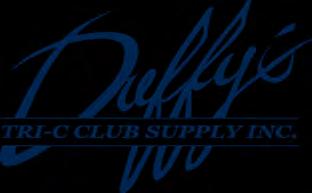



Great for your card room, 10th hole, events and catering, Sunday brunches, kids desserts...the possibilities are endless! We provide the machine and the mix—everything—with no upfront CapEx! Over 100 flavors, Sunkist and Dole whip products, and vegan selections!
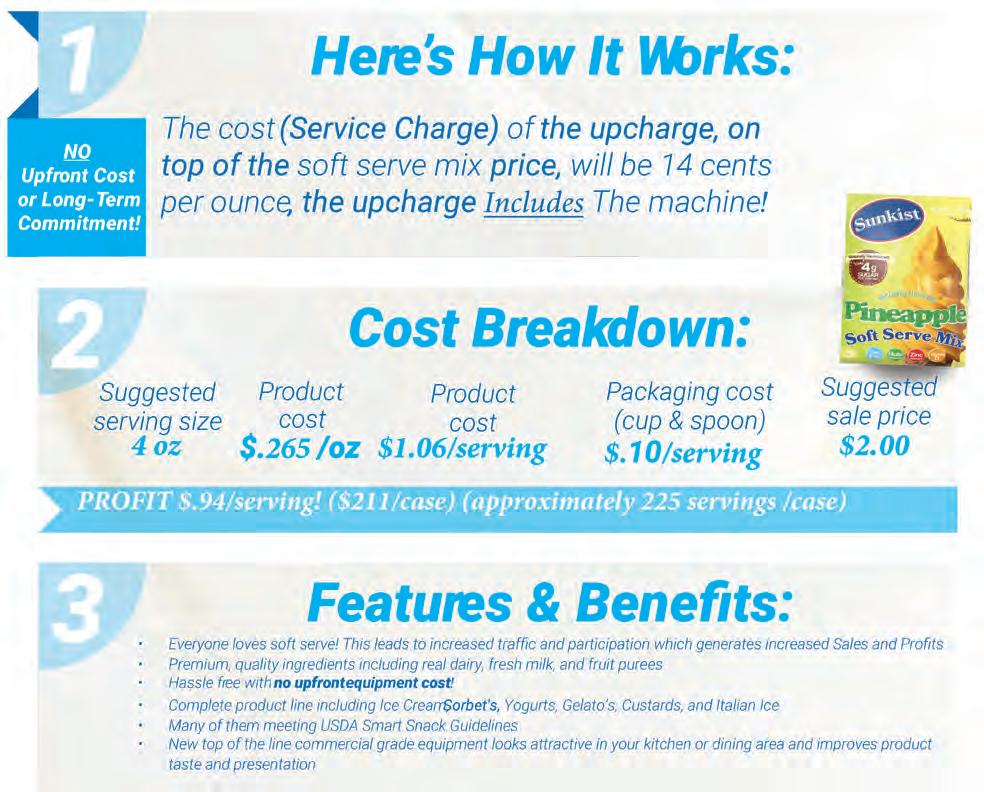

A revenue generating memorable night of interactive comedy is a phone call or email away!
Howie and his Colleagues in Comedy have literally hundreds of years of experience between them. Having grown up in the schoolyard in Bayside, Queens and having played the role of “The Detective” in thousands of Murder Mystery shows, Howie’s forte is engaging the audience and working the crowd in a very entertaining, interactive manner. He welcomes info about some of the big personalities and characters at the club...thus enabling him to work them into whatever show he brings you.
Along with his confidence in audience interactive entertainment, Howie prides himself on knowing true comedic talent. The comedians he brings to perform at any show are all consummate professionals who have headlined at major Comedy Clubs across the country, along with having an assortment of TV credits. They are the real deal.
Regarding the kind of material he and his friends will deliver, generally it is PG-13, but can be appropriate for
Church on Sunday morning if that’s what the client needs. The client always sets the parameters for the material he and his colleagues dispense to their audience.
He also is still playing the role of The Detective in Murder Mystery shows and can provide you a really fun evening with a script tailor-made for your club and its history and/or location.
If you’d like a special comedy show geared to your women members, he can provide you with a “Ladies Night Out” show.
“Laughter is the best medicine” is not just a famous quote. It is fully supported by science. All kinds of good things happen to your body and mind when you laugh.
So, hire Howie Walfish & Friends to provide a memorable event filled with fun and laughter at your club. Your members will thank you for it! BR

KE Camps will operate a children’s summer day camp at your club, an exceptional service for your membership and their guests.
Encourage families to spend time at your club by offering a quality program for their kids!
Summer camp is where friendships are made and skills develop. Campers are active through themed activities, community service, STEM challenges, arts and crafts, fun with foods, fitness, golf, tennis and swimming.
Your club is where your membership feels at home - the comfortable surroundings, beautiful setting, and safe environment provide an instant feeling of ease. The combination of impeccable golf, tennis and pool facilities, along with topnotch food service, and upscale amenities provide an enticing environment.
KE Camps is where camp and your club come together to create a special and unique experience for your families. Blending a traditionally-inspired summer camp experience with the welcoming atmosphere of your club is what we do. BR
“Everything sounded too good to be true. After talking with several other GM’s I decided to give it a shot, and it’s been great since day one. Couldn’t ask for more.”
– Lakewood Country Club
“It has been a pleasure to work with KE Camps. We have been able to extend our offerings to our members and KE Camps made that very easy!”
– Blue Hill Country Club
“It’s a tremendous relief to have such a professional (and fun!) program for our junior members without having to hire, train, oversee, troubleshoot, manage, etc. during our busiest months of the year.”
– Fort Collins Country Club
“This was our first year using KE Camps and it was an incredible experience. KE Camp staff were on top of everything from day one.”
– Forest Lake Club

Offer the best amenity for your membership, and let KE Camps do the work!
Our all-around camp program operates alongside your junior programs, not in competition with them.

"We have been collaborating with KE Camps for quite some time and it is a really fabulous relationship. The blending of the program with the rest of the club is smooth and flawless. Any other alternative to this concept would be less desirable."
- Club Partner
“We’re always looking for new and forward-thinking amenities and this idea came from our memberships,” explained Alan Raulerson, GM /COO of Wilderness Country Club in Naples, FL.
And that means Wilderness members now have an electric vehicle charging station in the club’s main parking lot near the tennis courts. It’ll be available to members and their guests.
Members can book a charging reservation through an app and plug their vehicle in to charge while they play golf, dine or use some of the club’s other facilities.
“Being a small community, we’re always looking for suggestions to improve our members’ experience and lifestyle


and we can react to good ideas quickly without a lot of red tape,” Raulerson added.
“Starting with last season, I have seen an increase in the use of the charging station. There are probably eight or nine electric vehicles on campus, including our newest employee, and I see this growing through the coming season as more people keep telling me their next car will be electric. If we didn’t have a charg-ing station, members wouldn’t be as willing to purchase an electric vehicle since you would have to go off campus to charge it.” BR


HEATHER ARIAS DE CORDOBA
Heather Arias de Cordoba is the Innovative Ideas editor, associate editor and creative director for BoardRoom magazine. She is an award-winning and highly versatile marketing leader, writer and designer with a 25-year career in the private club industry.
To submit an idea or story for this section, please email heather@studiodelmar.net
Usually, a fire at a country club means disaster but a recent fire at the Wilderness Country Club’s clubhouse certainly served a different purpose.
“We are thankful to Wilderness Country Club for generously donating their former clubhouse for our training exercises,” said Rusty Godette, captain, training and special operations for the Greater Naples Fire Rescue District.
Local firefighters and other first responders took advantage of a unique opportunity to train on the current clubhouse at Naples, FL Wilderness Country Club, as they used the 48-year-old building for search-and-rescue training exercises over a couple of weeks before the structure was demolished. Partnerships, like the one with Wilderness Country Club, are important in that they offer hands-on training for firefighters that would otherwise be difficult to come by. The multi-agency training also helps the fire department in achieving necessary certifications. One unique aspect of the Wilderness clubhouse for the training exercise focused on the fact the building included a basement, a rarity among Southwest Florida buildings.
Wilderness Country Club plans to begin construction of a completely new clubhouse later this year. Designed by McWard Architects Inc. of Naples, the new two-story, 26,000-squarefoot building will replace the old clubhouse, which originally opened shortly after Wilderness was founded in 1974.
The new clubhouse will showcase an old Florida architectural style with panoramic views of the club’s championship golf course. The building will provide an expanded outdoor dining experience, a larger bar area and a new pro shop. There also will be a private Wilderness Room dedicated for small group gatherings like card playing, family parties, wine tastings and other club member events.
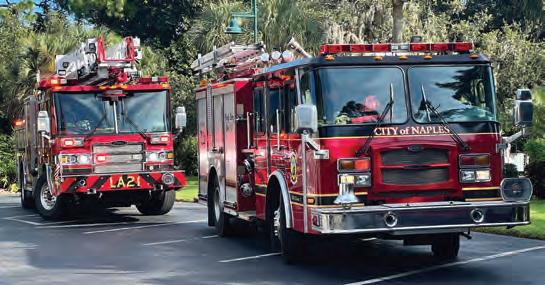


“We are in the site development process and anticipate starting groundwork and vertical construction this fall. The new clubhouse will be open to our members by the end of 2023,” said Alan Raulerson, Wilderness’ general manager/ chief operating officer. “This keeps us on pace to celebrate the club’s milestone 50th anniversary in 2024.”
Located on 200 forested acres, Wilderness Country Club is an established community featuring an 18-hole, Arthur Hills golf course and a full practice area where golfers of all skill levels can work on their game at the driving range, short-game area, and putting green. Each club member has the option to walk the course any time of day or take their own private golf cart, and there are never any trail fees.
Wilderness Country Club, an Audubon Cooperative Sanctuary for over 20 years. This makes it the ideal place to photograph more than 80 species of birds, including bald eagles, ospreys, white ibis, anhingas, great blue herons, red shouldered hawks, barred owls and swallow tail kites. The lush surroundings provide an ideal location for the Conservancy of Southwest Florida to use as a safe place to return rehabilitated animals, such as turtles, hawks and owls, to their native environment. BR


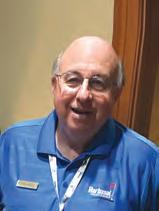
Bruce Barilla provides onsite locker room evaluations, staff training, and layout design. He is the locker room manager for the Barbasol Championship. www.lrcgolf.com
I recently communicated with two private country club general managers, and both said the men’s locker room does not get much use. I will suggest reasons for the lack of locker room use and solutions.
Is there an attendant on duty offering shoeshine service? Could the main reason for the lack of locker room use be that there is no staff on duty offering each member and guest daily shoeshine service while keeping the locker room clean, neat and well stocked throughout the day?
One hundred golfers means an opportunity and responsibility to do 100 pairs of street and golf shoes that day. Having only one attendant working a 40-hour week limits services provided to only eight hours a day and none on his two days off.
and polish any shoes left in a designated area. It could mean extra income for them if tipping is allowed or a set fee exists.
Showers can actually attract users, but there needs to be excellent water volume and pressure. As a result, full thick wide spray showerheads with no hollow spots become something to look forward to. A massage room and barber shop, with set hours of operation, are also a draw. Private water closets add a modern touch. Cloth hand towels make paying a locker fee more worthwhile. Having an ice water station can also bring people inside the locker room. So can offering food and drink service in a sitting area with large flat screens.
Metal lockers instead of wood are not a factor, providing they are in decent condition. In fact, most have more storage
Are you hesitant about hiring full-time staff?
Consider providing shoeshine service with an attendant on duty a few times a week. Perhaps on busy days? A part-timer is better than no service at all.
Also, the shoeshine room needs to be inside the locker room with a greeting counter near the entrance. The attendant must be visible rather than hidden in a room off a hallway. When I worked at Butler National Golf Club and The Greenbrier, we staffed the locker room from before the first golfers arrived to after the last golfers were off the course and serviced.
Location of the locker room, condition, offerings and solutions: Second-story locker rooms are not standard but still function the same. Not every clubhouse design features the parking lot next to the locker room entrance. Not every locker room leads directly to the first and 10th tee or flows into the pro shop. Some clubs have two-story locker rooms. These are not excuses for lack of use.
If not staffed, the men’s and women’s locker rooms need to be clean, orderly and fully stocked with a complete line of quality sink, shower and grooming station amenities. There needs to be a housekeeper who checks the locker rooms numerous times throughout the day so that when a member or guest enters, they can sense everything is how it should be and ready for them. Although a housekeeper is not the same as an attendant on duty, the housekeeping staff could clean
space. They can also be painted. New carpet and/or vinyl flooring, better (not necessarily brighter) lighting, and a new interior color all add to the attractiveness.
Are you hesitant about hiring full-time staff? Consider providing shoeshine service with an attendant on duty a few times a week. Perhaps on busy days? A part-timer is better than no service at all. Member-guest events with two attendants will give the members a feel for service. Put any gifts for the guests inside their lockers so they will have to enter the locker room.
Borrow an idea from a club in the Cleveland area and give a comp guest greens fee with the annual locker fee. More members rented lockers, and guest play increased along with food and beverage income. The annual fee can include a “thank-you” item, such as a travel amenity kit.
Maybe the simplest solution is to survey the members by asking, “Why do you not use the locker room?” Summarize the response; if you would, please let me know the results. BR




BILL BOOTHE
Bill Boothe is president and owner of The Boothe Group, LLC, an independent consulting firm that helps clubs understand computer technology, make good decisions and receive the highest value from their technology investment. During his 30-plus years in the club industry, Bill has assisted more than 400 private clubs with the planning, evaluation, selection and implementation of computer technology in all facets of their operations. Bill can be reached at bboothe@boothegroup.com.
I had the pleasure of speaking at the HFTP annual convention in Austin, TX in mid-September.
I say “speaking” in quotes, since mostly I was listening to what the CFOs and controllers from more than 100 private clubs had to say about the practical aspects of using technology to enhance their members’ experiences. During the session, we captured their “real-life data.” We share it with you now – to provide a practical guide to the use of various member-facing technologies. To make this data easily digestible, we offer it in a summarized format – just the facts, with not much filler.
Member mobile app: The discussion around this technology covered a lot of ground, since mobile apps offer a lengthy list of features for member usage. Availability = high, meaning that almost all of the clubs attending offer a mobile app to their members. Member usage = high, meaning that a large percentage of their members actually use the mobile app. Pros = convenience (versus calling the club or using the website), 24/7 availability, lots of functions available in one place (e.g., all kinds of reservations plus billing account and member roster access). Cons = older members not comfortable with mobile technology (lots of discussion on this point with many attendees saying that age is not that much of a factor), lack of promotion by the club to encourage member use.
Bottom line: If your club does not offer a member mobile app, you’re missing the boat.
Online a la carte dining reservations: Availability = high. Member usage = medium, meaning that some but not all members use this feature. Pros = member convenience (24/7 access), a big reduction in calls to club staff, the ability for members to see who else is coming to dinner and when (if that feature is activated). Cons = managing reservations rules (members making duplicate reservations or gaming the system – imagine that!), impersonal member interaction (the point was made that using this technology doesn’t prohibit members from calling).
Bottom line: A useful tool but not something all members will be comfortable using.
Online club events reservations: Availability = high. Member usage = high. Pros/cons = essentially the same as with dining reservations.
Bottom line: A popular feature used by most clubs to provide member convenience and reduce staff hours taking phone calls from members.
Online golf tee time reservations: Availability = high. Member usage = high/medium. Pros = expedites staging of carts, simplifies billing of fees, gives members the ability to see who else is playing and when (if that feature is activated). Cons = impersonal member interaction (the point was made that using this technology doesn’t prohibit members from calling).
Bottom line: A popular feature used by many clubs to provide member convenience and streamline operations.
Online court reservations: Availability = high. Member usage = medium. Pros = 24/7 convenience. Cons = not conducive for last-minute adjustments due to weather issues or walk-ups.
Bottom line: A big help for larger courts venues, not a big deal for smaller ones.
Online kids camps reservations: Availability = medium/ low. Member usage = low. Pros = 24/7 availability. Cons = complex procedures involving liability waivers, age/gender categories, health information, etc.
Bottom line: Minimal usage due to complexity of handling many exceptions online rather than in person.
Online F&B ordering: Availability = medium/low. Member usage = medium/low. Pros = especially helpful for golfers ordering from the halfway house as they approach the turn, and for meal pickup. Cons = handling extreme menu modifications and special instructions, lack of integration with POS for third-party solutions.
Bottom line: Popularity zoomed during peak COVID period, but has tailed off recently. But still a nice feature to offer for the members who use it.
Member communications through texting (versus email): Availability = medium. Member usage = high for the clubs offering texting. Pros = much higher open rates with texting than email, great for last-minute or emergency notifications. Cons = new concept to the club industry so can be difficult to determine which provider is best for your club, gaining member permission to text them.
Bottom line: A good feature to offer that members will use and appreciate.
Beacons: Availability = very low. Member usage = very low. Pros = especially helpful at the bag drop to help with cart staging. Cons = “creepy factor” that many members are not comfortable with.
Bottom line: Not making much of an impact with clubs.
Access control (using mobile phone with QR code or barcode): Availability = very low. Member usage = high when available. Pros = allows members to access unstaffed areas (such as fitness centers) after hours, clubs can more easily manage without the use of cumbersome metal keys, swipe cards or key fobs, almost all members have a smart phone with them at all times. Cons = none recorded.
Bottom line: Low-cost access control alternative that can be used by virtually every member, and is easy for the club to manage.
As you can see, there are quite a few technologies that can significantly enhance the member experience at your club. Of course, this is not an exhaustive list of available technologies since we only had a 75-minute education session. However, this list covers most of the key member-facing technologies and offers the firsthand experiences of a representative sample of private clubs. We hope you find this information helpful as you evaluate the practicality and usefulness of these technologies for your members. BR

Mt. Mitchell Golf Club Burnsville, NC
tot hill Farm Golf Club Asheboro, NC
1 hr from Pinehurst & Charlotte 1st Original Mike Strantz Design
Maggie Valley Club & resort Maggie Valley, NC
Meadowlands near Greensboro, NC
• Brokerage
• Accelerated Marketing Discreet and Confidential
• Consulting Services
• Acquisition Advisors


Juicy and delicious
GREGG PATTERSON
Gregg Patterson is founder and president of Tribal Magic. He can be reached via email: GJPAir@aol.com
Novels are a treat to read and movies are a joy to watch. And the juiciest stories and the juiciest cinema often focus on weakness, temptations, human foibles and–The Seven Deadlies.
Sloth. Gluttony. Wrath. Envy. Pride. Greed. Lust. Biblical stuff. Endlessly entertaining. Fun to read, to watch, to talk about. And avoid.
Many who fell in love with clubdom did so after experiencing the sobering, humdrum, routine world of jobdom, workplaces filled with the boring, the routine and the predictable. Those “who experienced the humdrum” remember failed first-date conversations de-energized by the telling of boring stories about boring stuff that happened during a boring workday.
These frustrated workers wanted more from their jobs–more interesting, more memorable, more engaging–but knew not where or what.
Sometimes these “worker bees who wanted more” got exposed to clubs. And what they saw and heard was endlessly entertaining. They discovered that clubs delivered more than the money, more than the Mercedes, more than the wood-paneled office. They discovered that a day in clubdom delivered wild and entertaining stories that made “outsideof-work” social encounters more engaging, more successful, more fun and more memorable.
Those who love clubdom are drawn to clubdom, stay in clubdom and trumpet clubdom because they want to hear, see and chatter about entertaining stories that are the stuff of novels and movies–every day. Comedy routines. Morality tales. Tragedies. “Oh-my” situations featuring The Seven Deadlies.
These club enthusiasts tell their friends who are crunching numbers, analyzing spreadsheets and living the “ho-hum” that clubdom is a howl because they–as club employees–have a front-row seat to a daily showing of The Seven Deadlies.
Delicious!
Let’s imagine you’re writing a sitcom about clubdom with a focus on The Seven Deadlies. Entertaining. Educational. Generating guffaws. Making the madness a hoot. Let’s walk around, listen in, take notes and prepare to write.
Gluttony. We take a peek at the menu, scan the dining room and ponder what sells. There’s good stuff to be had–low cholesterol, low caloric, environmentally conscious. Proud that we’ve addressed those expanding waistlines. And then we discover that the big evils–grease, salt and sugar–are the big sellers. Guaranteed to clog the arteries, add inches to the waistline and shorten life–and bring a smile to the diners who’ve gathered.
Pride. We pass through the men’s locker room and listen. We see members beating their chests, telling their guests how tough it is to join, how much it costs, why the wine list is 40 pages long and why no members ever resign and no staff ever leave. We hear it said time and again–this is us, and us is good, the best, unique and special. World-class.
Envy. You overhear the grill room conversation. “Club XYZ has a bigger pool than we’ve got, club ABC has more sand traps than we’ve got and the High and Mighty Club costs 10 zillion dollars to join. We’re nobodies ‘cause we ain’t got nothin’ that compares with all the stuff that the others have got. Grrr!!!”
Lust. You pass through the ladies’ card room. See the blue hairs sipping bourbon on the rocks, playing bridge for big bucks, quietly reflecting on annoying grandkids and nouveau riche newbies who “don’t measure up.” Then the new waiter arrives, ready to serve. Tall, well-groomed and impeccably dressed, an intern from Hospitality U. They give him a glance–or two–as he wanders about picking up empties, offering drinks, smiling, laughing and talking to everyone. He leaves. They sigh, give each other the look and say, “If only I was 60 years younger and my blue hair was brown.”
Wrath. Friday night dinner. Busy beyond busy. Mr. Corporate Cheese has a table filled with corporate cheeses talking corporate talk. The wine steward arrives, bottle in hand from the special cellar. With a flourish, he shows the bottle to The Big Cheeses, quietly compliments the host on the selection, pulls the cork and gives it a look, a squeeze and a sniff. He smiles and pours a taster portion for The Big Cheese. The host swirls, sniffs, tastes, grimaces and pronounces–loudly–that the vino is undrinkable, an insult to The Big Cheeses at the table, insists on a free replacement, a groveling apology from the general manager and
a written “I’m so very, very sorry” note from the president of the club.
Sloth. You wander into the locker room lounge, early morning, mid-week. The youthful coupon clipper is sitting there in front of the “tube,” belching, drink in hand, three doughnuts on the table, debris all around (newspapers, wrappers, paper napkins), eyes glazed, staring at the tele, calories collecting, patting his bulging belly. Far niente. Doing nothing–endlessly and forever. Complaining about the worthless nogood-for-nothing younger generation.
Greed. Free peanuts in the bar, one of the munchies in one of the free pour munchy carafes–yum!!! From your “hidden location,” you watch Mr. Munch slither into the bar, eyes darting left and right, head on a swivel, gliding toward the munchie counter. He stops, gives the entire bar a long look to confirm that there “ain’t nobody watching,” takes a popcorn bag from beside the popper, slides over to the munchie counter, fills the bag to overflowing with a half-pound of premium Big Boy Peanuts, stuffs the bag into his jacket pocket and exits the bar, a smile on his face, glowing because he’s affirmed, once again, that greed is good when you’re Mr. Munch.
Wonderful stuff. Fun. Entertaining. A howl.
We savor and repeat the stories that are juicy and delicious because they’re both entertaining and educational. We ponder The Seven Deadlies to dramatize the values needed to preserve us from the madness.
Stories are told to titillate and teach. Each one a cautionary tale about the temptations that are simmering in each of us, ready to burst forth and burn us in hell fire. People remember the stories and absorb the message without having to memorize a list of the do’s and don’ts.
People love to hear about others who do, have done or are witness to The Seven Deadlies. They love to glimpse, condemn, comment on, gossip about, laugh at and philosophize about The
Seven Deadlies. They love to wag their fingers at The Seven Deadlies, bemoan their existence, caution others to avoid ‘em–and talk endlessly about them.
We use the stories as an ethics class, a morality tale, a roadmap for the good life. We know The Seven Deadlies are hidden away in each of us, ready to spring forth to corrupt, diminish and cut our careers short.
If managers live The Seven Deadlies, they’ll get burned bad. If, however, a club professional sees The Seven Deadlies, ponders the bad they represent and the good they suggest, insights will arrive and learning will happen. Knowing and avoiding The Seven Deadlies will help the GM live a long and happy professional life. Those who love clubdom are voyeurs of The Seven Deadlies. Juicy stories. Great conversation. Educational lessons. Endlessly entertaining. Delicious. Yum!!!
Clubdom delivers great stuff for a skit, a video, a novel or a “listen-to-thisand-learn-about-clubdom” story for new employees, staff meetings and first dates. Those who hear will remember the stories, absorb the lessons and be entertained in the process.
Club enthusiasts have observed The Seven Deadlies–lots. They’ve seen lots, laughed lots, ugh-ed lots, discussed lots and cautioned lots about the human condition, the hidden madness in each of us and the values needed to wrassle with The Seven Deadlies.
Stockpile your stories. Think like a writer, movie director or teacher. What novel would you write? What movie would you direct? What lessons in “right behavior” will you deliver?
Distance yourself from The Seven Deadlies–but gather the stories. Start telling. And enjoy the journey. BR

and attract new talent. The COVID-19 pandemic has placed a spotlight on the importance of showing employees that a position is not a job. It’s an opportunity to build a career with the ability to grow within an organization.
Technology can help improve employee and member experiences and alleviate pressure from labor gaps.
As for strained supply chains, focusing on local solutions for food, beverage and golf goods can help save on costs and create alternatives to issues affecting major distributors.
Ultimately, a golf club or a country club survives on a central value proposition: In return for often expensive dues, members enjoy attentive service, beautiful facilities and a
from Boardroom Basics and Beyond | 18
Another caution for a GM to be sensitive to is the practice of regularly going to personal strengths and experiences for answers. Rather, put effort into growing strengths and understanding to create more options from which to draw. It is not speed and volume that should be valued but the thoughtful consideration of the information we gather. If you find you are locked into overusing your strengths and taking too many shortcuts, you might want to read “Fear Your Strengths: What You Are Best at Could Be Your Biggest Problem,” by Robert E. Kaplan and Robert B. Kaiser.
Curiosity is a series of strategic questions. Of course, finding the answers will assuredly tax the minds of all involved, but
from Legislative & Regulatory | 50
feeling of exclusivity. The question is, when does it become too expensive to maintain that high level of service?
Even in the current challenging environment, there are solutions. On the labor side, there are approaches beyond higher pay and benefits to developing a committed staff. To ease snarled supply chains, local providers often can provide a more reliable source of goods.
And as capital investment continues to move forward to keep clubs attractive, interest rate caps and other derivative instruments can effectively fix annual debt service charges for more consistent cash flow from members and to the lender. Given the dedication of board members, management and club members throughout the country, the club industry appears to have a positive horizon focused on serving members and employees by driving value during these challenging times. BR
stay the course. Remember why you started down this path and adhere to foundational principles to guide and inspire.
The good thing is that sound strategy and deep thinking are not lonely work because the process naturally calls for collaboration. Working with bright minds will give you the best chance of conceiving a win-win set of strategic choices that will make all the difference for your club and the people you serve and work alongside.
In summary, the deep work of concentration is the most significant practice a leader can engage in. General managers should consider measuring the success of a career by what they have learned and successfully implemented to impact the people and the clubs they serve. BR
ness prevention in both indoor and outdoor settings. Public comments were accepted on the proposal through December 2021. The rule will likely be modeled on California’s heat illness prevention standard that applies to all outdoor worksites. The California regulation requires employers to provide outdoor workers fresh water, access to shade at 80 degrees and whenever requested by a worker, cool-down rest breaks in addition to regular breaks, and maintain a written prevention plan with training on the signs of heat illness and what to do in case of an emergency. Additionally, the rule is expected to include further recommendations from the National Institute for Occupational Safety and Health that focus on engineering controls, training, acclimation, hydration, and rest breaks. The rule could be released at any time.
In August, the Inflation Reduction Act (HR 5376), a massive, 730-page legislative bill targeting many areas of the economy, was signed into law. Of interest to the club industry is the significant increase in funding for the Internal Revenue Service. The goal of the legislation is to raise an estimated $124 billion in net revenue (over 10 years) through increased funding of operations and improving taxpayer compliance. Additionally, the goal is to improve customer service which will hopefully eliminate the backlog of returns and inquiries the IRS is experiencing. More than half of the new funding ($45.6 billion) will go directly to enforcement. Accordingly, tax paying entities, including clubs, should be gearing up and working closely with their tax advisors to prepare. BR
Club leaders have many member families, many staff, and many opportunities for personality clashes. So, consider this: It’s not just the operation or service expectations that are a challenge. It is also a challenge for hundreds of personalities within the staff and membership. Both sides of the equation can clash, member versus member, staff versus staff and member versus staff. Your GM has many issues to tend to daily. If you have a club that has trust, knowledge, and experience, you could have quarterly meetings. I would suggest you change your bylaws to have that ability. Monthly board meetings aren’t necessary for all clubs, and I would encourage you to embrace quarterly board meetings. BR from Boardroom Perspectives | 92
“All board members are convinced that their club is ‘unique.’ For some reason, there’s a perception that their private club is dealing with different issues than other private clubs. Finding information now on what to educate boards is very, very easy. There are more resources than ever before about ‘the best practices of board governance,’” explained Steve Graves, president and founder of Creative Golf Marketing.
“How to educate them tends to be the bigger issue of the two. But, again, the difficulty is the fact that many board members do not give the appropriate credit to the complexity and comprehensive nature of the private club industry. As a result, they don’t view their private club as strategically as they do their businesses.
“Private clubs, since I came into the industry over 40 years ago, have typically been a very reactive business model. As a previous BoardRoom article shared, board members typically need to feel some pain before acting. Commonly, it is a bit too late once they come to that conclusion, but to act proactively, peculiarly, is viewed as ‘desperation’ rather than ‘wisdom,’” Graves expressed.
“The problem we face in our industry is not finding material to educate boards; it’s properly and adequately preparing club professionals to lead and educate their board effectively,” injected Frank Cordeiro, COO and GM of the Colonial Country Club in Fort Worth, TX.
“Robert Sereci’s supposition is dead on – club professionals know what they should do; however, they don’t know how to do it,” Cordeiro added.
Michael McCarthy, CEO of Addison Reserve Country Club in Boca Raton, FL, “personally has never felt it to be a challenge” to find material to educate boards or find a way to educate his boards.
“I’ve committed my career to ensuring that we consistently educate our boards and believe that as general managers, CEOs and COOs, it is one of the most important aspects of our job.
“If you’re not committing time and resources to that endeavor, the board may go in a direction inconsistent with the club’s vision. When that occurs, it usually creates chaos in the organization. However, I believe there’s plenty of great material to use. Just make sure the material you decide to use is aligned with the goals and objectives of your organization,” he emphasized.
So, why does it, at times, seem to be so difficult to get boards to approve and implement decisions?
“Before the pandemic, the answer was simply…’ The money isn’t there.’ It’s as Ray Cronin (founder of Club Benchmarking) is known for saying, ‘Most private clubs are capital starved,’” said Creative Marketing’s Graves.
“Consequently, when you want or need to spend money, there’s so much pressure on the needs and wants of so many areas of a private club that analytical paralysis kicks in and no money gets spent or allocated.
“During and after the pandemic, the vast majority of clubs have a much stronger cash position, yet getting that cash flowing as effectively, and targeted as it needs to be, continues to be difficult,” he added.
“The other reason is the bulky and ineffective nature of decisions being made at the board and/or committee level rather than by professional management. You don’t know how often I’ve been told, ‘We just had our board meeting; you will have to wait one month to present your findings.’
“The 29-30 days between board/committee meetings are commonly very important to whatever need is at hand. Private clubs must hire quality professionals and trust them to spend money appropriately on necessary expenditures, within certain confines, of course,” Graves recommended.
It’s also vitally important that general managers give their boards useful and correct information.
“Managers need to provide their boards with the correct information and context, while boards benefit from understanding that innovation drives member demand and fuels future success,” stated Schultz.
“The board needs to be provided with a full understanding of an expenditure, the rationale, the funding mechanism in place, and with the advance due diligence like responsible sourcing, bidding and purchasing practices. Then, for expenditures that are also innovations, the educational component becomes critical.
“Boards must get past the fear factor by learning how industry data supports innovation as a best practice. For example, a club board needs to look at how younger members enjoy their leisure time and lifestyle options in other hospitality arenas to understand that these societal trends impact new members, create demand among existing members, and then act accordingly. In addition, boards should strive to understand the value of innovation and the rationale behind an expenditure,” Schultz stressed.
For GM Cordeiro, “Approving expenditures is tactical. Persuading a board to approve expenditures or initiatives independently is akin to death by 1,000 cuts. It’s painful and inefficient.
“The best club professionals in our industry, so many of whom I admire, understand that we must be leaders first. Leaders inspire. People who are inspired listen and follow,” Cordeiro posited.
“Employees, vendors, partners, and boards will embrace the vision if you possess that rare and highly sought-after ability to truly inspire. Does your board believe in the vision? Do board members believe in you? Of course, they will if you can inspire them.
“If they BELIEVE, they will go to the mat for you. Getting true buy-in is hard work, but it’s the magic that propels organizations forward. Without the magic, boards and companies spend time arguing over minutia and expense line items. They get stuck in the proverbial mud.
“If you’re spending your time in the boardroom asking for approval of specific expenditures, you’re asking the
wrong question. Instead, ask board members to embrace and buy into the vision. If they believe in you, the rest is elementary,” Cordeiro emphasized.
Addison Reserve’s CEO McCarthy says, “I’ve never had difficulty getting boards to approve expenditures. It’s always been my belief to focus on the member experience and consistently improve that experience.
“Successful organizations run into challenges when they have success, i.e., members get frustrated that they can’t get into this event, get this dining reservation, spa appointments, training sessions, etc. And the reason is that the club has made the member experience so good that members want to participate in everything the club is offering.
“When the members’ frustration level becomes evident, that is always the perfect opportunity to show them the solution. The solution 90 percent of the time will be a major capital improvement and an expansion plan,” McCarthy noted.
“I’m a big believer in focus group meetings with members. I truly believe you need their input and buy-in to give the board members confidence that they are making the right decision. Also, when you involve all in the planning stages of a project and they feel they have been part of it, it’ll always make the approval process so much easier.”
So, how do others get boards to approve and implement what they know or want?
“The GM must lead the way by educating and touring the property with their respective team. We do back-of-the-house tours through our maintenance facilities, kitchens and even the employee breakroom to educate committees and the board on the ‘why’ of the spending requirement. We’re also starting to do this as part of new member orientation to assimilate them into our community to emphasize the need to reinvest for the future,” said Wycliffe Country Club’s GM Martin.
“It’s more of a practice than a process because it’s ultimately about communications and transparency,” injected the Club Leadership Alliance’s Schultz.
“When the board knows what it wants, especially when informed about industry best practices and board members are working with a management team that’s done its advance planning, it becomes about implementation and board accountability. They need to lead the membership.
“So, this well-thought-out implementation plan is about communicating and building consensus among committees and the entire membership. You want as many fingerprints on the initiative as feasible, through membership surveys, for example, and feedback loops,” he added.
“You want to show the positive impact it will have on operations and the member experience. Probably the number one aspect is not the ‘what’ or the ‘how’, but the ‘WHY’, to paraphrase Simon Sinek.
“Generating understanding about why the board has signaled its approval, why doing so makes the club better and
why it drives member engagement and satisfaction is critical to successful strategic leadership at the board level, which, as we know, is vital for a thriving club,” Schultz opined.
“Yes, it’s very easy to get boards to approve and implement what they want and now,” said Graves. “Do your homework. Make a compelling case and the money will flow.
“Come prepared and make your case for how an expenditure will impact the membership experience, growth, or retention. All three of these outcomes produce money for the club,” Graves accentuated.
“Private club leaders want to know how other successful and high-performing clubs act and then mimic those actions. This can be proven by the number of ‘capital reserve studies’ performed over the past three years by Club Benchmarking.
“Once the larger clubs began their capital reserve studies, everyone else fell in line. Private club leaders consistently want to know what other high-performing clubs are doing. Do your research. Find out those answers. Present a sophisticated case study to your leadership and watch implementation become the norm at your club,” Graves added.
Club Benchmarking’s CEO Butler says, “Capital budgeting in many clubs needs to be changed to reflect a more systemic approach that encompasses best practices.
“The reason for the difficulty in capital approvals is because the process of approvals is antiquated. The old way of doing capital planning and budgeting:
1. Department managers turn in a list of wants to the accounting department
2. CFO turns it back and says, ‘too much.’
3. Department managers turn in the second list of ‘what they need.’
4. Finance committee turns it back and says give us a list of what you ‘absolutely need.’
5. The board approves a limited list based on who can jump the highest and the highest priority.
As a result of this process, the club has:
1. Assets that are not kept up to date – net worth stays flat or declines.
2. There’s no strategic thinking – every year is a fire drill – same drill next year.
3. There are no aspirational items – no vision – we fit the vision to the budget.
4. There’s no funding plan in place – we must assess the members, which usually does not turn out well.
“That’s not a good way of doing capital planning in a business where 80 percent of the assets are in net property, plant, and equipment.
“A club’s modern process capital planning uses data from a reserve study and dynamic capital strategy plan. As a result, capital planning becomes a continuous process that is part of the board’s meeting monthly agenda and reflects changes in useful life of assets, macro-economic positions, membership changes, initiation fee and capital dues,” Butler outlined.
“Today’s club members want great facilities and great experiences; thus, capital planning in the modern club should include:
1. The club’s up-to-date capital reserve study.
2. Department managers who continuously update the CRS for useful life.
3. The CFO and finance committee, who have a 10-year funding plan that includes obligatory and aspirational items.
4. Finance committee reviewing CRS/capital proforma and then submitting it to the board for approval, and
5. The board approves based on the community’s strategic plan.
“The result of this process,” says Butler,” is that assets are kept up to date and the capital budget is driven by strategic thinking, planning, and mission.
“Aspirational items are reviewed continuously and are market driven. A funding plan is in place and constantly updated. Members pay for consumption of the capital assets as opposed to passing it off to future generations and members are constantly being updated, so there are no surprises,” Butler concluded.
There are multiple reasons board members don’t approve projects, increase budgets yet continue to micromanage a club’s managers. It’s just not that complicated.
Many board members have never sat on a 501(c))(7) board, which under the IRS definition, means a private club is an organization organized for pleasure, recreation and other nonprofitable purposes.
Many have served on charity boards or for-profit boards of directors. Still, many clearly don’t understand or appreciate the differences between these three types of organizations and boards of directors.
So, you want a successful board, reduce micro managing and get more support from your board, when and where does it start?
In my opinion, the long-term solution is to inform and begin potential board members’ education at the committee level in preparation for board duties in the following years.
For example, let’s say you have nine committee chairs on the board plus a president, vice president and treasurer. Then you have nine committees, each with nine committee members. So that’s a total of 93 members serving.
The key? Don’t ignore the committee members; educate them immediately about private clubs when they become committee members.
This includes educating them about the club industry and its challenges, 501(c)(7) boards, management job descriptions, history of the club, club industry trends, their fiduciary responsibilities, educating them about their own club’s financials, an overview of the strategic plan and generally about their roles and responsibilities as committee members, committee chairs, board members or executive members, including the president, vice president or treasurer’s positions.
I draw analogy... to that of baseball. Your committee chairs are members of the triple-A team, your committee members are double A, while your president, vice president and treasurer are on the major league team.
Professional baseball teams don’t ignore their double-A or triple-A players. No, they train...educate them so they, too, one day, might be in the major leagues. They’re grooming them for future service.
General managers should look at these committee people the same way. Develop them to become successful committee chairs and potential presidents.
You will have much more success getting buy-in from your board if board members are prepared for the positions to which they’ve been elected. This process works, just as we’ve seen it play out at many successful clubs.
A performance review is also critical. Why are board members not evaluated as we do with managers and staff? They should be! A performance review can include a full board evaluation, individual director’s self-assessment and directors’ peer reviews of one another.
Don’t be lazy! Teach them, train them, and prepare your committee and board members for the work ahead. And in doing so, make them accountable.
At least, that’s the way I see it!
There’s no better time to begin your board education than today. If you have any questions about starting this process, call me... John Fornaro: (949) 376-8889. BR


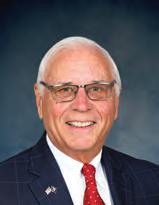
DICK KOPPLIN
Richard (Dick) M. Kopplin, CMAA Fellow, is a partner with Kopplin, Kuebler and Wallace, a private club industry executive search and consulting firm. You can reach Dick via email: dickopplin@aol.com
It was a hot, humid August Saturday night in St. Paul, MN, and the club was hosting the wedding reception for the daughter of one of our most prominent members.
The father of the bride had asked me two weeks earlier to make sure the air conditioning units were serviced and working properly, which I failed to do. And then it went from bad to worse.
Three of my best dining room servers were in a car accident on the way to the club. While they only had minor injuries, they were unable to work. Our executive chef had called in sick, and while we had a fairly good culinary team, our club member had made it clear that he wanted Chef Bob to oversee the dinner preparation.
The pre-dinner outside cocktail reception was hastily moved inside to the grill lounge bar when a severe thunderstorm with pouring rain and high winds demolished the tented patio area. Wedding guests mixing with the golfers who had fled the storm to the shelter of the lounge did not make for a pleasant scene.
The wedding dinner was poorly executed because of a lack of staff and poor communication with the culinary team and because it took place in the dining room, where the temperature was almost 90 degrees; in short, a total disaster. I wanted to hide in my office for the rest of the evening. Before leaving, the club member said he would be calling me to “discuss” how the evening went.
Mr.
Rosenbaum said,
I
answered, “Yes.”
I called while Mr. Rosenbaum was observing me, and I listened to a rather severe critique of the wedding reception. I agreed with every point Mr. Robbins made and apologized as best I could, and we obviously made a significant adjustment on the final bill.
Mr. Rosenbaum then schooled me on a very important business tactic: always return calls immediately, not the next day, not even at the end of the day, but immediately. It was a great lesson learned and one I shared on a regular basis with our management team at that club and every club I managed.
One of my previous assistant club managers, who now owns a very successful real estate company, shared with me what he believes were the two most valuable lessons he adapted from his time working
“Dick, do you see that pencil on the floor?”
And then he said, “Either you pick up the pencil or don’t pick up the pencil. You don’t try to pick up a pencil!
And you don’t try to call someone. Now, here is Mr. Robbins’ home phone number. I know that he is waiting for your call. Dial the number now!”
On Monday morning, my assistant told me Mr. Robbins, true to his word, was on the line and wanted to talk to me. I told her to tell him I would call him back when I finished my meeting. I didn’t call him back. On Tuesday, he called for me again and I didn’t call him back. Wednesday and Thursday he didn’t call. Friday he called for me and I didn’t call him back.
Saturday at 9 a.m., our club president, Mr. Rosenbaum, walked into my office for our weekly meeting. Immediately after sitting down in front of my desk he said, “Dick, I understand Mr. Robbins has been calling you repeatedly regarding his daughter’s wedding reception last Saturday. Is that correct?” I responded, “Well, yes that is true, and I have been trying to call him back.” Without hesitation, Mr. Rosenbaum said, “Dick, do you see that pencil on the floor?” I answered, “Yes.” And then he said, “Either you pick up the pencil or don’t pick up the pencil. You don’t try to pick up a pencil! And you don’t try to call someone. Now, here is Mr. Robbins’ home phone number. I know that he is waiting for your call. Dial the number now!”
with me in the club business: 1) Always be 15 minutes early and 2) Always return phone calls immediately. Jeff told me his clients always remark on how he always arrives before they do when viewing a home. But he said they are even more impressed with how responsive he is and how he calls them back so quickly.
I will always be grateful for the lesson Mr. Rosenbaum gave me, and the metaphor is even more relevant today. Either you pick up the pencil or you don’t pick up the pencil. You don’t try to pick up the pencil. This much I know for sure! BR






Think

If your club accounting and POS software is 7, 10 or even 15 years old, you may be thinking of making a change. So were many of our club clients, who hired us to help them make that decision. Surprise! After a thorough needs assessment, 7 of 10 clubs decided to retain and improve their existing software. Money saved. Business interruption avoided. To learn more, contact us.
400+ CLUB CLIENTS - 30 YEARS OF EXPERIENCE. Thinking of


(561)281-0459 • bboothe@boothegroup.com www.boothegroup.com
(561)281-0459 • bboothe@boothegroup.com www.boothegroup.com




































Michael Azeez, board member, Frenchman’s Creek Beach and Country Club, Palm Beach Gardens, FL
Jarrett Chirico, director of racquets, Royal Oaks Country Club, Dallas, TX
Frank Cordeiro, GM/COO, Colonial Country Club, Fort Worth, TX
Tony D’Errico, GM/COO, Quail West Golf and Country Club, Naples, FL
Diane Exter, president, Frenchman’s Creek Beach and Country Club, Palm Beach Gardens, FL
Bill Howard, GM, Bel-Air Bay Club, Pacific Palisades, CA Marius Ilie, GM/COO, Glen Oaks Club, Old Westbury, NY
Bonnie J. Knutson, PhD, member of the Country Club of Lansing and the Michigan Athletic Club.
Marty Krall, board member, Frenchman’s Creek Beach and Country Club, Palm Beach Gardens, FL
Jill Kremer, board member, Frenchman’s Creek Beach and Country Club, Palm Beach Gardens, FL
Nancy Levenburg, Ph.D., member of Spring Lake Country Club, Spring Lake, MI
Ellen Malasky, board member, Frenchman’s Creek Beach and Country Club, Palm Beach Gardens, FL
Rob Martin GM/COO Wycliffe Country Club in Wellington, FL
Michael McCarthy, CEO, Addison Reserve Country Club, Boca Raton, FL
Dave Moyer, director of racquet sports, The Country Club at DC Ranch, Scottsdale, AZ
Alan Raulerson, GM/COO, Wilderness Country Club in Naples, FL
Kevin Reynolds, President, Westwood Country Club, Vienna, VA
Angelo (Angie) Rossi, President, Quail West Golf and Country Club, Naples, FL
Larry Savvides, GM/COO, Hunters Run Property Owner’s Association, Boynton Beach, FL
Robert Sereci, GM of Medinah Country Club
Bob Sherer, board member, Frenchman’s Creek Beach and Country Club, Palm Beach Gardens, FL
Michael H. Soroka, President, Hunters Run Property Owner’s Association, Boynton Beach, FL
Bryan Stone, GM/COO, Westwood Country Club, Vienna, VA
Miles Tucker, president, Frenchman’s Creek Beach and Country Club, Palm Beach Gardens, FL
Jordan Ziegler, president, Glen Oaks Club, Old Westbury, NY


